A Green Six-pack
In this post, we give a shout-out to six plants that deserve attention. If you’re designing, growing, or sourcing plants for green infrastructure—especially stormwater projects—these plants should be on your list.
Read Post
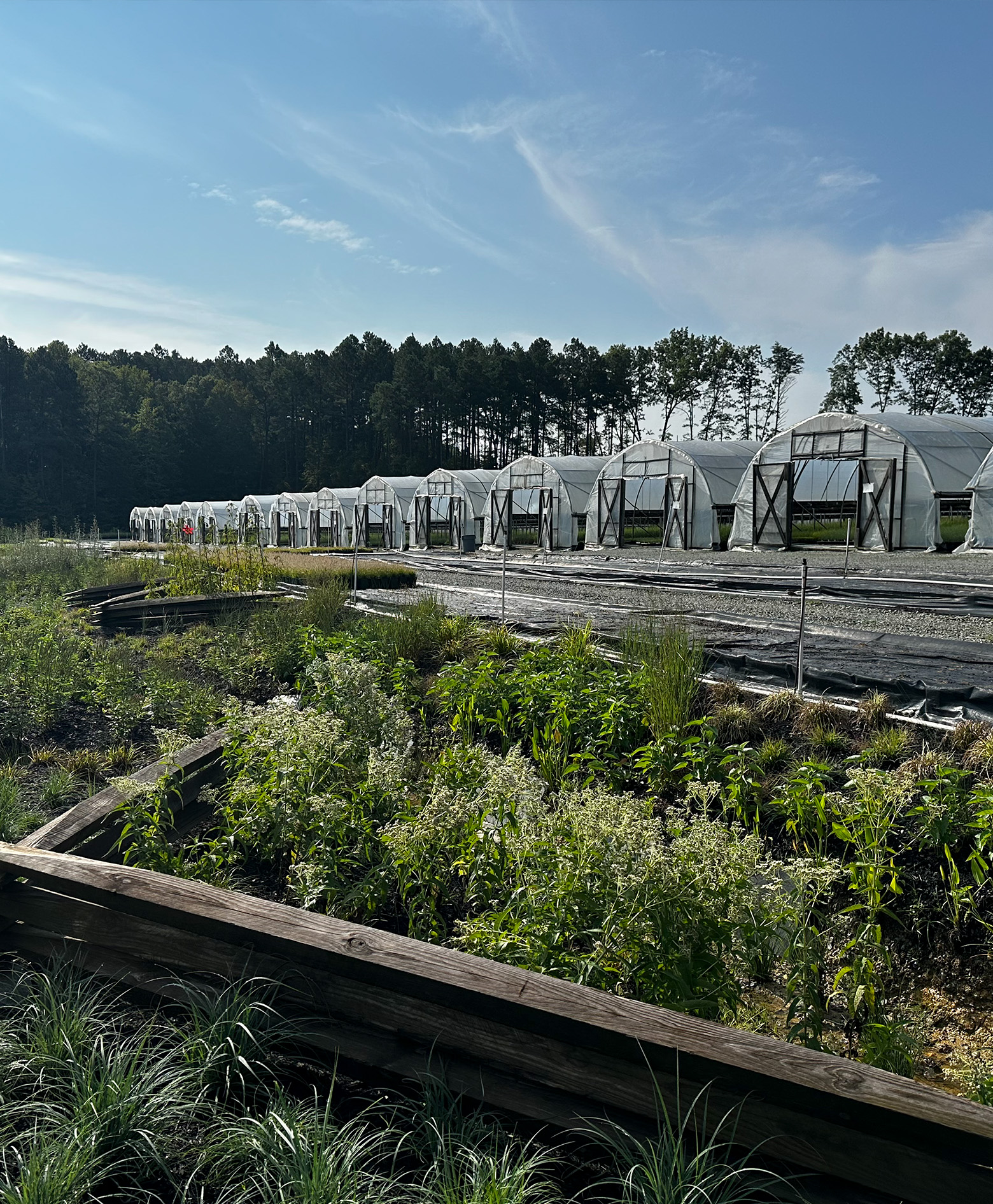
Green infrastructure (GI) uses natural features to manage stormwater. Grasses, sedges, and a multitude of other plants play a significant role GI, their incorporation into projects like rain gardens, green roofs, meadow plantings (just to name a few!) promote biodiversity, enhance resilience to climate change, and helping in creating cleaner, healthier places to live. They also hold a key to broader industry trends: low-maintenance landscaping. problem-solving with plants, and planting with a purpose beyond the visual.
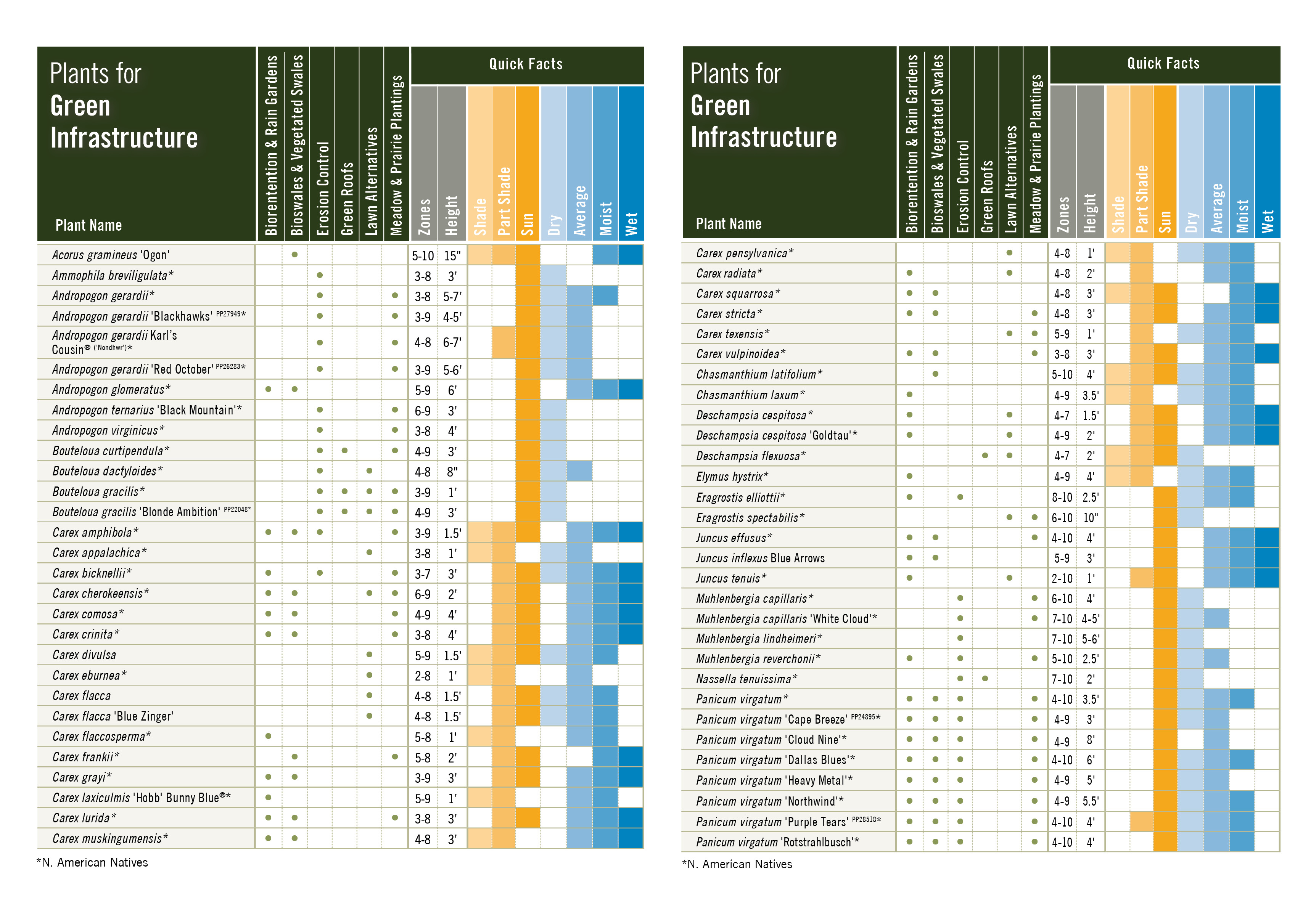
That’s where our Plants for Green Infrastructure chart can help.
We’ve selected typical green infrastructure features in use today, and noted grasses, sedges, and rushes that should perform well in those growing environments. If you’re not familiar with these features, see descriptions here. The GI field is constantly changing and there may be other grasses and sedges that will work, but this is a great starting point for narrowing down choices.
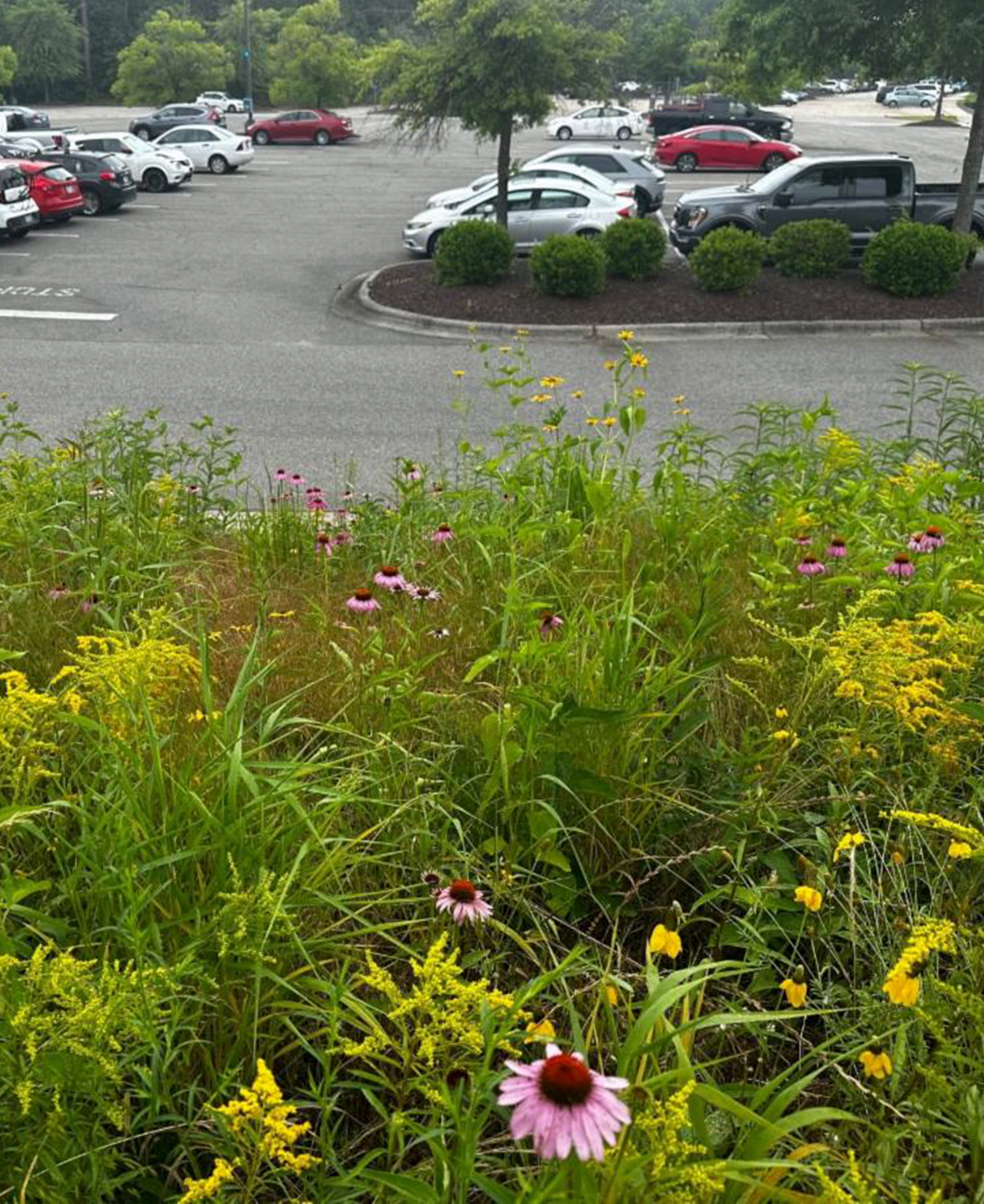
Native Plants for Stormwater Projects
A few years ago, Hoffman Nursery and others worked with North Carolina’s stormwater program to add new plants, including grasses and grasslike plants, to the NC Stormwater Design Manual. To help the selection process we’ve created a chart of plants from the manual that we grow, together with a few others we recommend for bioretention and stormwater wetlands.
Click here to download a copy of our full GI guide.
Need more?
Call 1-800-203-8590 or email sales@hoffmannursery.com. We’d love to help! And be on the lookout for more exciting GI news coming soon.

The Importance of Managing Stormwater Runoff

As environmental stewards, we understand the importance of managing stormwater runoff as a critical aspect of water quality – at the nursery and beyond. At our 45-acre main nursery, we capture, filter, and store precipitation to irrigate our grasses, sedges, and rushes in cold frames, greenhouses, and stock beds. We use a combination of grey and green infrastructure SCMs (stormwater control measures) to convey stormwater runoff, including gutter-connected greenhouses, ditches, retention ponds, bioswales, and vegetated swales, all of which help to maintain high water quality onsite. Stored water from our ponds goes through our water treatment system to deliver high-quality water nursery-wide.

Hoffman Nursery’s Water Treatment System
Here’s a quick overview of our water treatment system’s process and delivery:

The Importance of Water Quality in Plant Production
Water quality is a critical factor in ornamental grass production as it directly affects the plants’ health, growth, and overall quality. The following key aspects summarize its significance:
Plant Growth and Development
Nutrient Uptake
Prevention of Diseases
Minimizing Stress
Reducing Salinity Issues
Aesthetic Quality
Efficient Watering Practices
Consistent Crop Performance
Sustainability Considerations

Excellent water quality is vital to our grass, sedge, and rush production. Regular testing, proper treatment, and water quality monitoring are essential practices here at Hoffman Nursery. It influences plant health, from nutrient uptake to disease prevention, and promotes our plants’ overall consistency, quality, and value. These extra steps help us go the extra mile in producing premium plants for our customers while being eco-conscious and sustainability minded.
Note: Some of the key aspects of water quality in plant production content were generated through a Chat GPT/Open AI conversation in March 2024.
Exposure to salts, either in coastal environments or along roadsides, can stunt growth and even kill plants. Many of the grasses we grow can tolerate exposure to salts, especially species native to coastal areas. Based on several sources, the grasses and sedges below are reported to be salt tolerant. Other grasses and sedges may do well, too, but these are ones that have been identified as more tolerant.

The following grasses were rated highly on salinity tolerance and recommended for use as low-growing grasses along highways in Maryland:
Because conditions vary widely, there are no guarantees. We advise trying a test planting first to determine whether these or other plants will do well in the conditions you have.
Download our PDF of salt tolerant grasses
References:
Identification of Low Growing, Salt Tolerant Turfgrass Species Suitable for Use along Highway Right of Way, University of Maryland Center for Environmental Science and Maryland Department of Transportation (2016), Salt Tolerant Perennials, The Green Mountain Gardener, University of Vermont Extension (accessed 2/20/18), Salt Tolerant Plants for the South Carolina Coast (HGIC 1730), Clemson Cooperative Extension (2017), Salt Tolerant Plants Recommended for Pender County Landscapes, North Carolina Cooperative Extension, Urban Horticulture Leaflet 14 (accessed 2/20/18), Winter Salt Injury and Salt Tolerant Landscape Plants (A3877), Cooperative Extension of the University of Wisconsin Extension (2009), eHALOPH – Halophytes Database, The University of Sussex (accessed 2/20/18), Salt-Resistant Perennial Plants, Cooperative Extension of Ocean County (2013)
PRESS RELEASE: For Immediate Release
Contact: Alex Stanley-Stretch ǀ Marketing Coordinator
919-479-6620 ǀ alexstanley@hoffmannursery.com
Hoffman Nursery Announces Sales Team’s Stormwater Certification
Hoffman Nursery is pleased to announce Stephen Gillis (Sales and Customer Service Manager), Jessica Hall (Sales and Customer Service Representative), and Sami Nickerson (Sales and Customer Service Representative) have obtained their Stormwater SCM Inspection and Maintenance certification from North Carolina State University (N.C. State).
Communities across North Carolina must manage stormwater with Stormwater Control Measures (SCMs) such as wet and dry retention ponds, bioretention areas, swales, and stormwater wetlands to slow, filter, and direct stormwater runoff. These SCMs must have annual, and sometimes more frequent, inspections and maintenance to perform as intended. This certification provides an understanding of stormwater and its effects on water quality and covers the use, function, regulations, inspections, and maintenance of SCMs in North Carolina.
Because many SCMs use vegetation (green infrastructure) that is specified in the North Carolina Department of Environmental Quality’s Stormwater Design Manual, Hoffman Nursery set a goal for all members of our sales team to earn this certification. They are excited to have met this goal and be able to better assist their customers with plant selections for green infrastructure measures.
“We are committed to investing in our employees and thrilled that our sales team has received this certification,” says David Hoffman, Chief Operating Officer at Hoffman Nursery. “Our core purpose is to promote better living through plants, and we are thankful for our employees’ commitment to making our world a greener place.”
Stephen Gillis is a biogeographer by training and has a bachelor’s degree in geography and an M.S. in Environmental Science from the University of Idaho. Stephen has worked in sales and customer service his entire career and has been with Hoffman Nursery since 2019. Jessica Hall has a Bachelor of Science in Horticulture from Clemson University and has worked in the industry for over twenty years. She has experience in growing, research, propagation, production, design, and sales. Jessica joined Hoffman Nursery in 2018. Sami Nickerson is a graduate of North Carolina State University, also with a Bachelor of Science in Horticulture. She’s worked in sales for 4 years, joining Hoffman Nursery in August 2022.
For more information about N.C. State’s stormwater workshops and certifications, visit Workshops & Conferences (ncsu.edu). To see the North Carolina Department of Environmental Quality’s Stormwater Design Manual, visit Stormwater Design Manual | NC DEQ.
####
About Hoffman Nursery, Inc.: Founded in Rougemont, North Carolina in 1986, Hoffman Nursery specializes in ornamental and native grass liners for the wholesale trade. With a core purpose of promoting better living through plants, they grow over 140 species and cultivars of grasses, sedges, and grasslike plants and ship to wholesale customers across North America. Since its founding, the nursery has expanded to include a state-of-the-art greenhouse and production facility, an 83-acre stock farm, and over 60 cold frames and hot houses.
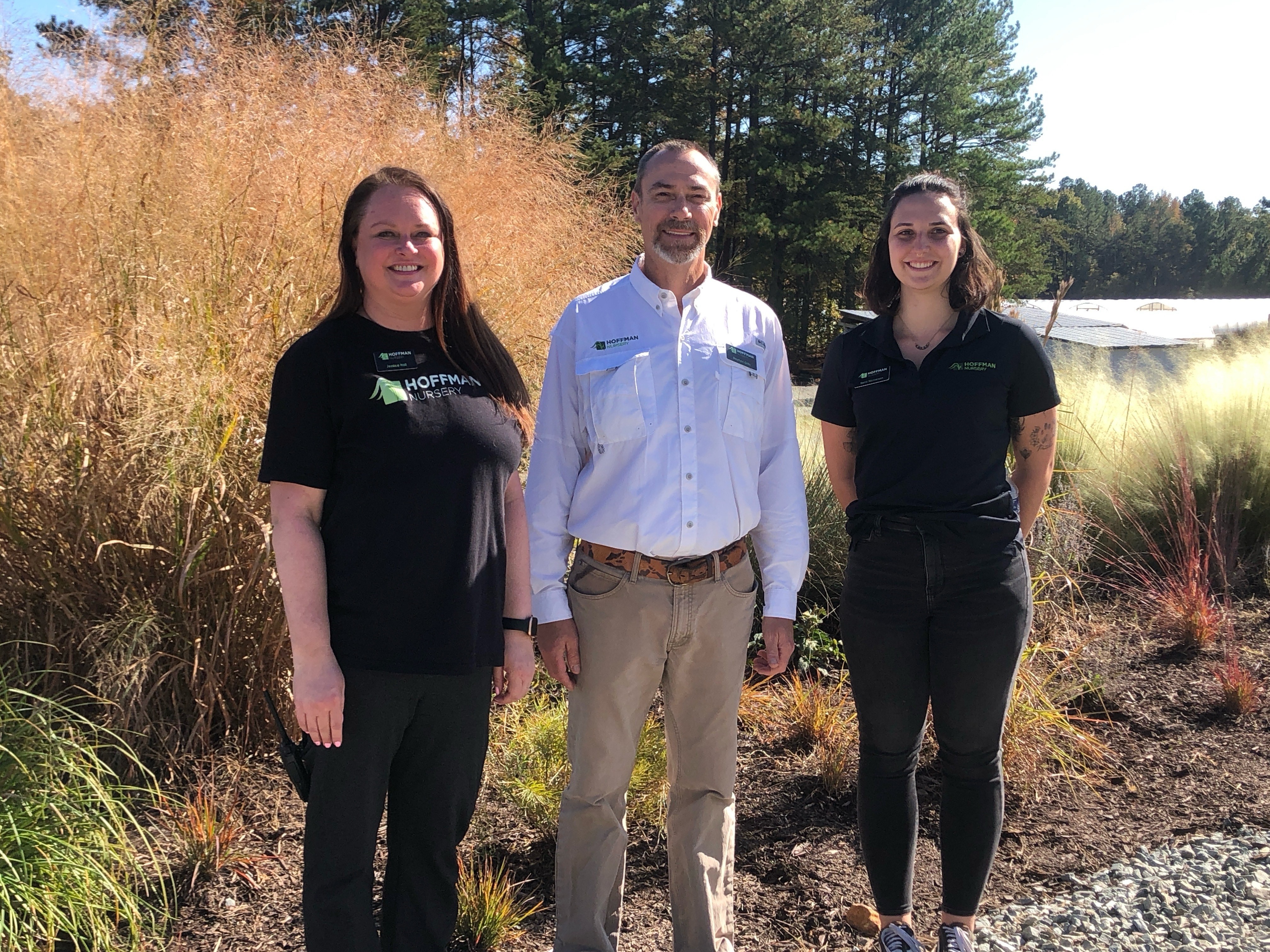
PRESS RELEASE - For Immediate Release
Contact: Alex Stanley-Stretch ǀ Marketing Coordinator
919-479-6620, alexstanley@hoffmannursery.com
Hoffman Nursery Receives Gold Star Grower Housing Award
Hoffman Nursery, located in Rougemont NC, was among the four growers in North Carolina recognized during the 30th Annual Gold Star Growers Meeting held February 1st, 2024, at the McKimmon Center in Raleigh.
The North Carolina Department of Labor’s Gold Star Grower Housing Program identifies growers who provide housing that meets and exceeds all requirements of the Migrant Housing Act of North Carolina. The housing standards are required by law and used during annual inspections performed by the Department of Labor’s Agricultural Safety and Health Bureau. Over 1,800 houses are inspected yearly, and four awards are given statewide: two for “best maintained housing” and two for “best new housing.” Hoffman Nursery received one of the Best New Housing Awards and a Double Gold Star Award for perfect H-2A program compliance two years in a row. The H-2A Temporary Agricultural Workers Program, often referred to as H-2A, helps American farms and nurseries fill seasonal employment gaps by hiring workers from other countries. Craig Reynolds, Hoffman Nursery’s Senior Director of Operations, presented during the meeting, highlighting the nursery’s H-2A program and the amenities the nursery housing has to offer.
Founded in 1986, Hoffman Nursery specializes in ornamental and native grass liners for the wholesale trade. With a core purpose of promoting better living through plants, they grow over 140 species and cultivars of grasses, sedges, and grasslike plants and ship to wholesale customers across North America. Since its founding, the nursery has expanded to include a state-of-the-art greenhouse and production facility, an 83-acre stock farm, and over 60 cold frames and hot houses. Hoffman Nursery has 43 full-time employees and 28 H-2A workers. Hoffman Nursery contracts its H-2A program through Legacy Labor in Cadillac, Michigan.
For more information about the Gold Star Program, and award requirements, visit https://www.labor.nc.gov/safety-and-health/recognition-programs/gold-star-grower-program.
####


At Hoffman Nursery, we believe in plants that solve problems. In parts 5-8 of our “Solving Regional Problems with Plants” series, Sami Nickerson from our Sales & Customer Service team takes a look at some of the environmental challenges in the Southwest, Great Plains, Midwest, and Eastern Canadian regions of North America, and how the plants on our Regional Plant Lists help in solving these issues.
If you missed parts 1-4, where we covered the Northeast, Mid-Atlantic, Southeast, and Coastal South regions, they are available here.




|
 ’
’ ’
’ ’
’ ’
’
Grasses complement any space and style. They add texture, movement, color, and year-round interest to the landscape. Whether you are new to the world of grasses or just want a refresher on the basics, this post gives you a few best practices for growing, planting, and managing your grasses.
Compared to many ornamental plants, grasses need few inputs to perform well. While each grass is different, there are some general guidelines when using them. If you would like specifics about a particular plant, visit our individual plant profiles.



For more information on caring for and using grasses, check out our Learn section.
One of our favorite seasons is just around the corner, and we’re so excited! No, we’re not talking about the holidays (although we do love the holiday season). It’s time to start thinking about cool-season crops. Coming this month, January, and February fresh liners of cool-season favorites will be ready to ship. And just like holiday shopping, you’ll want to get your orders in early!

If you haven’t already reserved your cool-season plants, now’s the time. Several cool-season selections are made in limited quantities, and when they’re gone, they won’t be back until 2025. And several varieties must be shipped before the temperatures ramp up in early summer.
If you’re not as familiar with cool-season plants, take a moment to check out our online resources. If you’re in nursery or greenhouse production, check out our page on container production. It offers an excellent overview of their growth processes, cultural requirements in containers, and tips on how to avoid trouble spots.
If you’re using cool-season grasses in landscape designs, you’ll find a section on them on our Grasses in the Landscape page. It includes a description of their growth cycle and a handy comparison chart showing how they differ from warm-season grasses. We also have great pages devoted to Carex and Calamagrostis. To help pick your selections, see the plant profiles for all the sedges and cool-season grasses we grow on our website.
Cool-season plants offer unique advantages that can boost sales and brighten landscapes. Now that you’re as excited about them as we are, don’t delay. Find crop ready dates using our current availability, and email our sales team to place your order now.
.jpg)
Why overwinter grasses? By overwintering cool-season grasses, you’ll be ready for early spring customers. You can get a head start on finishing warm-season grasses when they are overwintered in a cold frame or hot house. Annual grasses overwintered in a hot house allow you to have full plants with good color at the earliest possible time. Here are five useful tips to consider.
Tip #1
Keep containerized grasses on the dry side. During winter, warm-season grasses go dormant, and cool-season plants slow their growth, so their water needs are minimal. Grasses are susceptible to rotting and root damage if overwatered.
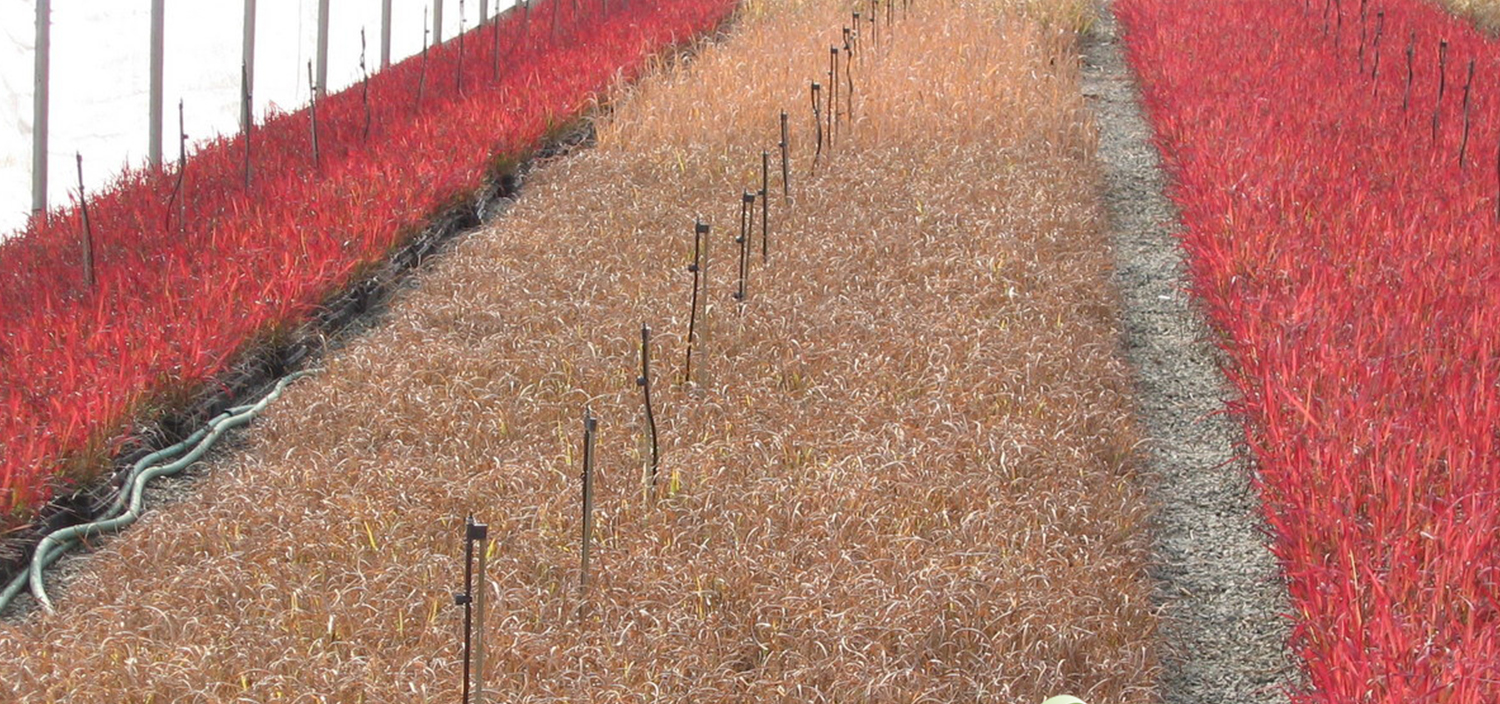
Tip #2
Cool-season grasses work well in a cold frame or in a house kept just above freezing.

Tip #3
Do you have a hot house? If so, get a head start with annual grasses. The colorful, tender Pennisetum selections are in demand early in the season—perfect for decorative containers and annual color beds.
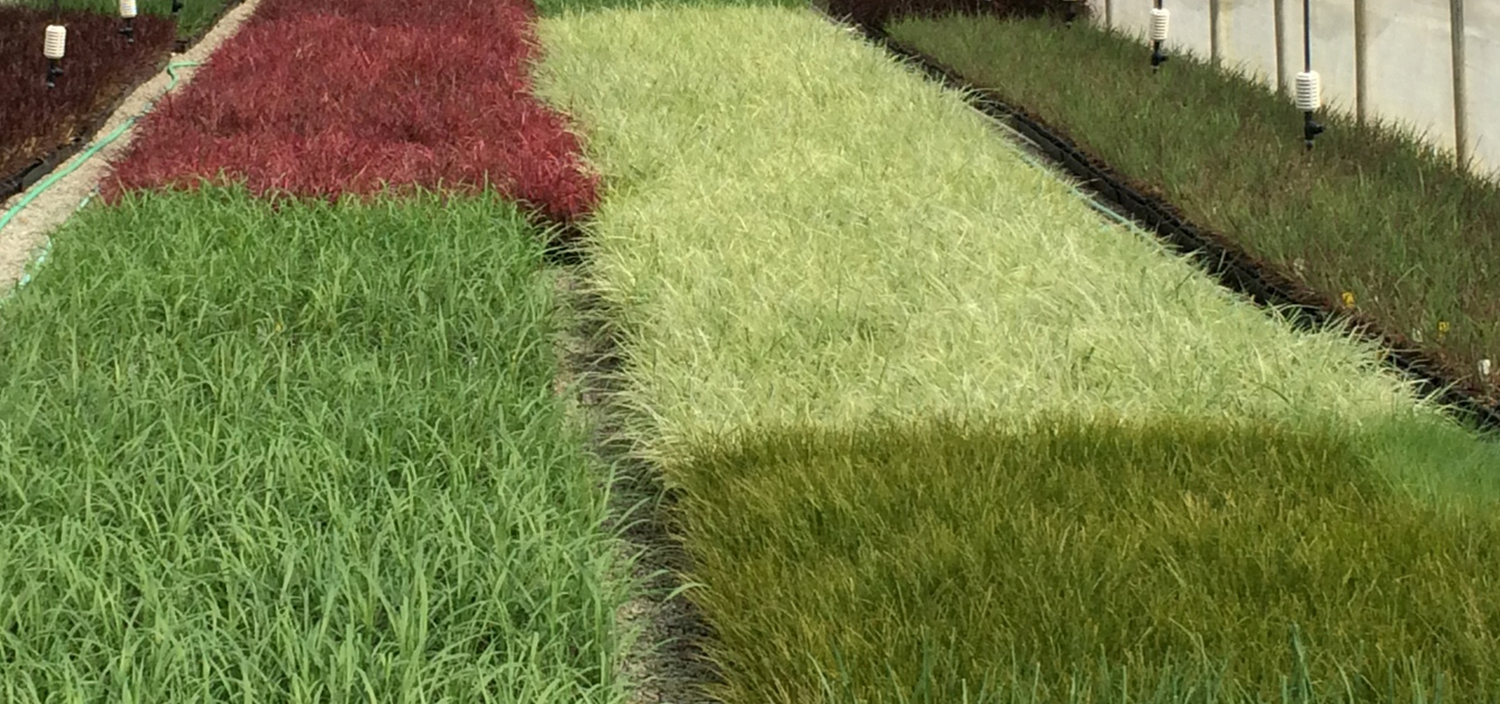
Tip #4
If you overwinter outside, you may need to cover outdoor containers during rainfall or severe cold to prevent rot or damage. Panicum species and cultivars can do well outside of a cold frame with some monitoring.

Tip #5
The majority of grasses, including the popular Calamagrostis, Chasmanthium, Miscanthus, Muhlenbergia, and Schizachyrium overwinter best in a cold frame.

For more growing help, see our Container Production page. For a broader look at all aspects of grasses and sedges, visit our Learn section. Happy successful winter growing!
As disruptive natural events become more common, there is an increased need for communities to recover quickly and regenerate. Working with nature – instead of against it – to build resilient landscapes provides a foundation for recovery and regeneration that can improve human and ecological health. Our first post in this six-part series defined a resilient landscape, the framework to build one, and how grasses, sedges, and rushes fit into these plantings. If you missed that post, check it out here. In our final post, we will discuss fire.
Fire is a crucial part of forest and grassland health and a critical disturbance in particular areas. As climate changes, some regions become hotter and drier, and drought reduces the moisture in the air and soil; wildfires have intensified throughout North America. Finding the balance between using fire as a management tool to safely restore fire-dependent ecosystems while implementing fire-resistant landscaping can be difficult. Historically, our grasslands, prairies, and other fire-dependent ecosystems burned regularly – from lightning strikes but also by Indigenous peoples to clear land, improve grazing habitat, and forage for game, and for defensive reasons. Over time, as our fire-dependent ecosystems diminished and people moved into the Wildland-Urban Interface, areas that burned became fire-suppressed areas as losses from fire grew. Fire removes flammable fuel in the form of dead leaves, foliage, and branches. Fire adds nutrients to the soil, and, by warming up the soil, increases microbial activity, which releases nutrients and helps the seeds of some plants to grow. Additionally, regular prescribed burns reduce the amount of woody shrubs and invasive species and help native plants to grow. Prescribed fire can also improve and increase food and cover for wildlife, as new growth flushes after fires and attracts grazing animals. Butterflies, moths, and other pollinators benefit from fire as wildflower diversity increases after fires, providing food and structure these organisms need at different times of the year. Endangered birds also benefit from prescribed burns in fire-dependent ecosystems.
The tragic loss of life, homes, and business from wildfire cannot be understated or minimized. Smoke from distant fires can also affect air quality and respiratory health locally and underscore the importance of Firewise or fire-resistant landscaping design and management practices. These design principles and practices create defensible spaces – areas extending 100 feet outwards in all directions from structures that serve as a buffer designed to slow and stop wildfire. Plant selection, placement, maintenance, and the use of native plants are critical components of Firewise or fire-resistant landscapes – components echoed in a central design principle of resilient landscapes of having the right plant in the right place at the right time and incorporating a maintenance plan.

Fire can be used as a management tool in some locations to restore grassland health and encourage native warm-season grass growth and spread. Firewise and fire-resistant design creates defensible spaces around structures to minimize the risk of damage or loss associated with fire. Recognizing the challenges and sometimes tensions between the use of these two management tools is a way forward to creating resilient landscapes that incorporate the ‘and strategy’ – spaces that have multiple layers of protection. These landscapes use fire restoratively and design protectively from fire. They provide small- and large-scale solutions, that provide ecological and human benefit. Grasses provide the fine fuel source that helps fire move through the landscape. Some native grasses have evolved with fire, while some non-native and invasive grasses increase fire danger and affect frequency and intensity. The below selections represent grasses that have adapted with fire and can be used in designing and maintaining Firewise landscapes.
Try these grasses:
Eragrostis spectabilis (Purple Love Grass)
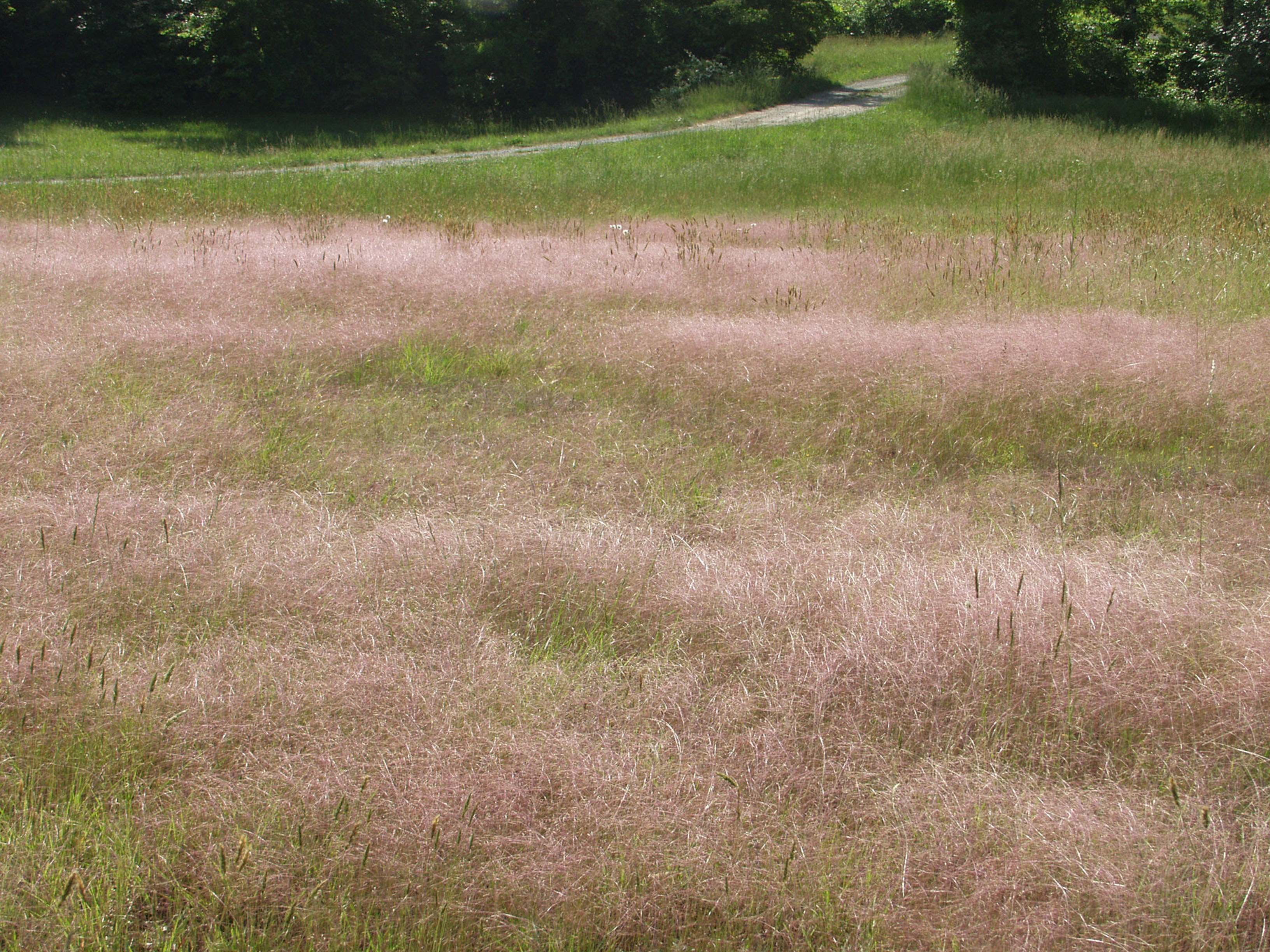
Andropogon ternarius (Split beard bluestem)

Sorghastrum nutans ‘Indian Steel’ (Blue Prairie Grass)

If you missed our earlier blog posts in this series, click here to check them out. Now let’s do what we can to work with nature instead of against it and come back stronger after disruptive natural events. Let’s build more resilient landscapes.
Controlled Burns: Pros and Cons (treehugger.com), Wildfire and Climate Change | U.S. Geological Survey (usgs.gov), AG-874 Fire Resistant Landscaping (resistwildfirenc.org), Firescape Demonstration Garden | ASLA Climate Change Exhibition, Fire Smart Landscaping - Ready for Wildfire, Home page, Fire Effects Information System (feis-crs.org), 93415.pdf (ucanr.edu), Resilient Design | asla.org, Restoring Fire to Native Grasslands | The Nature Conservancy were used as sources for this post.
As disruptive natural events become more common, there is an increased need for communities to recover quickly and regenerate. Working with nature – instead of against it – to build resilient landscapes provides a foundation for recovery and regeneration that can improve human and ecological health. Our first post in this six-part series defined a resilient landscape, the framework to build one, and how grasses, sedges, and rushes fit into these plantings. If you missed that post, check it out here. Below, we examine and discuss solutions for landslides.
Landslides primarily occur when heavy rains, earthquakes, or volcanoes destabilize soil on steep slopes, causing them to crumble. Landslides are damaging and deadly and can easily occur anywhere in the U.S. and Canada. Soil is a precious resource, and keeping it where it belongs is important for any landscape. Runoff from steep slopes, banks, and impermeable surfaces can degrade the landscape, trigger erosion, and cause landslides. While you might be unable to prevent landslides, using native plants in your landscape could help lower the risk or decrease the damage.
Native plants, in particular grasses and sedges, help stabilize soil and reduce erosion, especially on banks and slopes. Their branching, fibrous root systems hold the soil in place while increasing water infiltration and improving drainage. Their dense crowns and abundant foliage slow and filter runoff, reducing the sediment and pollutants that flow into waterways. Below, we feature three grasses that hold their ground while adding interest to the landscape.
Try these grasses:
Bouteloua dactyloides (Buffalo Grass)

Chasmanthium latifolium (River Oats)

Panicum virgatum & cvs. (Switchgrass)

The species listed need little maintenance, and are quick to establish, which can be critical on steep inclines, large embankments, or uneven ground. To see our full list of plants for erosion control, click here. Tune in on November 6th as we conclude our series with fire.
Resilient Design: Landslides | asla.org and Sloped Land 101: Preventing Landslides - LandCentral were used as sources for this post.
As disruptive natural events become more common, there is an increased need for communities to recover quickly and regenerate. Working with nature – instead of against it – to build resilient landscapes provides a foundation for recovery and regeneration that can improve human and ecological health. Our first post in this six-part series defined a resilient landscape, the framework to build one, and how grasses, sedges, and rushes fit into these plantings. If you missed that post, check it out here. Below, we examine and discuss solutions for the most frequent natural disaster, flooding.
Flooding is often a localized event and can result from precipitation events, storm surge in coastal areas, or stormwater runoff from surfaces like streets, sidewalks and parking lots. Historically, solutions to flooding have utilized grey infrastructure measures alone like installing more and larger culverts, building walls, and channelizing natural waterways. However, these measures are costly and could result in catastrophic failures. So, once again, let’s turn to nature to help provide possible solutions. There are measures and plants that can be put into place to help with flooding.
Green Infrastructure/stormwater management measures such as bioretention cells, rain gardens, and bioswales are important components of flood prevention. They work to slow, filter, and direct runoff safely, as well as capture it to increase infiltration and soil moisture. Learn more about these practices below.
Bioretention and Rain Gardens are vegetated, shallow depressions in the ground designed to provide storage, evapotranspiration, and treatment of stormwater runoff. They drain within 24-48 hours and dry out when rain is sparse.
Bioswales and Vegetated Swales are gently sloping channels planted heavily with a variety of species, as opposed to grassed swales, which contain only turfgrass.
Managing stormwater with green infrastructure measures is key to building resiliency and promoting better living in our communities. Grasses, sedges, and rushes work great in these measures and can help provide solutions when it comes to flooding. They have fibrous, branching root systems that help hold soil, improve drainage, and slow water flow. They minimize use but readily take up water when present. They also use water very efficiently and some can withstand prolonged flooding.
Try these plants:

Carex cherokeensis (Cherokee Sedge)

Scirpus cyperinus (Wool Grass)

These are just a few of the plants that can help with flooding. Our Green Infrastructure and Native Plants for Stormwater Charts are great resources for finding other options. Our individual plant profiles provide more information as well. Join us next week for our next stop in this series, landslides.
Resilient Design: Flooding | asla.org was used as a source for this post.
As disruptive natural events become more common, there is an increased need for communities to recover quickly and regenerate. Working with nature – instead of against it – to build resilient landscapes provides a foundation for recovery and regeneration that can improve human and ecological health. Our first post in this six-part series defined a resilient landscape, the framework to build one, and how grasses, sedges, and rushes fit into these plantings. If you missed that post, check it out here. Below, we examine an event that many of us have dealt with this year: Extreme Heat.
2023 has been no stranger to extreme heat. Day after day, throughout the summer and even into the fall, we dealt with some of the hottest temperatures in recorded history. These scorching days imposed widespread health concerns and economic impacts that affected everyday life throughout the country. As we continue dealing with a warming world, using green infrastructure measures and plants that are equipped to handle these harsh conditions can help lower temperatures and build more resilient landscapes.
Three green infrastructure measures to consider when dealing with extreme heat.
If you aren’t familiar with green infrastructure (GI), it uses plants, soils, and natural processes to manage water and add ecological function to new and existing development. The three green infrastructure measures mentioned below can help provide solutions when it comes to coping with extreme heat.
Champions of the Landscape
Grasses, sedges, and rushes can help mitigate extreme heat events by cooling areas and helping to decrease air and surface temperatures through evapotranspiration. They are champions in the landscape! Many grasses and sedges can withstand water scarcity and prolonged dry conditions. They are low maintenance, provide important habitats for wildlife, anchor down soil, help remove pollutants, and increase aesthetic value.
The plants mentioned below are excellent choices when it comes to combating the heat. They also work great in certain green infrastructure (GI) measures.
Try these plants:
Bouteloua gracilis (Blue Grama)
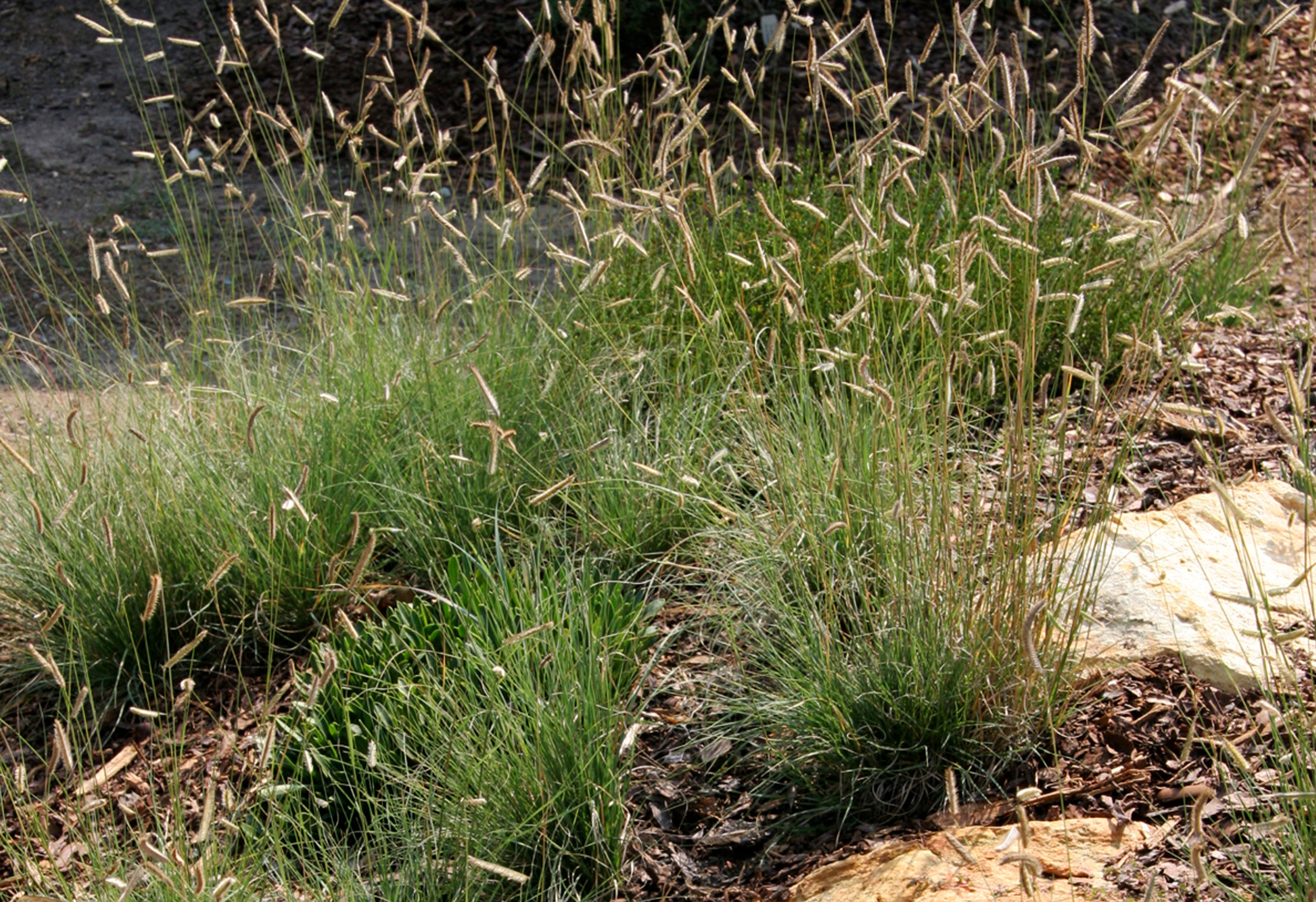

Andropogon glomeratus (Bushy Bluestem)

You can find more information about these and other great green infrastructure plants in the GI section of our website and our Green Infrastructure chart.
Stay tuned next week as we cover resilient solutions for flooding.
Using Green Roofs to Reduce Heat Islands | US EPA and bioswales.pdf (ctc-n.org) were used as sources for this post.
As disruptive natural events become more common, there is an increased need for communities to recover quickly and regenerate. Working with nature (instead of against it) to build resilient landscapes provides a foundation for recovery and regeneration that can improve human and ecological health. At the beginning of our first post in this six-part series, we cover what makes a landscape resilient, the framework to build one, and how grasses, sedges, and rushes fit into these plantings. If you missed that post, check it out here. Then meet us back here for part two (below) that covers Drought.
Our region, the Southeast, generally receives substantial precipitation and is often considered water-rich. However, droughts are not uncommon. The Southeast has a long history of multi-year droughts, including the recently experienced record-breaking droughts of 2006–2008 and 2010–2012. A bigger picture of the United States, this past summer, showed drought expanding and intensifying, influenced mainly by not only a lack of precipitation but also extreme heat and evaporative demand. These droughts had far-reaching impacts on agriculture, water availability for municipalities and industry, and wildfires.
Using plants that are drought tolerant and have low water needs are smart choices. Drought tolerant plants do not need supplemental irrigation and can withstand periods of water scarcity and prolonged dry conditions (once established). Low water use plants have adapted to water scarcity, use water efficiently, and continue to look good in times of water scarcity (once established). Drought tolerant and low water use plants conserve water usage while still providing beauty and function in the landscape.
Try these plants:

Muhlenbergia capillaris (Pink Muhly Grass)
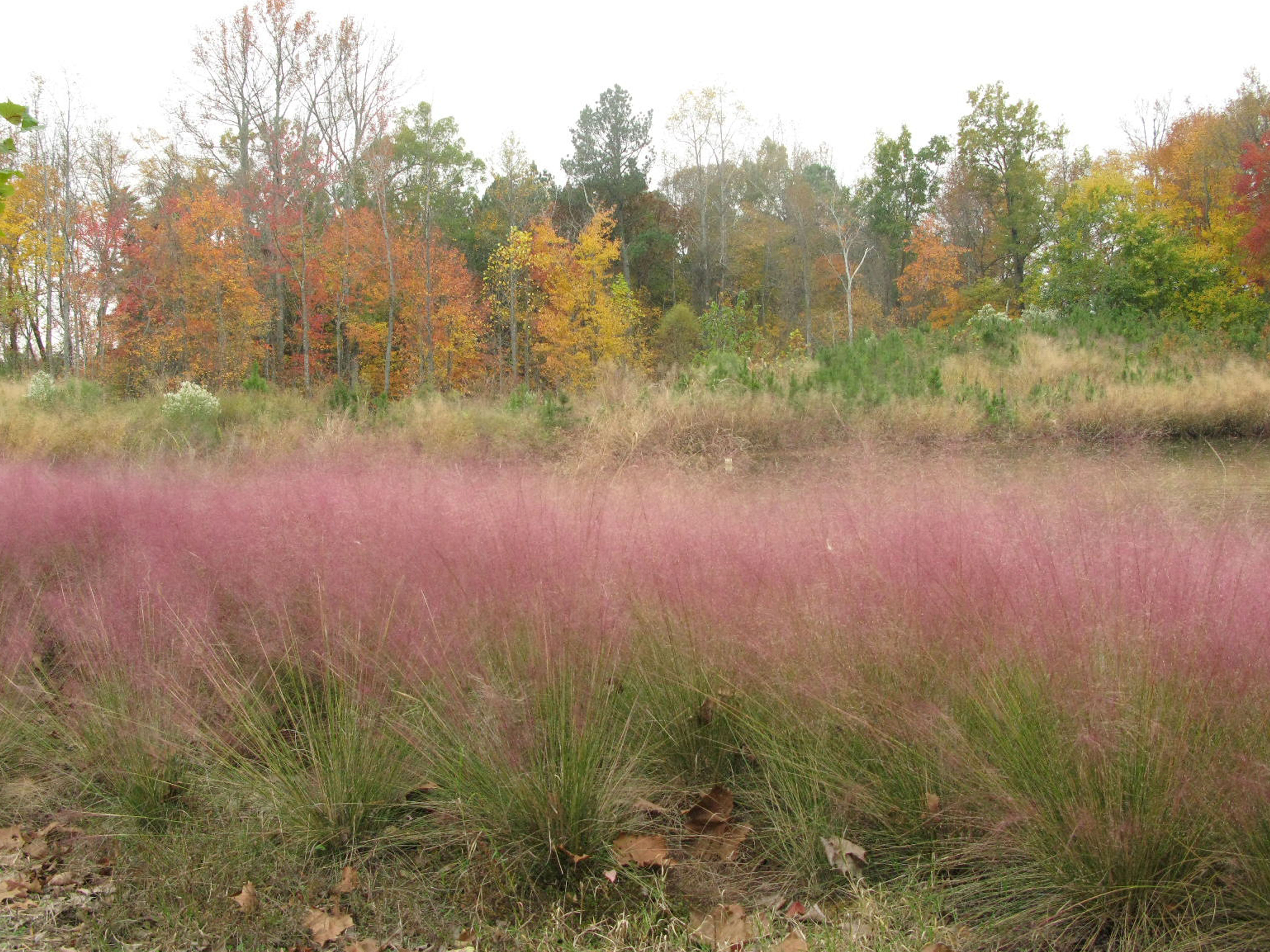
Sporobolous wrightii (Giant Sacaton Grass)

As unpredictable droughts continue to be a concern, using low-water use and drought tolerant grasses, sedges, and rushes helps conserve water and create more resilient landscapes. If you are interested in our full list of drought tolerant and low water use plants, check out this handy PDF.
Be on the lookout over the next few weeks as we continue to cover resilient solutions for extreme heat, fire, flood, and landslides. Our first post was on loss of biodiversity; if you missed it, you can find it here.
North Carolina | Drought.gov and Summer 2023 in Review: A Look Back at Drought Across the U.S. in 10 Maps | September 21, 2023 | Drought.gov were used as sources for this post.
As disruptive natural events become more common, there is an increased need for communities to recover quickly and regenerate. Working with nature (instead of against it) to build resilient landscapes provides a foundation for recovery and regeneration that can improve human and ecological health.
A resilient landscape is an adaptive, forward-looking framework that works with nature to design and retrofit communities, and spaces to recover quickly and provide solutions from extreme events such as loss of biodiversity, drought, extreme heat, fire, flooding, and landslides.
Resilient landscapes consist of:
Layered plantings help to build a plant community, which is functionally and aesthetically important for resilient landscapes. Grasses, sedges, and rushes fit perfectly into these plantings. They represent all height levels in a layered planting, provide multi-season interest as a function of their growth cycle, and are low maintenance. Their fibrous root systems anchor soil, slow down water flow and increase infiltration. They help remove pollutants, offer habitat, and many are well-adapted to the demands of these extreme events and even provide additional nature-based solutions.
In this 6-part blog post series, we examine each of these extreme events and recommend grasses and sedges that work well in resilient landscapes. Our first post covers loss of biodiversity.
Loss of Biodiversity
Biodiversity, which is short for biological diversity, is a term used to describe the variety of life found on Earth and the relationships between living organisms, ranging from bacteria and viruses to plants and animals. Unfortunately, there is a global loss of biodiversity but we can build help resiliency in landscapes by selecting grasses, sedges, and rushes that support biodiversity.
Grasses and sedges support biodiversity by providing nectar and pollen sources and larval hosts for some pollinators. They also provide nesting material, nesting sites, food, and cover for birds and small mammals.
Try these plants:
Carex pensylvanica (Pennsylvania Sedge)

Schizachyrium scoparium & cultivars (Little Bluestem)
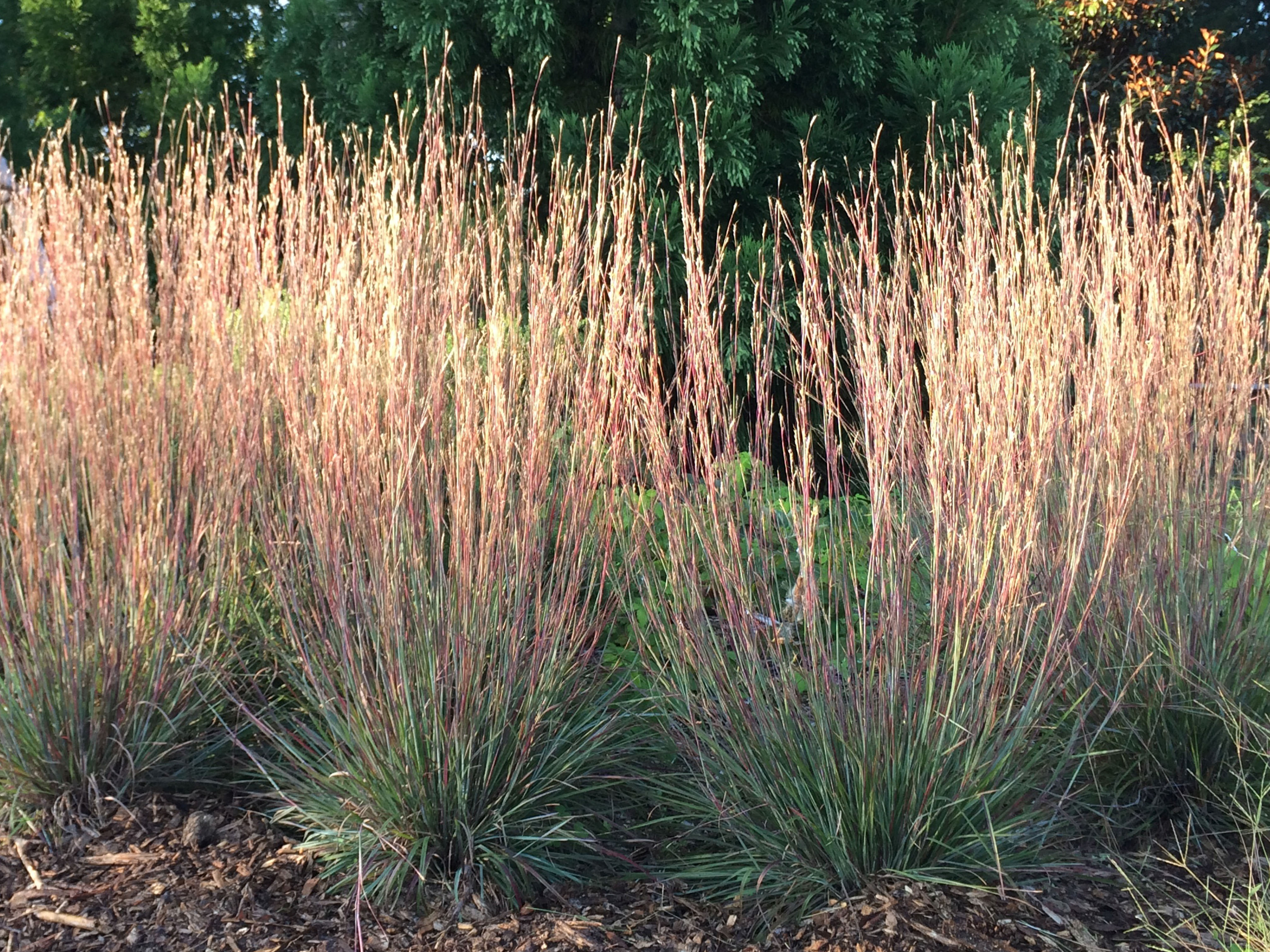
Andropogon gerardii (Big Bluestem)
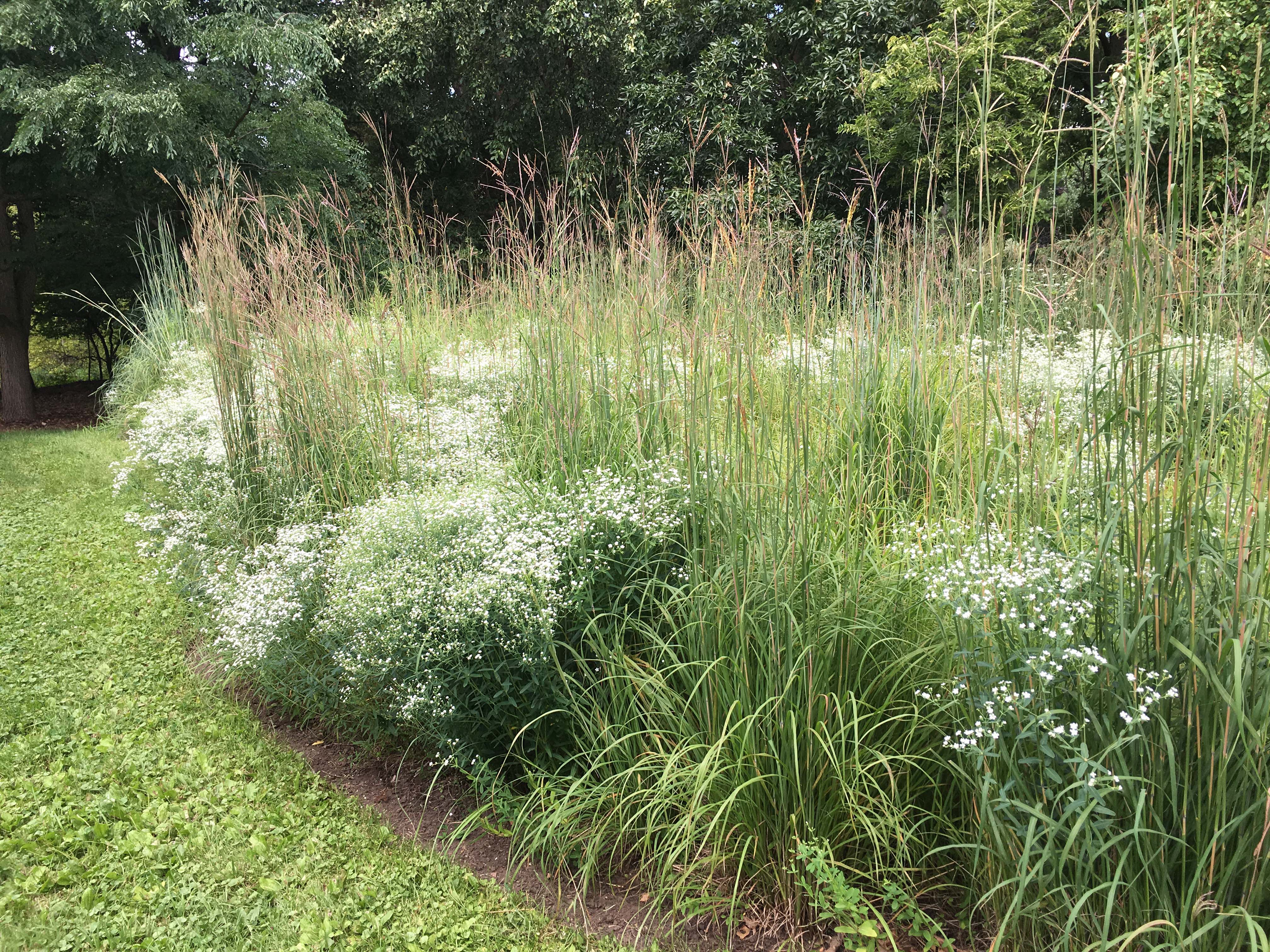
By making grass, sedge, and rush selections that have different active growth cycles and bloom times in a layered planting design, we support biodiversity at the local and global scale, improve human and ecological health, and move beyond single points of failure towards a resilient landscape.
Be on the lookout over the next few weeks as we cover resilient solutions for drought, extreme heat, fire, flood, and landslides.
Resilient Design | asla.org and 1 Million Species Are At Risk Of Extinction — Here’s Why It Matters were used as sources for this post.
How can being late make you early? When you use late-season production to maximize the next season’s crops! It’s a smart way for growers to make sure grasses are full and ready for the spring rush.

How does it work? Bring in grass liners late summer and early fall for transplanting. The short-term goal is for them to put on roots and get established before heading into dormancy. When spring comes, they’ll start stronger and finish faster than if potted up the same season. You can hit prime time earlier with full, finished plants. This strategy also works if you’re aiming for larger sizes like 2- or 3-gallon containers. Starting them at the end of the previous season will give you a fast, robust finish for summer and fall sales.
Successful late-season production requires having the resources to overwinter the plants. In addition, you’ll need to time it so your newly transplanted crops can establish roots before going dormant. Growers in cooler climates should aim their late-season production for late summer, while those in warmer climates have a longer window.
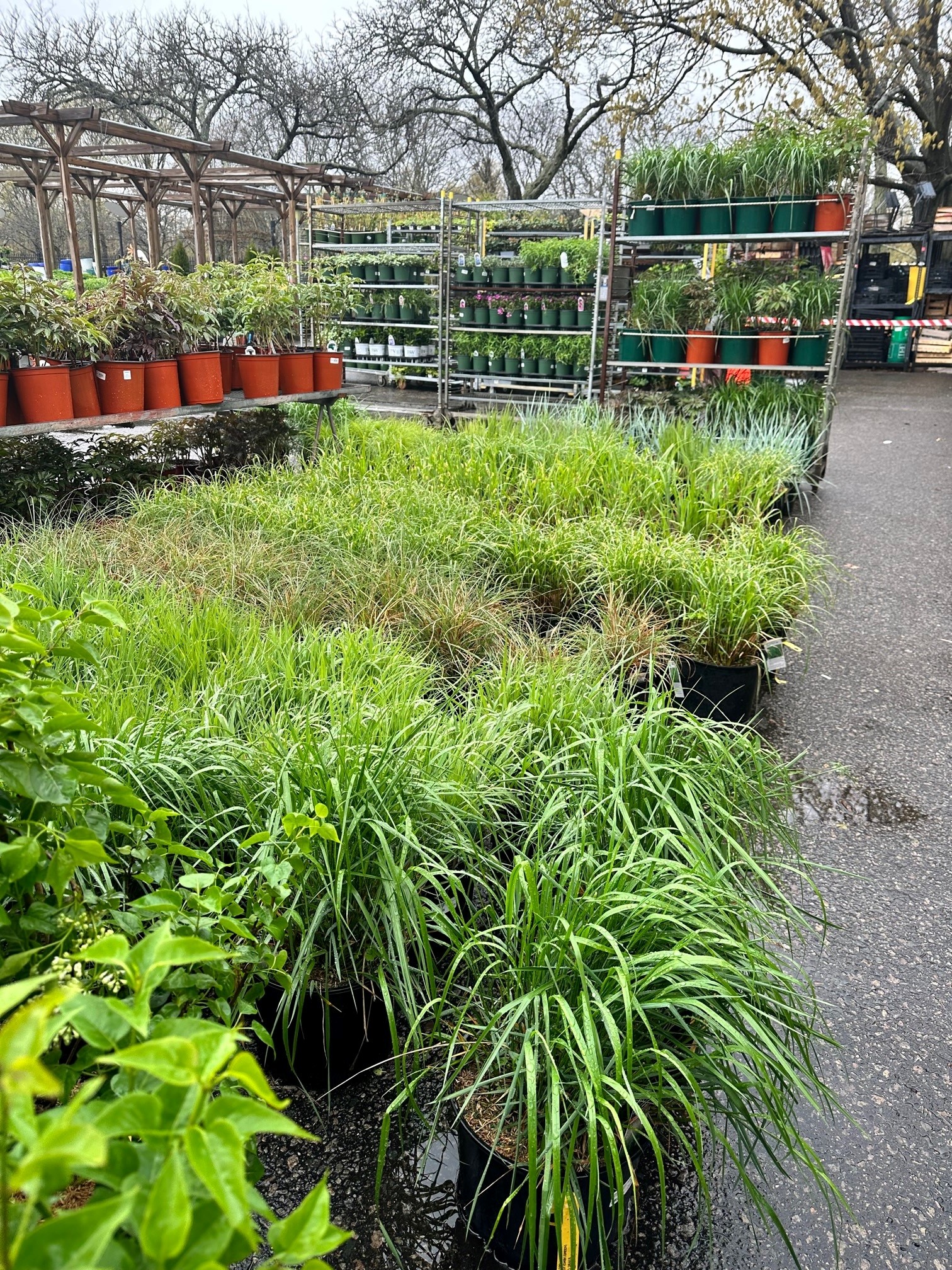
Popular grasses like Panicum, Pennisetum, Andropogon, Miscanthus, and Muhlenbergia do well in late-season production. Carex, which are cool-season growers, thrive with this scheduling. They’re actively growing late in the season when you would transplant them. Once overwintered, they’ll break dormancy earlier than warm-season grasses and will be lush and full for early spring.
If you’d like to learn more about late-season production, the Container Production section on our website has resources to help:
Late-season production gives you a smart head start. See our current availability to pick the grasses that will boost your sales next spring! Call or email our sales team—they can help you decide, figure out timing, and get you going. If you would like a PDF copy of this blog post, click here.
Ornamental grasses make notable planting partners. Whether you are using them as a focal point, to accent other perennials, or in a mixed border, grasses make your garden combinations shine. Trying to decide the best companion plant for your grasses? Consider these three principles first – balance, bloom, and basic needs.
First, to balance out your garden, vary visual texture and height of the plantings. These variations add interest, and used judiciously, can unify your design. The linear foliage and fine texture of grasses contrast beautifully with broad-leaved foliage The upright habits and varying heights of grasses allow you to create patterns and focal points. If you have gaps, fill in with quick-growing plants to bridge those spots until perennials mature. Our garden coordinator used herbs this year as fillers in some of our first-year plantings.
Next, consider the season and longevity of the plant’s blooms. Most warm season grasses bloom in late summer to fall. They can shine when early-season perennials are done or complement the blooms of later-flowering species. Selections of Panicum virgatum and Pennisetum alopecuroides are smart choices. Their lovely foliage and plumes provide months of garden beauty and enjoyment.
Lastly, make sure you’re combining plants that have the same basic needs. Group plants together based on sun exposure, moisture, soil, and drainage conditions.
Below are just a few of the combinations that work well together. Enjoy!









Check out our latest resource - The Hoffman Nursery Regional Plant Lists. Not only are these grasses and sedges resilient in the region, they are also customer favorites! It’s a win-win for your grass program, your landscape, and your community. We’ve also starred two additional plants in each list that we think are excellent options to consider.
See our Regional Plant Lists below or download a copy here. If you are looking for recommendations in other regions, please reach out to our sales team.


Our new catalog of grasses is here, and we think you will love it! It has more plant photos, along with updated content you’ve come to expect:
New to this year’s catalog:
Knowing how handy you find these items in the catalog, we’ve created PDF versions that are available on our website. You can find them on the resources page along with other useful “grassy” information.
If you’re not on our mailing list and would like to dig into the new catalog, there are several options:
If you’re not already hooked on grasses and sedges, beware. You may be soon!
Sure, when you think of golf courses, you think of turfgrass. But the grasses we grow play an important role on golf courses - they add ecological value.
Ornamental grasses are great performers for golf courses. They do not need a lot of input to look good. They adapt to poor soils and do not require supplemental irrigation and fertilization once established. Their branching, fibrous root systems slow runoff, which helps reduce erosion, improves water quality, and increases infiltration. They tolerate drought and some can withstand soggy conditions. Another bonus - they only need cutting back once a year - no mowing!


Grasses can serve as host plants for pollinators and provide food, shelter, and nesting materials for birds and small mammals. Deer, on the other hand, tend to leave them alone.
And beautiful? They’ve got that covered, too. The rough needs to look good, and with their seasonality, unique forms and textures, and design versatility, grasses bring outstanding beauty to the course. Use them as screening between areas, backdrops for broad vistas, accents in entrance plantings and parking lots, and showy displays in the fall.
When it comes to grasses for golf courses, these options are a hole-in-one!


Did you know? Many grasses and sedges provide for and protect our pollinator friends. They supply nesting space and shelter away from predators and bad weather as well as provide a place to raise their young and forage for food. Grasses and sedges can also serve as the foundation for a designed plant community. Check out a few of the grasses and sedges below that support pollinators.



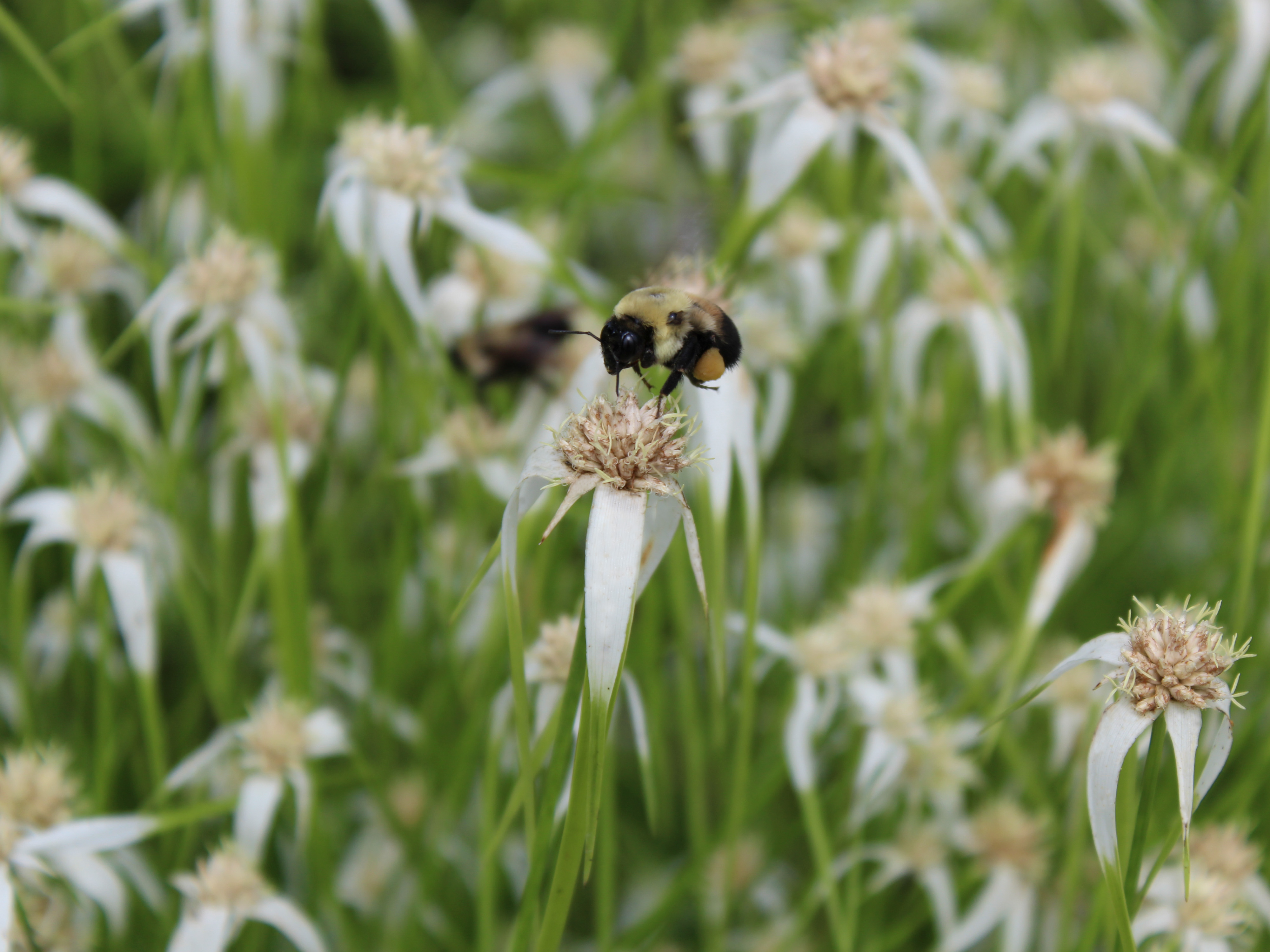
Rhynchospora colorata is well-loved among many pollinators, including bees and butterflies.


For more information about these grasses and sedges, and others that support pollinators, reach out to us! To learn more about pollinators, visit Pollinator.org.

Carex pensylvancia can host 36 species of caterpillars and is a favorite native ground cover.

     Andropogon gerardii is one of many native grasses that serve as a larval host for butterflies. Andropogon gerardii is one of many native grasses that serve as a larval host for butterflies.
|
When we think of the color of sedges, we often think of a light or mid-tone green. And although delightful, the shades of sedges are much more than that. Sedge grows in blues, silvers, dark greens, golds, browns, oranges, and everything in between. In this post, we have selected various sedges from our collection that have superb color. We love these sedges for their beauty, versatility, and functionality. They work great in a variety of landscapes and container plantings as well as serve as building blocks for environments that are beautiful and low maintenance. There’s a world of opportunity with these sedges and we hope you’ll consider them for your next project or grass program.
These are just a few of the sedges we offer, there are plenty more with beautiful foliage and seedheads. To see our full Carex Collection click here, and for a side-by-side comparison, download our Carex Comparison Chart.

Though sedges are known primarily for their foliage, many produce delightful and unusual blooms/seed pods. Check out just a few of our favorites below, both in the landscape and up close. To learn more about each Carex, simply click on the image.







Some like it hot, some like it cool—Do you know which of your grasses are cool-season and which are warm-season? It makes a difference. Cool- and warm-season grasses have different dormancy and growth patterns. This affects growing schedules, optimal transplant times, the time of year they finish, and when liners are available for purchase.
Cool-season plants photosynthesize most efficiently when soil and air temperatures are cool and moisture is abundant. Under these conditions, they’re able to devote resources to plentiful growth. In most temperate climates, this happens in spring and fall. To ensure high-quality liners, we produce and ship some of the more heat sensitive, cool-season plants while temperatures are moderate. Check the individual plant descriptions for more info. Click here to browse our cool-season grasses.

When temperatures start rising in late spring and early summer, cool-season grasses slow down as their photosynthetic process becomes less efficient. That’s when warm-season grasses start performing their best. Their photosynthetic process is very efficient at higher temperatures and with abundant sunlight. With similar resources, they can put on more growth than a typical cool-season grass. Their growth begins in the mid-spring and ramps up with warmer temperatures. Most flower in the late summer or early fall. Click here to browse our warm-season grasses.

This handy chart outlines a few of the major differences between cool- and warm-season grasses:

To see which of our plants are cool- or warm-season, you can filter by “Growth Cycle” on Our Plants page or check the individual plant profiles. If you are looking for more useful grass resources check out the links below.
April 14th is National Gardening Day! It was developed to celebrate gardening and its benefits as well as to inspire individuals to get outside and start planting.
We think National Gardening Day is important for several reasons. It encourages individuals to connect with plants and nature, which has been shown to have many health benefits, such as reducing stress and anxiety, improving concentration, and helping your mood and well-being. You can also find additional ways plants are beneficial to us in our “Plants aren’t Just Pretty” infographic at the bottom of this post.
One way to celebrate National Gardening Day is with grasses. Whether you are planting a pollinator garden, a mixed planting, or diving deep into a green infrastructure project, grasses and grass-like plants are a great place to start. They solve site dilemmas, add ecological value, and create healthier environments. They are vital to the well-being of our gardens and our communities.
If you’re searching for ideas to enhance your garden with grasses this year, experiment with these options that are reliable and easy to care for. They can introduce a pop of color and texture to your landscape while helping to support pollinators and other wildlife.

Other ways to enjoy National Gardening Day:
Now let’s get out, move some soil around, and plant something (hopefully grasses) in honor of National Gardening Day!

There’s a lot to love about Carex. Commonly called sedges, they’re go-to plants for all kinds of projects. Our “sedge story” begins in 1991 when two unusual-looking Carex caught our eyes—Carex buchananii and C. muskingumensis. While grasses were still relatively unknown at the time, sedges were almost unheard of in the trade. But these additions spiced up our grass lineup with something new and complementary.
As sedges caught on we added a few colorful varieties, mostly for use in containers and mixed plantings. But, over time, we discovered that sedges, especially native species, are workhorses. They’re valuable groundcovers, useful in ecological plantings, and perform important functions anywhere folks demand plants that do more.
From the two that started our sedge story in 1991 to the 35+ we grow now, we’ve gotten to know sedges. We want to share our knowledge and enthusiasm with our customers. We believe sedges make sense in many ways. They make sense for growing programs. They make sense in the landscape and in green infrastructure. And sedges make sense for business.
In this video, our Marketing Coordinator Alex Stanley-Stretch and Head Grower Bill Hall dig deeper into sedges - covering some of the basics, growing tips, their favorites, and more! We hope you’ll check it out!











The Power of Grasses & Sedges in Green Infrastructure
Dig Deeper into Rain Gardens
Rain gardens provide solutions to stormwater runoff by capturing rainwater efficiently and trapping pollutants from entering our waterways. They can be created intentionally or occur naturally in the landscape and provide many benefits to you, your community, and the environment.
Rain gardens:
Managing stormwater with green infrastructure practices is essential to building resiliency and promoting better living in our communities. Below we are featuring a few grasses & sedges that are great choices for rain gardens.

Andropogon glomeratus thrives in damp soils where it can reseed and spread, creating vertical interest in your rain garden. It thrives in full sun conditions with a vibrant green color in the summer, then fade to a copper-orange in the fall. This native is great for any stormwater management project, and it will provide food and shelter for wildlife.
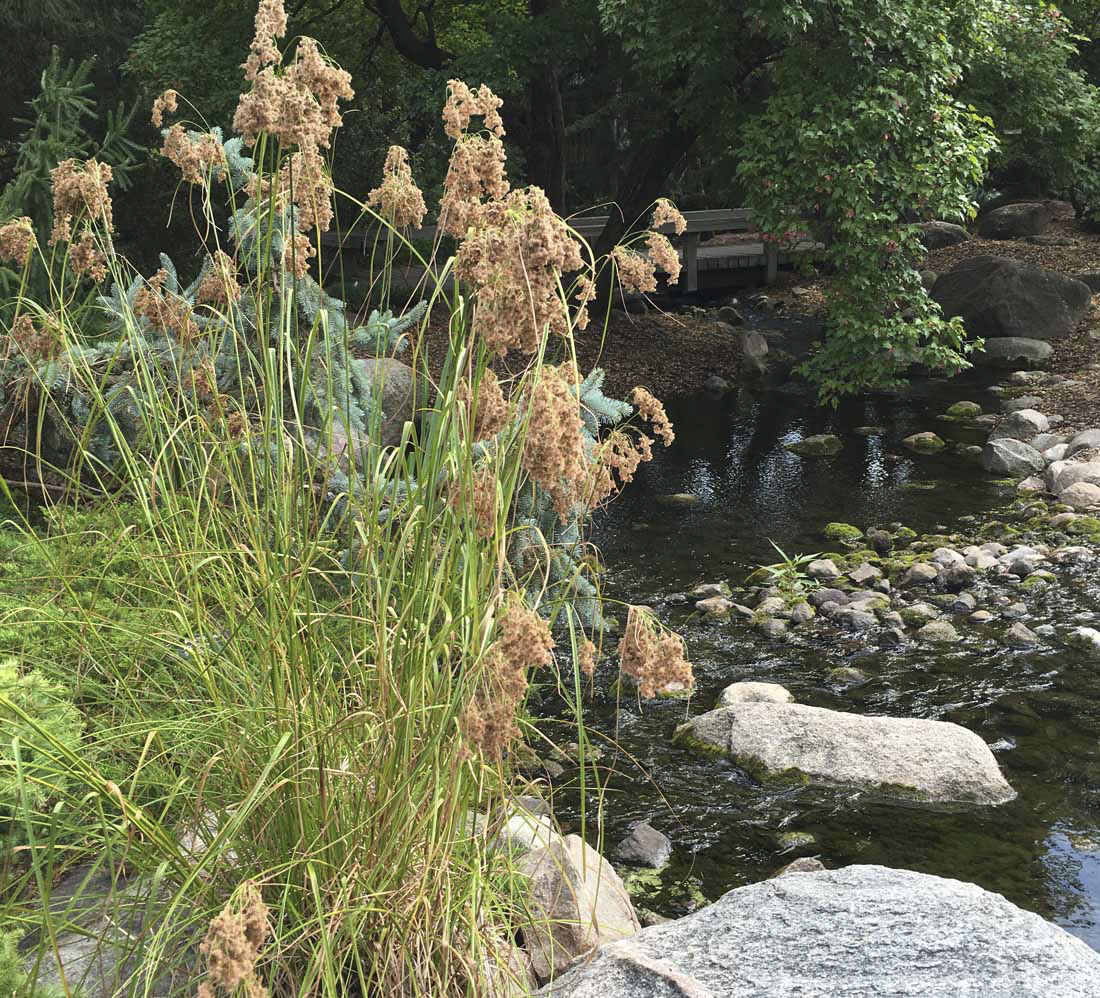
Scirpus cyperinus is a very adaptable sedge that appreciates wet conditions and produces interesting summer plumes that add texture, interest, and height to your rain garden. It is a smart choice because the deep fibrous roots will stabilize your rain garden while providing many benefits to wildlife like food and shelter. It’s also perfect for wet meadows, ditches, ponds, and bogs.

Carex vulpinoidea is best used in the lower regions of your rain garden. It can take a wide range of conditions making it a must-have in your project. Its arching foliage shows off fine-textured leaves. In the spring, seed clusters that resemble a fox’s tail emerge, promoting its common name, Fox Sedge. In the right conditions, C. vulpinoidea will reseed and colonize creating a beautiful bunching mass.

Sporobolus wrightii is another very adaptable grass that shows off its beauty with its arching foliage and showy plumes. It would do great by itself, as an accent in mixed plantings, or as a highly ornamental solution to erosion problems. The deep fibrous roots of this grass will stabilize your rain garden allowing it to alleviate issues with flooding and drainage.
To learn more about these plants and rain gardens, check out this video with Sami from our Sales Team.


Containers aren’t just for flowers, and grasses aren’t just for ground covers and borders. Mix it up and use grasses to add personality, texture, and color to containers. We’ve chosen a few of our favorite grasses that you might not have considered using in containers. These container plantings expand the landscape onto walkways, patios, and other outdoor spaces - inviting pollinators to visit, improving our well-being, and providing a better environment for all.

Looking for something to go alongside a pool, pond, or water feature? Look no further than Juncus inflexus ‘Blue Arrows’ (Blue Arrows Rush). Often grown as a wetland plant, ‘Blue Arrows’ handles dry conditions once established and thrives in heat and full sun. The soft color and beautiful, upright form make it irresistible in container combos. Like other Juncus, it’s tough, versatile, and evergreen in most climates.

Another great option for alongside water features is Acorus gramineus ‘Ogon’ (Golden Variegated Sweet Flag). It creates a beautiful mat of bright green and gold that can jazz up shady spots or moist sunny areas. Brighter light lends more golden color, while deeper shade highlights green. It’s an excellent medium-sized filler plant in containers, combine it with taller or shorter moisture-loving plants.

Muhly Grasses make excellent container plants but one you might not have thought of trying is Muhlenbergia Dumosa (Bamboo Muhly). It has a bamboo-like quality with a buoyant habit and graceful light green leaves. Growing up to 4’, it makes a movable screen when planted in containers and looks gorgeous on patios and in yards. It can also be brought indoors during the winter months.

Nassella tenuissima (Mexican Feather Grass) looks spectacular planted in containers with its wispy, flowing, lime-green foliage that sways in the slightest breeze. This cool-season native grass retains its color year-round, although it may brown out somewhat in the heat of the summer. Light, wheat-colored seed heads emerge in May. It requires dry soil and full sun, and it is very drought tolerant.

If you are looking for a pop of color in your containers look no further than Carex testacea ‘Prairie Fire’ (Prairie Fire Sedge). Its slender green-bronze foliage is tipped with orange highlights. In full sun this deep orange coloring intensifies, creating a dramatic look that blends well with hot-colored perennials. Its size and upright habit make a great focal point in mixed containers.
We encourage you to try these unexpected choices. Contact us by email or at 800-203-8590 to place your order today. There are plenty more to choose from, too, as grasses perform well in the quick-draining media of containers. For more options, see our full list of grasses that are outstanding in containers.
Every nursery has their fair share of popular plants, but what about the plants that don’t make it into the limelight? Beyond the well-known, there are some fantastic grasses and sedges with distinctive offerings. Take a look at these hidden treasures that are available now to add to your lineup. They are full, gorgeous, and ready to go. An added bonus? They are easy to grow, low maintenance, and offer unique solutions. Order now before all the treasures are snapped








Learn more about these plants by clicking on the photos above. If you have any questions or would like to place a wholesale order, contact us here.
Start building your own treasure trove today!

Intentionally setting fire to a landscape can seem counterproductive. But it’s a useful tool for managing forests, prairies, meadows, other grasslands…and now grass liners? Our Head Grower Bill Hall and his growing team recently started burning select trays of our native grasses, Sporobolus heterolepis and Eragrostis spectabilis, each responding well to this process. They have found that burning helps minimize weed growth, puts nutrients from old plant material back into the soil, and eliminates serious pests and diseases. It is a great way to promote new growth and reinvigorate these crops in a time-efficient manner. This practice dramatically cuts down on the labor it takes our growers to hand-prune some of our liners.
Check out the video below where our Head Grower Bill Hall talks more about burning grasses.

When it comes to burning grasses, please check with your local ordinances regarding rules and regulations for prescribed fires. If you are interested in learning more about our process, feel free to reach out to us here. There are also many resources about controlled burning and prescribed fire online. A good start is the Coalition of Prescribed Fire Councils, Inc. For those in the Southeast, there’s a helpful resource page from the NC Prescribed Fire Council, our state affiliate. We also have a post about the value of burning grasses in the landscape that’s available here.

The excitement was incredible, the food was occasionally superb, and the company was wonderful. We’re talking about the winter trade shows we recently attended. Between MANTS and Green & Growin’, we saw a wide array of people and had some fascinating discussions about grasses and sedges.
It was great being back in person at MANTS this year. Much of the talk at the show was about spring orders and what’s trending in the world of grasses. We also heard about increased interest in native plants and functional uses of grasses. We’ve been talking about this for a while now, and it feels like the trend is continuing. This was especially the case with landscape architects and designers. Many growers also said they’re moving native plants for large landscape jobs as well.

Luckily there was no winter weather this year at Green & Growin’! We saw friends and colleagues from across the state and the Southeast and it was a steady stream of plant people stopping by the booth. It’s always a homecoming show for us. Our growing team took part in the educational sessions and the ladies on our sales and marketing team attended the Women in the Green Industry gathering. It was a great time all around.
So, what were the favorites this trade show season? Attendees were excited about the ground covers we featured in our booth. They stopped to run their fingers through the fine texture foliage of Nassella tenuissima and Deschampsia flexuosa and loved the colors of Carex testacea ‘Prairie Fire’ and Carex oshimensis EverColor® ‘Everlime’ PP25622. They also enjoyed looking through the Covering Ground chart we created last year for our catalog. If you would like to check this chart out for yourself, click here. In addition to the ground covers, we featured a tray of Eragrostis spectabilis we had recently burned. Be on the lookout next week for a blog post on why we are burning some of our grasses.
We have two more events we will be attending next week. We are excited to attend the ProGreen Expo in Denver, Colorado on January 31-February 2. Our Sales & Customer Service Manager Stephen Gillis will give a talk at the Expo on ‘Low Water Use and Drought Tolerant Ornamental Grasses’ on Thursday morning. On February 1-2, we will be participating in the University of Georgia Landscape Architecture Short Course. It’s a blend of presentations on plant materials, hardscape, and practice. As one of the country’s premiere landscape architecture programs, this event brings in highly skilled professionals. We will be there to chat with attendees about all things grassy.
We would like to thank everyone who stopped by to visit us at MANTS and Green & Growin’. We’re looking forward to a great season, especially given the enthusiasm we experienced at the shows. If we don’t see you next week in Colorado or Georgia, we hope to see you at the summer trade shows!



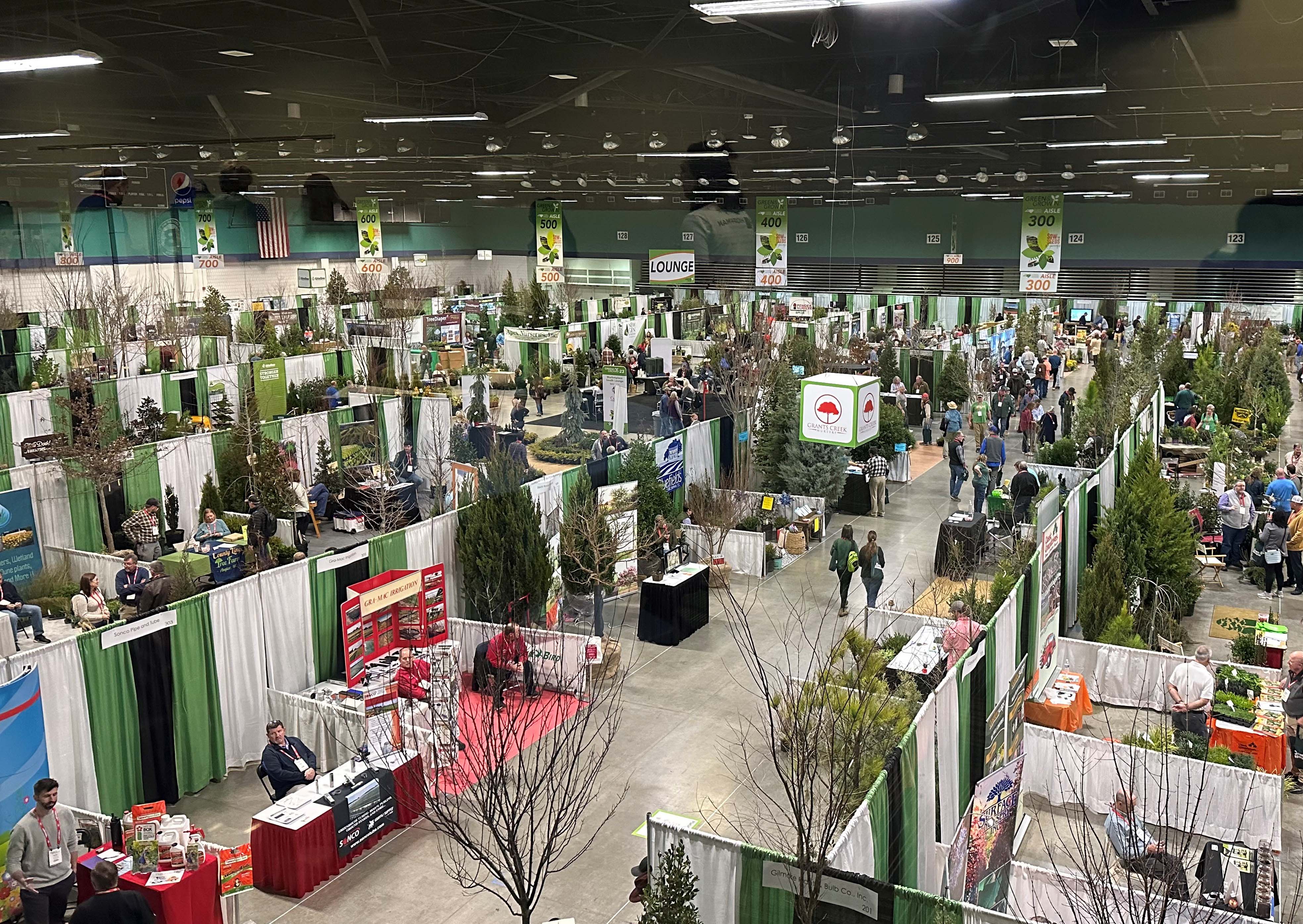
PRESS RELEASE - For Immediate Release
Contact: Alex Stanley ǀ Marketing Coordinator
919-479-6620 ǀ alexstanley@hoffmannursery.com
Hoffman Nursery Announces Owner Retirement After 40+ years in the Horticulture Industry
Rougemont, NC (January 5, 2023) – Hoffman Nursery announces the retirement of Co-Owner, John Hoffman as of January 1, 2023. Hoffman Nursery is pleased that Co-Owner Jill Hoffman will remain as President and CEO, and David Hoffman will continue as Vice President and Chief Operating Officer.
John Hoffman has spent over 40 years in the horticulture industry. In 1981, he started a design-installation firm called Landscapes by Hoffman. Shortly afterward, he discovered ornamental grasses. Grasses weren’t widely used in the U.S. in the 1980s; however, Europe had already embraced them. John traveled to Germany and was fortunate to meet with the late plant breeder, Ernst Pagels. Pagels’ enthusiasm for grasses and grass-filled gardens kindled John’s interest. John also gained inspiration from his mentor, the late J.C. Raulston at North Carolina State University. J.C. believed grasses would become popular and encouraged John to pursue his interest. The more John learned, the more his passion for grasses intensified.
In partnership with his wife, Jill, John transitioned from landscaping to growing in 1986. Hoffman Nursery was established on a 45-acre former tobacco farm in rural Rougemont, North Carolina. John personally delivered their first crops—grasses in large, finished sizes— in rented box trucks. Before long, the Hoffmans constructed their first hoop house, which allowed them to work through the intricacies of producing small, liner plants.
Now Hoffman Nursery ships liners to wholesale customers across the United States and Canada. That rented box truck is just a distant memory. An advanced production and growing facility, stock farm, and dedicated shipping areas help Hoffman Nursery fulfill its mission to produce high-quality plants.
John shares “As of January 1, 2023, I am officially retired from Hoffman Nursery, Inc. I’ve had a lot of fun over the past decades with tradeshows, conferences, and travel to nurseries, gardens, and other places around the world. Meeting many great friends and colleagues in this industry has been the highlight of the last 40+ years for me.
While I am retiring from the nursery, I’m not going too far – I expect to be at tradeshows, and travel to visit customers and friends for years to come. I look forward to finding new plants and ideas to bring back to the nursery. In addition, I have a long list of home projects to do as well as two new grandsons to teach how to build a fire, go camping, and enjoy the outdoors.
Things have already been changing with the addition of the stock farm and almost completed propagation glasshouse – and there is lots more to come. I look forward to watching the business transform and keep growing – and continue to grow good grass!”
COO David Hoffman shares, “I speak for all employees when I say we will miss seeing John every day at the nursery, but we are grateful to continue his legacy of growing good grass.”

About Hoffman Nursery, Inc: Founded in Rougemont, North Carolina in 1986, Hoffman Nursery specializes in ornamental and native grass liners for the wholesale trade. With a core purpose of promoting better living through plants, they grow over 140 species and cultivars of grasses, sedges, and grasslike plants, and ship to wholesale customers across North America. Since its founding, the nursery has expanded to include a state-of-the-art greenhouse and production facility and over 60 cold frames and hot houses.
For a few hours last week, Hoffman Nursery “sold” more than grasses. From furniture to clothing, books to electronics our employees donated hundreds of gently used items to set up a market where employees could “shop”. Instead of using cash, employees were given “Hoffman Bucks” to spend. For every Hoffman Buck we spent, the nursery donated a real dollar to the Food Bank of Central and Eastern North Carolina. At the end of the day the leftover books were given to a local library, and the rest of the unsold items were donated to TROSA, a comprehensive, long-term, residential substance abuse recovery program in Durham, North Carolina.
In addition to the market employees also played games and some entered the “Ugly Holiday Sweater” contest. It was truly a fun day for everyone! Check out a few photos of our wonderful afternoon below. A huge thank you to those who donated items and who helped organize the market. It was a great day for the nursery and our community.



It is with great pleasure to introduce the Hoffman Nursery update blog series. The purpose of this series is to notify you of some changes and improvements being made here at the nursery that will benefit your business.
We have all faced challenges over recent years with labor constraints, supply chain issues, inflation, and keeping our employees safe. Hoffman Nursery has worked hard to meet these challenges while trying to keep the business going and growing.
Our first update is our new stock farm, the Victor Chandler Property.

This property, located in Timberlake, NC, was purchased in February 2022. It has a total of 83 acres, with 18 acres of irrigated farmland and a 2-acre pond. The farm has a full-time Stock Supervisor and seasonal H-2A employees to work and manage the property.
In July 2022, we had a very successful first planting. We planted a number of seed items, many of which were harvested in September. The rest will overwinter and be harvested in 2023.
Planting stock plants at this location will vertically integrate our supply chain for grasses that are produced from division, and help to collect our own seed for propagation. This reduces our reliance on outside vendors, providing our customers with reliable and consistent plants from good stock.
We thank you for your loyalty over the years. It is important that you receive the high-quality product and customer service you expect and deserve. Be on the lookout for our next update post coming in January 2023.

Stormwater control measures (SCM) are structures that treat and manage the water that runs off parking lots, roof tops, and other impermeable surfaces during and after a rain event. Green stormwater infrastructure measures like bioretention cells and stormwater wetlands use plants, soils, and natural systems to slow and collect runoff, filter out pollutants, and increase water infiltration.
Grasses and grass-like plants are ideal for these measures! Their bunching habit and extensive root systems boost their ecological value by slowing stormwater, reducing erosion, and sequestering carbon. A few years ago, Hoffman Nursery and others worked with North Carolina’s stormwater program to add new plants, including grasses and grass-like plants to the NC Stormwater Design Manual. We’ve taken the native plants we grow from that list as well as a few others we recommend for bioretention cells and stormwater wetlands and compiled them into a chart to help the selection process. Click here for the chart and read on to see what information is included in it.

Grasses, Sedges, and Rushes for Bioretention Cells
Plants used in bioretention cells must be able to withstand widely varying soil moisture conditions. Conditions in bioretention cells can be very dry for long time periods, punctuated with periods of temporary submergence.
Bioretention facilities in the Piedmont and mountains tend to become wetter over time; coastal bioretention facilities tend to be very dry. The plants used should be species adapted to stresses associated with wet and dry conditions. Native grasses in a mulched cell are an excellent option for bioretention cell plantings because of their hardiness, deeper roots and aesthetic value.
Grasses, Sedges, and Rushes for NC Stormwater Wetlands
The shallow water zone includes all areas that are inundated by the normal pool to a depth up to 9 inches. This zone does become drier during periods of drought. Shallow water zones, such as littoral shelves should be vegetated with emergent plants capable of growing in alternating dry and inundation and provide some of the best treatment zones in the wetland.
The temporary inundation zone stabilizes the slopes and optimizes pollutant removal during storm events. The temporary inundation zone should be planted with vegetation that can withstand irregular inundation and occasional drought.
In the chart, we’ve also included climate zone, maximum plant height, exposure, and moisture information as well as the plants that support wildlife and pollinators. Grasses and sedges are often overlooked when it comes to pollinators and wildlife. Many of the native species we grow provide food and nesting material for butterflies and native bees. They also support other forms of wildlife like birds and small mammals by providing cover and a food source.
We hope you find this new chart useful. To see the full list of plants in the NC Stormwater Design Manual, click here. To learn more about green infrastructure, visit the GI page on our website, which includes information and links to more resources.
This blog post was written by Sami Nickerson on our Sales Team. She’s giving us the scoop on Ammophila breviligulata (American Beach Grass).
Considering recent weather events, we want to take some time to feature one of our crops that’s ready to be planted in the landscape during the fall season, Ammophila breviligulata.

American Beach Grass is a cool-season perennial bunch grass that grows about 2-3 feet tall and spreads vigorously by rhizomes. The best time to plant is NOW (or more specifically October to March). This grass is native to sand dunes of the Atlantic Ocean from New England to South Carolina and along the shores of the Great Lakes. It adapts to heat, wind, arid shifting sand, and salt spray.
This plant is known to trap and stabilize windblown sand, which facilitates the creation of new dune systems and therefore natural succession in the ecosystem. Having these dune systems can protect land, property, and wildlife habitat during hurricanes and storms.
Fun fact: One stalk planted properly in a well-prepared production field can yield up to fifty stems in one growing season!
If you have any needs for this grass let us know and we’ll get an order started for you!
For more information about American Beach Grass, check out our plant profile and this flyer from the USDA.
We appreciate a lush patch of turf grass—it’s perfect for playing games or lounging with a picnic lunch. But keeping that lawn looking ideal takes a lot of resources. Mowing, watering, fertilizing all have a cost, in dollars and on the environment. Plus, the market for better, more ecologically sound plantings is growing. So why not join in?
Try a planting that’s a low ground cover like turf grass but needs fewer resources to thrive. A number of the grasses and sedges we grow lend themselves to lawn alternatives. Their branching, fibrous root systems hold soil in place while also increasing water infiltration. Dense crowns and abundant foliage slow and filter runoff, reducing sediment and pollutants that flow into waterways. They can reduce weed competition, which lowers labor costs and reduces herbicide use. Our lawns can look great and function better with grasses and sedges.

QUICK FACTS


PRESS RELEASE - For Immediate Release
Contact: Alex Stanley ǀ Marketing Coordinator
919-479-6620 ǀ alexstanley@hoffmannursery.com
David Hoffman Receives Outstanding Young Alumni Award from North Carolina State University

Rougemont, NC (September 14, 2022) ─ On Friday, September 9, David Hoffman received the North Carolina State University (NC State) College of Agriculture and Life Sciences (CALS) Outstanding Young Alumni Award. The award recognizes former students who have excelled early in their careers and show potential for continued success.
Each year, the CALS Alumni and Friends Society, in association with the college, acknowledges distinguished and outstanding alumni for their achievements and ongoing commitment to CALS and NC State University. All alumni award recipients represent the fulfillment of the promise to NC State’s land-grant mission in academics, research, and Extension.
David Hoffman grew up in the plant industry and joined his parents in the family business. After graduating from NC State with a degree in Horticultural Science, David spent two years working at plant nurseries in Europe. He returned to Hoffman Nursery in 2015, serving as Project Manager and later as Chief Customer Experience Officer. At the start of 2020, he moved into the role of Senior Director of Sales and Operations. In that position, he covered day-to-day decisions and facilitated communication among all sectors of the nursery. Continuing his growth with the business, in 2022, David became the Chief Operating Officer. He now oversees long-range strategic planning and management of sales and operations. David has received previous awards in the horticulture industry including the Perennial Plant Association’s Young Professional Award in 2018 and Greenhouse Product News’ 40 under 40 award in 2019.
For more information about NC State College of Agriculture and Life Sciences Alumni Awards and recipients, visit cals.ncsu.edu/news/2022-cals-distinguished-and-outstanding-alumni-honored/
####
About Hoffman Nursery, Inc: Founded in Rougemont, North Carolina in 1986, Hoffman Nursery specializes in ornamental and native grass liners for the wholesale trade. With a core purpose of promoting better living through plants, they grow over 140 species and cultivars of grasses, sedges, and grasslike plants, and ship to wholesale customers across North America. Since its founding, the nursery has expanded to include a state-of-the-art greenhouse and production facility and over 60 cold frames and hot houses.
Contact: Alex Stanley-Stretch ǀ Marketing Coordinator
919-479-6620 ǀ alexstanley@hoffmannursery.com
Hoffman Nursery Announce Promotions on Sales and Marketing Team
Rougemont, NC (September 7, 2022) ─ Hoffman Nursery is pleased to announce the promotion of two employees, Stephen Gillis to Sales and Customer Service Manager and Alex Stanley-Stretch to Marketing Coordinator.

Stephen Gillis joined Hoffman Nursery in February 2019 as a Sales and Customer Service Assistant. Since then, Stephen has shown a strong commitment to the nursery and its success. Stephen will oversee the sales and customer service team and be responsible for developing and carrying out strategic plans to grow sales with existing customers and expand the nursery’s customer base. He will continue to help improve efficiencies in processes and databases related to Sales and Customer Service. Stephen will also help chart the effectiveness of our sales strategies and programs.
From his time as a fly-fishing guide in Alaska, working in corporate and institutional IT, running a successful gourmet mushroom farm, to Hoffman Nursery, Stephen has been in customer service his entire career. His primary focus as Sales and Customer Service Manager aside from growing sales will be to improve service and fulfillment to existing and new accounts to ensure customers receive the quality product they expect from Hoffman Nursery.
“Stephen’s cordial interactions with customers, thoroughness, and determination to provide customers with the best service, keep them happy and coming back,” says David Hoffman, Senior Director of Sales and Operations. “We are pleased to have him in this role.”

In February 2017, Alex Stanley-Stretch joined Hoffman Nursery as Marketing Assistant, and in 2020, she became Marketing and Graphic Design Associate. Since then, she has, and continues to make, significant contributions to maintaining and increasing Hoffman Nursery’s standing in the industry and marketing its brand and products. Alex will have increased responsibilities for the nursery’s marketing efforts in her new role. She will coordinate and handle trade show activities and events and continue to manage and create content for Hoffman Nursery’s social media and website. Alex remains responsible for managing the yearly catalog project including everything from the designing process to print. She will also work closely with the sales team to provide marketing materials that will educate and inform their customer base.
After graduating college, Alex worked for a full-service marketing and advertising company before joining the Governor’s Office in Virginia. While there, Alex helped facilitate statewide agriculture and tourism initiatives, tours, events, and everyday tasks at the Executive Mansion. After leaving Richmond and moving to North Carolina, she returned to marketing, working as a Graphic Designer and Marketing Manager for a newspaper and media company. Alex also volunteers her graphic design services in her free time, most recently designing the Perennial Plant Association’s logo.
Regarding her newly assigned position, David Hoffman says “Because of Alex’s experience with us and her previous experience, she brings a wealth of talent and knowledge to our marketing, and we are excited about her more extensive position at the nursery.”
Both Alex and Stephen shifted into their new roles in August 2022.
####
About Hoffman Nursery, Inc: Founded in Rougemont, North Carolina in 1986, Hoffman Nursery specializes in ornamental and native grass liners for the wholesale trade. With a core purpose of promoting better living through plants, they grow over 140 species and cultivars of grasses, sedges, and grasslike plants, and ship to wholesale customers across North America. Since its founding, the nursery has expanded to include a state-of-the-art greenhouse and production facility and over 60 cold frames and hot houses.

How late in Fall can I plant grasses in the landscape?
We get this question often, and the short answer, like many other grass-related questions is – ‘it depends.’ The long answer is more nuanced, and since we are in Central North Carolina and have experience with fall planting in our region; please adjust any recommendations to your climate zone, region, elevation, and specific location. We tend to err on the side of caution for late fall planting because losses can be incurred, and while we are in the business of selling plants, we want to cultivate positive, long-lasting relationships with our customers.

Generally, we recommend having grass plugs installed four weeks prior to your first fall frost date. That period will give the plugs time to establish root growth so the grass can access moisture and nutrients that will help carry the plug through winter dormancy and provide resources to recover if there is an early frost.
In Central North Carolina, our first frost is typically around October 15, so installing grass plugs in August through mid-September is a proven strategy. Fall planted grass plugs that establish before the first frost, go dormant for winter, and wake up in spring have a more robust demeanor and will have a head start versus early spring plantings.
There are warm and cool season grasses that can be successfully installed past October 15, but specific factors including genus and species selection, weather, slope, aspect, and micro-climate of the site will dictate success or failure. Practices including well applied mulch, and covering grass plugs with frost blankets or row covers can also help minimize losses for late fall installations.
Warm Season Grasses our customers have had success planting past October 15:
Cool Season Grasses our customers have had success planting past October 15:
We have a great selection of warm and cool season grasses available now for fall planting, check out our most current availability.
Have different experiences with late fall planting or questions for our sales team? Please reach out!
—
Covering the ground with plant material can help bring the land to life! Many of the grasses and sedges Hoffman Nursery grows are well-suited for covering ground. With a biodiverse natural landscape, nature can thrive. There are many different options out there when it comes to ground cover plants. Here are a few of my favorites that might fit right in with your landscape needs.
Bouteloua curtipendula (common name: Side Oats Grama, below) is a great ground cover known for its resilience. This is a warm season native found in North and South America and grows in zones 4-9. Side Oats Grama thrives in full sun and will grow to be 1-3 feet tall at maturity. It has a gray-green color and has very interesting seedheads.
Side Oats Grama spreads slowly, but it becomes vigorous once established. It flowers in July-September and spreads by rhizomes. It’s drought tolerant and can survive in harsh conditions. Bouteloua curtipendula is also great for green infrastructure projects such as erosion control, green roofs, and meadow and prairie plantings.

Carex oshimensis EverColor® Everest (‘Carfit01’) PP20955 (common name: Everest Sedge, below) is part of the Evercolor series. It’s an awesome ground cover that is more vigorous than its parent plant, ‘Evergold.’ This is a cool season plant that does best in part sun-shade and dry-moist conditions. It grows in zones 6-8 and originates from Japan.
Everest Sedge grows into a neat, wide mound and its foliage has white edges and a green center. The plant flowers in early Spring and grows to around 1 foot tall. Because of its vigorous nature and appealing looks, I think this plant makes an excellent ground cover.

Eragrostis spectabilis (common name: Purple Love Grass, below) is perfect if you are looking for a beautiful, tough, native ground cover. It’s drought tolerant and can grow in harsh conditions and varying habitats. It grows in zones 6-10 and originates in Central and Eastern North America, commonly found in open fields and meadows. This plant is also perfect for many green infrastructure projects, which help to reduce stormwater runoff and create green spaces in urban areas.
Purple Love Grass grows in dense clumps and has beautiful purple panicles. It’s a warm season plant that prefers full sun and drier conditions. It spreads using rhizomes and can grow to around 1 to 2 feet tall. It is resilient, yet nice to look at making it a perfect addition to a variety of landscapes.

Chasmanthium latifolium (common name: River Oats, below) is a native that’s perfectly suited as a tall groundcover. This vivid green warm season plant may grow up to 4 feet tall, but its panicles drop under its weight. It flowers and grows pale green seed heads in the summer.
River Oats will spread and reseed so place it with that in mind. It grows in zones 5-10 and originates in North America. Sun or shade, moist or dry, this plant will thrive and look great. In addition to being a great ground cover, it also works well in bioswales and vegetated swales.

In conclusion, there are many different yet great options when it comes to covering the ground. For the full list of grasses and sedges Hoffman Nursery recommends for ground covers, check out the new Covering Ground Chart (It’s also available in the 2022-2023 Catalog of Grasses & Sedges). The chart includes useful information such as on-center measurements, profile, exposure, showiness, and more. I hope you will consider using these grasses for your next ground cover project.
—


A few years ago we transitioned from growing our liners in breakaway trays to plug trays. The plug trays are a favorite of ours and customers alike as they reduce waste and improve the production process. Across the grasses we grow, some varieties are slow to root or root inconsistently. Those crops required more time to finish and had to be sorted before shipping. Our solution is to use a product called a Growcoon.
The Growcoon is a biodegradable web with an open net structure. It goes inside each cell in the plug tray before we fill it with growing media. As the plant roots out, the Growcoon binds the root ball together and provides structure for the roots to continue growing. We’ve found it grows a fantastic liner and, in some cases, has finished faster.

If you receive liners with Growcoons, you can plant them directly into a pot or in the ground. There’s no need to loosen or remove the net structure. Growcoons begin to break down when you plant them and will continue to break down throughout the growing process. They are biodegradable and are certified organic in the European market.
For more information, check out the video below. Also, scroll down to see frequently asked questions (FAQ) about Growcoons.

What is a Growcoon?
It’s a biodegradable web with an open net structure. It binds the root ball together and creates structure so that the plant’s roots can continue growing freely.
Do I need to loosen or remove it before transplanting?
No. In fact, leaving the net structure in place provides real benefits for handling and transplanting.
What are some of the benefits of Growcoons?
• Fewer losses. The Growcoon holds the root ball together without damaging the roots, so the liner is more resistant to handling and less likely to fall apart in transplanting.
• Quick removal from the tray. The Growcoon makes it easier to press the plug out from underneath.
• More uniform liners, which increase your efficiency in handling, transplanting, and finishing.
How quickly does it break down?
Once in contact with substrate, micro-organisms such as bacteria and molds gradually break down the material. The speed of this decomposition process is influenced by the temperature, humidity, and pH of the substrate. We’ve had reports of customers being able to see pieces of the Growcoon months after transplanting, especially when overwintering. But they’ve reported no adverse effects, and said the liners were healthy and continuing to grow well.
Why don’t all my liners have Growcoons?
We’re currently using Growcoons with varieties that are slower to root or tend to root inconsistently. That’s where we saw the most opportunity for improvement. Now that we’ve seen how well they work for those plants, we’re planning to use them on more. It will be a gradual process, so you may see a mix—some varieties with Growcoons and some without. We’ll continue to evaluate their success and make decisions based on what’s best for you and the plants.
If you’d like additional information, give us a call or email our team.
Happy Pollinator Week! Grasses and sedges are often overlooked when it comes to pollinators. But many of our native species provide food and nesting material for butterflies and native bees. Their bunching habit and extensive root systems boost their ecological value by slowing stormwater, reducing erosion, and sequestering carbon. Native grasses and sedges also support other forms of wildlife like birds and small mammals.
Back in 2017, we installed a planting at the nursery on a steep slope adjacent to our greenhouse driveway. We call it the ‘Eco Bank,’ and we designed it to capture sheet flow from the drive and reduce erosion. We also wanted to support pollinators and wildlife. It is planted with our grasses, sedges, and rushes, along with perennials generously donated by Walters Gardens. Take a look at the Eco Bank below and some of the pollinators enjoying their local habitat!






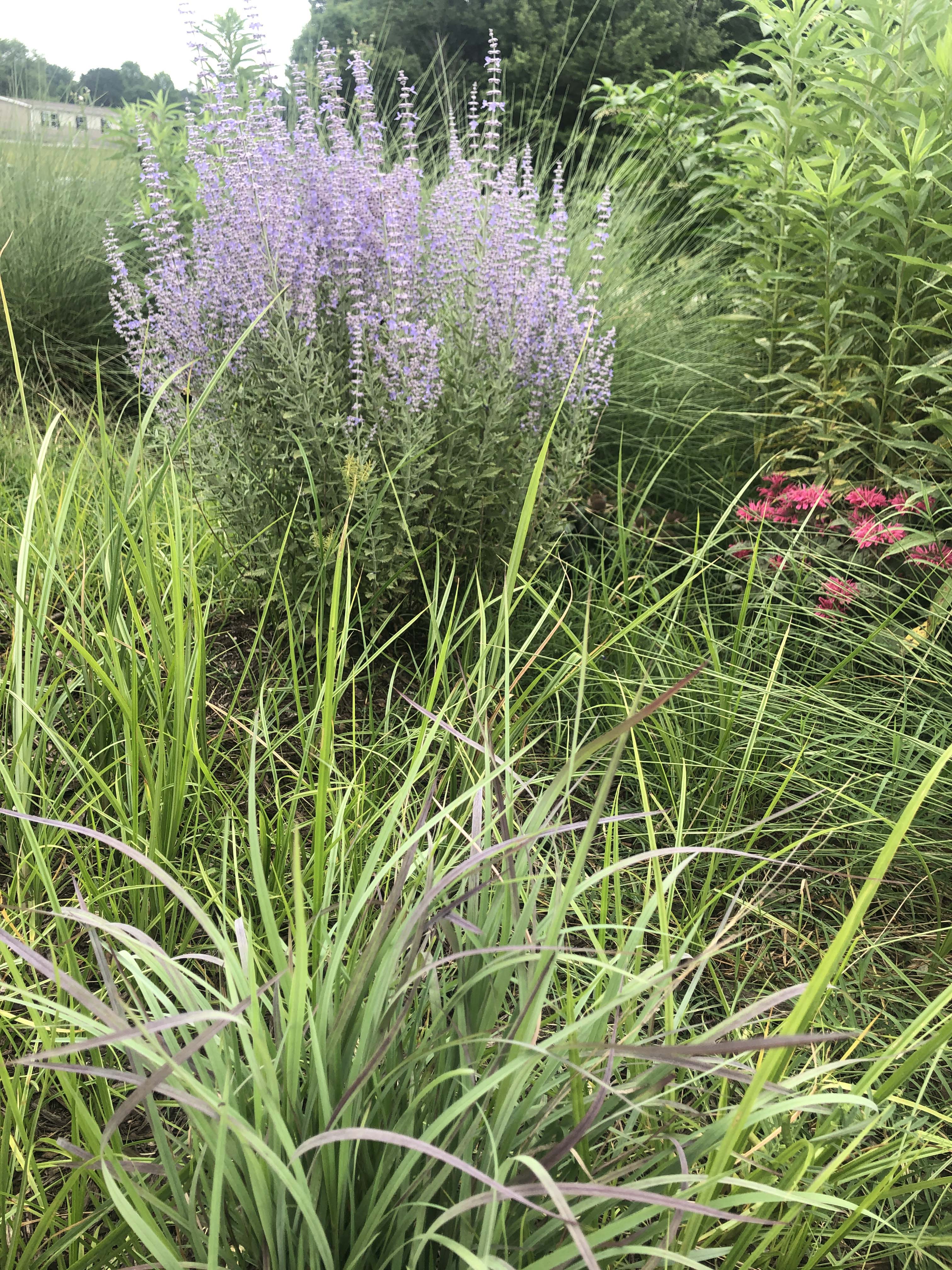


To learn more about the pollinator-focused plants we grow check out this PDF: A Different Kind of Pollinator Plant.
For other great pollinator content, check out the links below.
Grasses and sedges are often associated with the function they bring to a space, but they can bring interest and beauty, too! In the landscape, grasses and sedges with attractive foliage can be just as eye-catching as those with flowers. Whether it’s bold shapes, striking variegation, or a pop of color you are after, there’s a grass for that. Scroll down for a look at these interesting foliage plants.



Click here to see our full lineup of plants and here to check availability on our liners.
When John and Jill Hoffman founded Hoffman Nursery, they knew they wanted to focus on grasses. People questioned the wisdom of specializing in something that meant turf to most people. But the Hoffmans recognized both the beauty and benefits of ornamental and native grasses. Thirty-six years later, the nursery is a leader in the industry. With son David and over 60 employees, the Hoffmans are still producing premium grasses for the horticultural world.
For a look at the past, present, and future of Hoffman Nursery, join us for a chat with founder and owner, John Hoffman, and Chief Operations Officer, David Hoffman.

How do you deal with wet areas that never dry out? Plant a sedge, of course. We grow moisture-loving Carex in a variety of sizes. They’re lush growers with no-fuss, low-resource needs. They’re also handy for the edges of ponds, water gardens, or natural seeps. In tricky spots where other plants succumb to constant moisture, these sedges flourish.
Spring crops of sedges are coming in, and we’re highlighting seven selections that are fresh and ready to ship. Lower-growing selections are listed first, followed by taller varieties.

An incredibly versatile native Carex. Use in rain gardens, meadows, natural areas, or anywhere a good filler is needed. Arching green foliage with bunching habit; semi-evergreen in mild climates. Spreads via short rhizomes and reseeding, so site where more is welcome. Attractive, drooping seed heads form in spring. Occurs naturally in moist habitats but will tolerate drier conditions.

This widely adaptable, native sedge has subtle ornamental appeal with green foliage and a tidy, bunching habit. Grows throughout the eastern U.S. in a range of conditions and remains semi-evergreen in milder climates. Good for rain gardens, shade plantings, meadows, banks, or a low-maintenance ground cover. Tends to reseed. Also known as Eastern Narrowleaf Sedge.

Native to wet meadows and woods, bottomland forests, floodplains, lake and pond margins, and disturbed areas in Eastern and Central North America. Has a bunching habit with medium-wide foliage and spiky seed heads. Will spread via rhizomes. Use in prairie plantings, bioswales, remediation projects, ditches, and wet areas in the landscape. Important food source for game birds, waterfowl, and songbirds.

When planted in full sun and moist-wet soil, fine-textured leaves are striped sporadically with bright green lines (will turn lime green when planted in shade). It is very well-suited for moist or wet areas, as it thrives in up to three inches of water. Can tolerate slightly drier soils if planted in shade. Magnificent in masses, borders of ponds, as a dramatic specimen, or in decorative containers.

Native to the eastern half of North America, Gray’s Sedge is found in floodplains, swamps, and bottomland forests. It draws attention with pale-green seed heads that resemble three-dimensional stars. Works well in lower zones of rain gardens and bioswales. Fabulous at the edge of ponds, in wet areas, or in containers with other moisture-loving plants. It prefers moist soil, and light shade or part sun.

This North American native is found in fields, meadows, swamps, ditches, and wet, disturbed sites. Favors calcium-rich soils. Grows in a bunch with long, green leaf blades. Produces interesting, bristly bloom seedheads in spring. These seedheads are similar to C. lurida but are green rather than yellow. Useful for wetland restoration, rain gardens, bioswales, and areas that remain relatively moist. One of our tallest sedges.

This native sedge grows in bunches and will reseed slowly to form colonies. It grows in an arching shape and forms elegant clumps and produces abundant, hanging seed heads. Occurs in disturbed areas, fields, woods, meadows, and marshes in Eastern North America. Useful for ditches, wet areas, rain gardens, and bioswales. Tolerates shade and may adapt to woodland gardens. Provides food and cover for wildlife. Currently the tallest sedges we grow.
To see comparisons among all the Carex we grow, refer to our Carex Comparison Chart. In addition to the plants above, we grow many others that thrive in wet areas. Some even do well in standing water. Plants in the genus Juncus, commonly known as Rushes, give appealing visual texture and love having wet feet. For more ideas, check out our full list of Grasses and Sedges for Wet Areas.
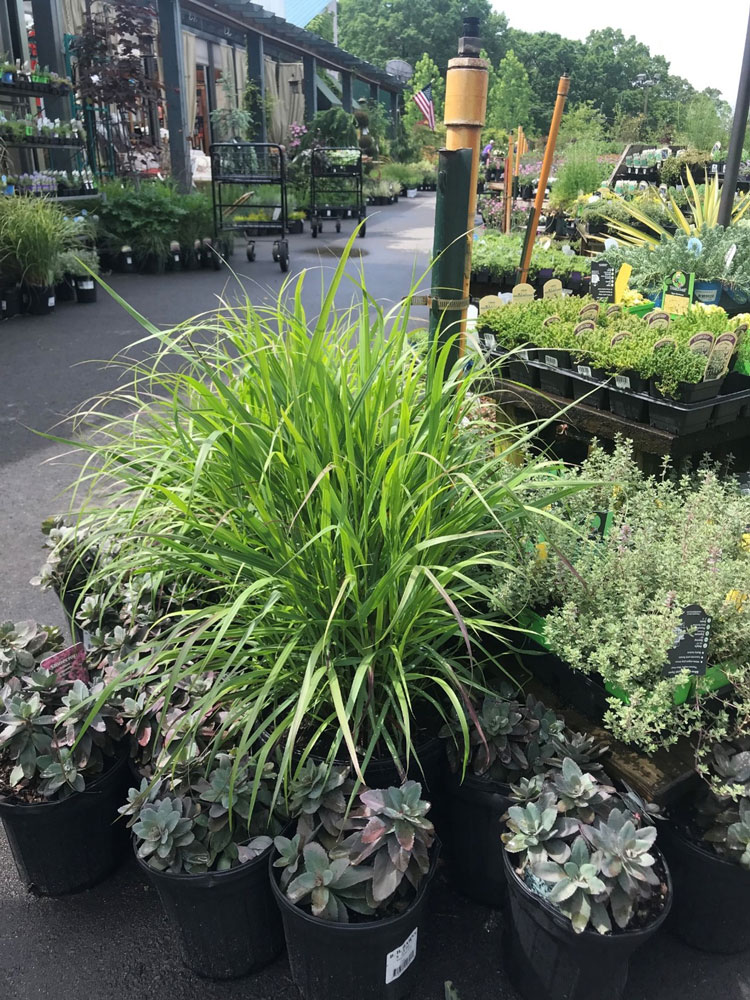
With spring around the corner, it’s a good time to check in on scheduling. With the right planning, you can finish beautiful crops of grasses for successful sales.
Warm-season grasses are the most common in the trade, so we’ll focus on those for this post. These heat lovers grow relatively slowly in mid- to late spring and then surge when temperature heat up. Most warm-season grasses look their showiest and bloom in late summer and fall, making them excellent choices for boosting late-season sales. They can also be made ready for spring sales with good advance planning.
What does production timing look like for warm-season grasses? Here’s a quick overview using one of our favorites, Panicum virgatum.
Late Winter/Spring Production
Potting up liners now and into spring will set you up for late summer and fall sales in 1-gallon or smaller sizes. The grasses will establish roots initially then put on top growth during their optimal growing time. The graphic below shows a typical cycle: potting in spring, growing to market size during summer, and ready for late-season sales.
From an efficiency standpoint, Panicum and other heat lovers have a big plus. They can be potted up later than other perennials when the spring rush is slowing, and labor demands are lower.

Summer/Fall Production
If you want warm-season grasses ready for spring sales or want to offer larger sizes (2-gallon +), overwintering is your best strategy. Pot them up during summer or early fall of the preceding year and overwinter them. The graphic below shows the typical cycle.
Make sure you pot them up in time to establish roots before they enter dormancy. That head start on root growth will give you a stronger, faster-finishing plant than if you’d potted it in the current season. This timing works for 1-gallon containers and is necessary when producing larger sizes.

Finish Times
We are often asked how long it takes to finish a liner in a container. As with many plant questions, the answer is, “it depends.” But we do have a few guidelines to share as a starting point.
Assuming 65° to 70°F throughout crop production, a 32-cell liner should finish in a gallon in 7 to 9 weeks. A 72-cell liner to gallon should take 10 to 12 weeks. Depending on the growing location, you can have multiple turns per acreage in the same season.
For sizes larger than a 1-gallon, we recommend planting during summer of the preceding year and overwintering.

To Learn More
Here are a few other resources on our website aimed at scheduling and production planning:
And you can always check in with our knowledgeable sales team to get advice and connect to our experts in growing and production. Have questions or want to fill holes in your grass program? Give us a call or email!

If you receive liners during winter or early spring, we’ll probably ask where you’re putting the plants. Why do we do that? It helps ensure the plants you receive have the best chance of growing and thriving in their new conditions.
Most of Hoffman Nursery’s liners are grown and overwintered in cold frames, so the plants are vernalized and ready to go when you receive them. The root systems are fully developed, healthy, and hardened off. Depending on when you receive them, the plants may be completely dormant or have recently broken dormancy.
Focus on Dormancy
Why does it matter whether liners are dormant? Dormant plants can usually handle sub-freezing temperatures and harsh conditions. They can go into a cold frame or heated house without any worries. The plants then break dormancy based on conditions at the local site.
Plants that have broken dormancy will be actively growing and have tender foliage. They can be damaged if exposed to colder temperatures than they’re acclimated to. The key is to match the condition of liners you receive with conditions where they’ll be stored and grown out once potted.
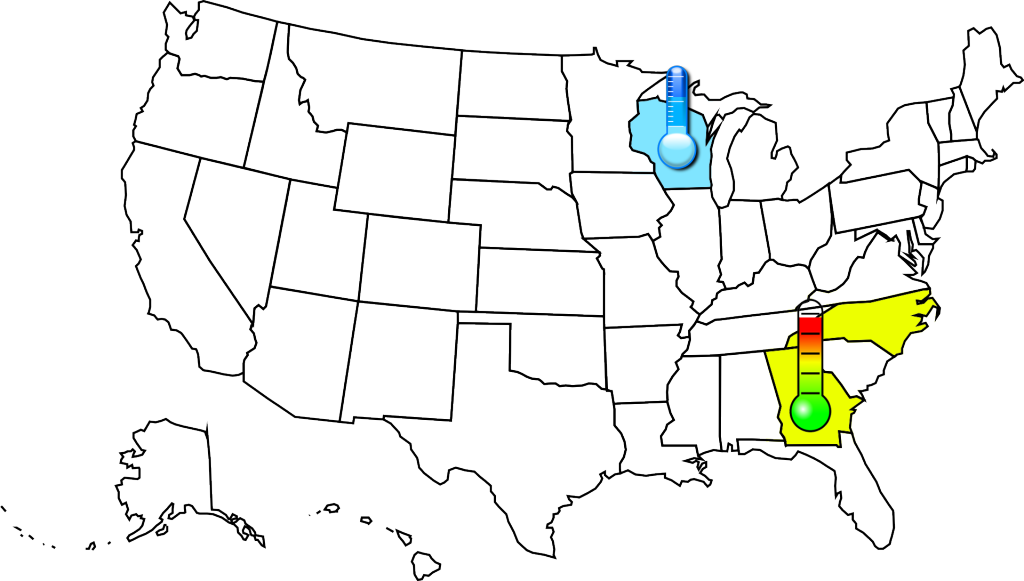 For example, a grower in southern Georgia could receive actively growing liners in late March and place them in a cold frame. Conditions there are likely to be similar to those here in North Carolina where the liners were grown. However, the same liners going to Wisconsin would need to be placed in a heated house. Local conditions in a cold frame would likely be too harsh and too much of a change for the plants to survive.
For example, a grower in southern Georgia could receive actively growing liners in late March and place them in a cold frame. Conditions there are likely to be similar to those here in North Carolina where the liners were grown. However, the same liners going to Wisconsin would need to be placed in a heated house. Local conditions in a cold frame would likely be too harsh and too much of a change for the plants to survive.
That’s why we pay particular attention to where plants are going during winter and early spring.
More Points to Consider
With winter and early spring shipments:
 With tender selections (e.g., Pennisetum x advena ‘Rubrum’) we ship only when temperatures are appropriate or the plants can be protected from freezing.
With tender selections (e.g., Pennisetum x advena ‘Rubrum’) we ship only when temperatures are appropriate or the plants can be protected from freezing.For more information or to check on timing for your shipments, email our sales team or call us at 919-479-6620.
To learn more about off-season growing, go to the overwintering grasses article in our container production section.

We’re giving 2022 a bright start with a look at three of our newest plants. You don’t have to be in-person to see these beauties! Get the scoop on them below and watch our short video.
Our Newest Grass

It’s the hottest ticket in grasses right now. Schizachyrium scoparium ‘Ha Ha Tonka’ is a selection of Little Bluestem from the Piet Oudolf Collection. It’s a collaboration between Oudolf and master plantsman, Cassian Schmidt. Schmidt is the current director of Hermannshof, a renowned public botanical garden in Weinheim, Germany. Schmidt was on a botanizing trip to the U.S. and collected Little Bluestem seed in Ha Ha Tonka State Park in south central Missouri. Back in Germany, he sowed the seed and began crossing the offspring. He and Oudolf made selections over time, and this cultivar was the result.
‘Ha Ha Tonka’ always brings out “ooo’s and ah’s” when people first see it. Dense, fine hairs on the foliage give it a soft glow that’s simply magical. It’s been used in Europe for a few years, and there’s been buzz about it in the U.S. for a couple of years. We’ve finally brought it to the U.S., and we’re pretty excited about it. Production is rolling out slowly, and crops are small initially. It will be going out to a limited number of wholesale nurseries and public gardens in 2022 and 2023. We hope to ramp up over the next couple of years and have wider availability. See full plant profile here
Our Newest Sedges
Tired of Liriope? Then these sedge should be at the top of your list. Carex Feather Falls and Carex Ribbon Falls are fast, strong-growing sedges with increased heat and sun tolerance. Both sedges were selected by Bart Noordhuis and Elisabeth Bisschop of Exceptio Plants in Boijl, The Netherlands from a cross between Carex hybrida parents. They’ve been in the U.S. trade for a few years, but with limited availability. Both are grower favorites, with a fast finish and easy management.
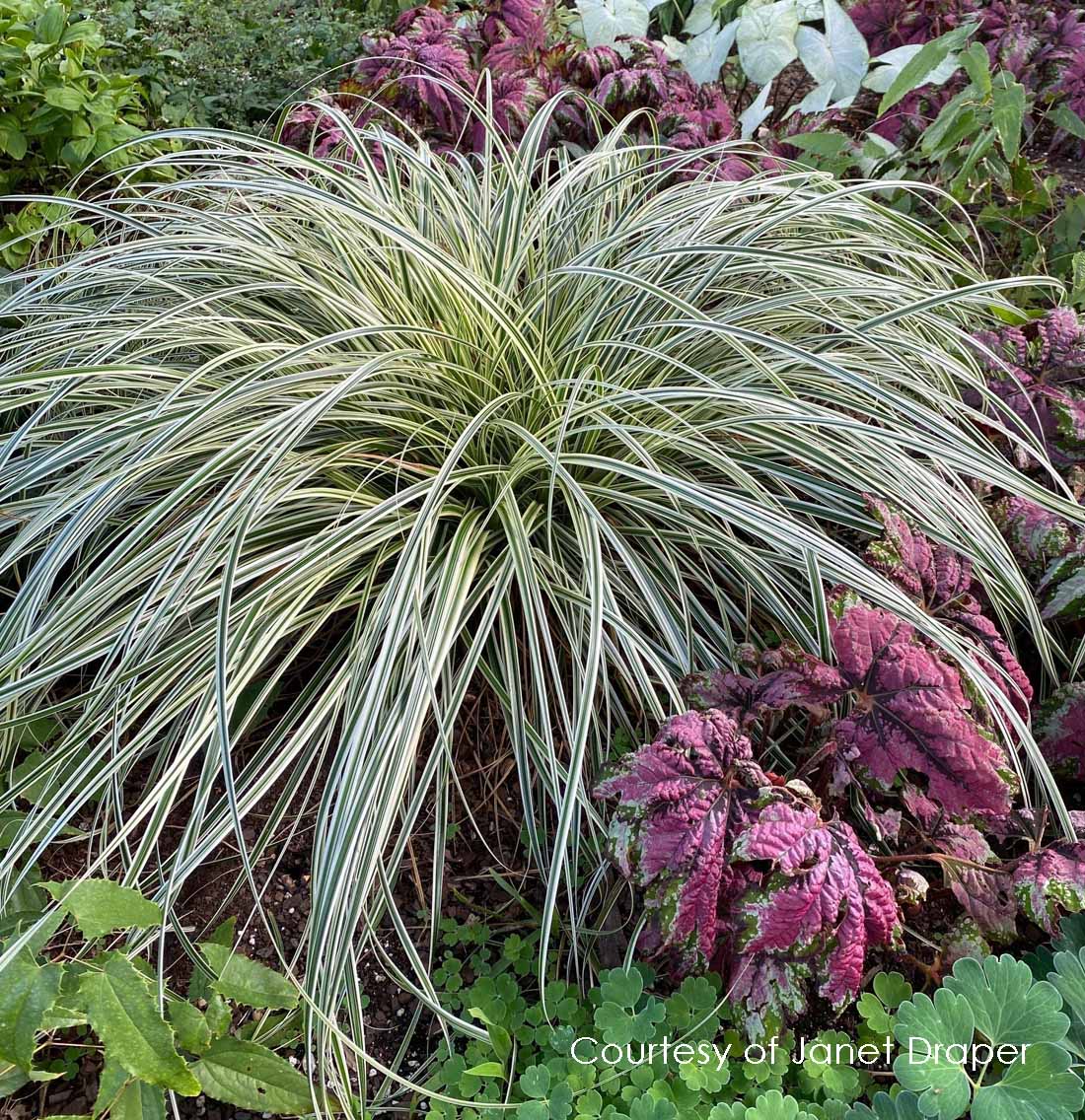
Customers have been asking for this sedge, and it’s easy to see why. One of our earliest looks at Feather Falls Sedge was in the Smithsonian’s Mary Livingston Ripley Garden in Washington, D.C. Curator Janet Draper showed it to us in a container during a December visit. It was gorgeous and full and added a bright pop of color to the mostly dormant garden. This sedge gets rave reviews for that bright variegated foliage, strong growth, and heat and sun tolerance. It can cover a lot of ground, with mature plants in the landscape easily reaching three feet wide or more.
Feather Falls is as beautiful and easy as it gets, earning the Handpicked for You® trust mark for superior garden performance. See full plant profile here
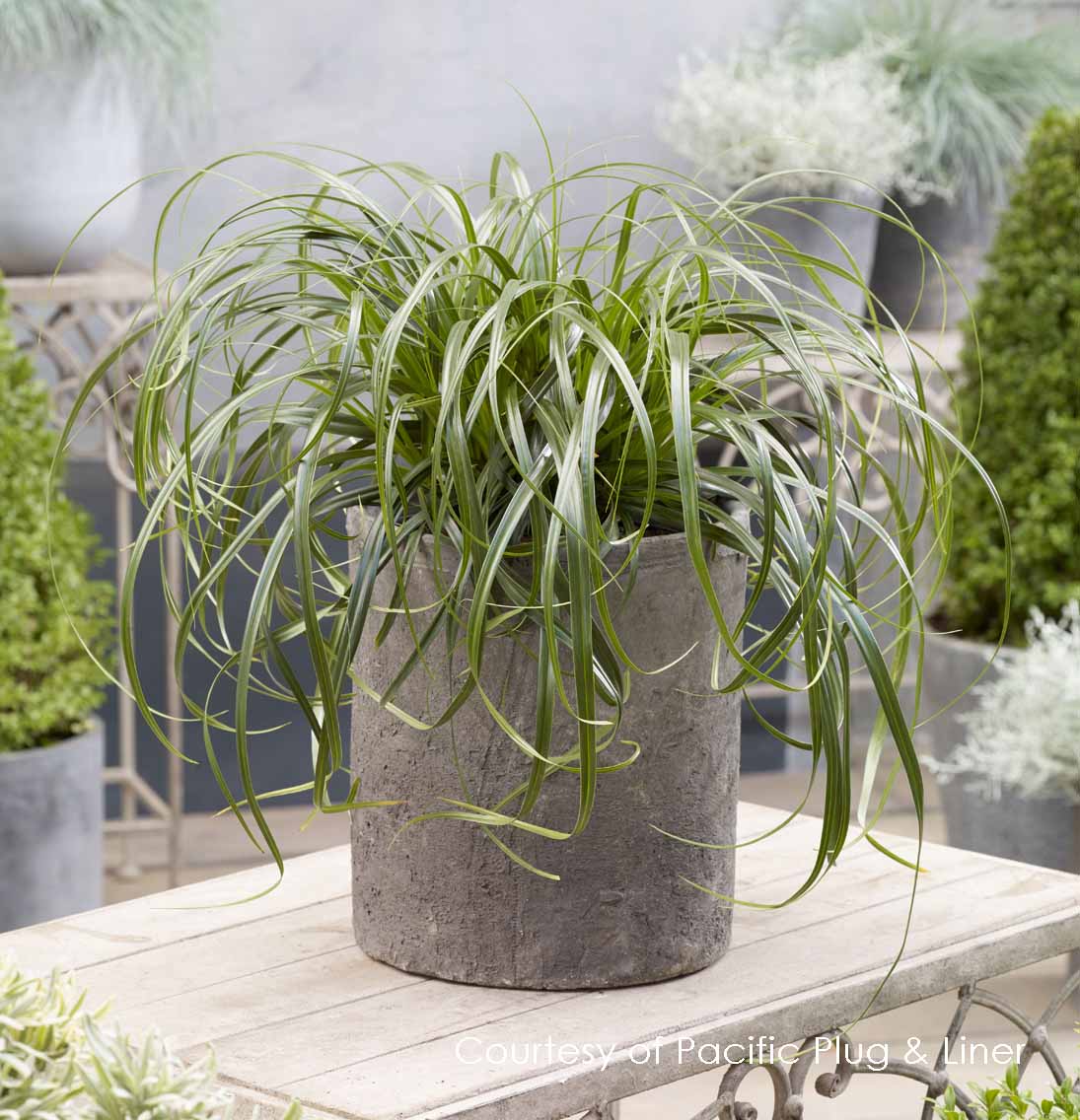
Ribbon Falls has the same arching habit as Feather Falls, but sports glossy green, solid foliage. It’s a fantastic alternative to Liriope and a versatile choice for landscape and container plantings. It’s the spiller that won’t stop, and it sails through the seasons. Pop it in with showy combos to magnify their effects and provide contrast. It’s a smart addition to any grass program. See full plant profile here
And now, watch the video!

To see what’s currently stock, check our availability. If you have questions about availability or would like to chat with us about these plants, give us a call at (800) 203-8590 or email us at sales@hoffmannursery.com.
After skipping 2020, we were thrilled to hold Hoffman Market again this year. Our team donated hundreds of gently used items to set up a market where employees could browse and take home what they wanted. After masking up, we “shopped” the market using special Hoff Bucks instead of cash. For every Hoff Buck spent, the nursery donated a dollar to the Food Bank of Central and Eastern North Carolina. Unsold items at the end of the market were donated to TROSA, a comprehensive, long-term, residential substance abuse recovery program in Durham, North Carolina.
This was our first Hoffman Market since the pandemic began, and we worked in protocols to keep everyone safe and comfortable. We are proud of the team members who organized the event and grateful for everyone who donated items and shopped. It felt great to have the market again! It’s a fun and meaningful way to contribute to our nursery and the broader community.
Join the fun with a peek at Hoffman Market in the video below.

Fall is a big season for landscape contractors, and we get loads of requests for plants. Many of those requests are for green infrastructure (GI) projects such as biorention cells, and alternatives to turfgrass or mulch. Our plants for GI chart suggests grasses and sedges for a range of project types, so it helps focus the search. But it can still be hard to choose.
To gain some insight, we asked several professionals who work on green infrastructure projects to tell us about a few of their “go-to” plants. Below, we tell you a little about each person and their thoughts on picks from our GI chart:
Andy Fox, FASLA, PLA, is in the Department of Landscape Architecture and Environmental Planning at NC State University. He co-directs the Coastal Dynamics Design Lab and leads several projects aimed at building resilience in North Carolina communities using GI and low impact development. Here are two of his “absolute favorites.”
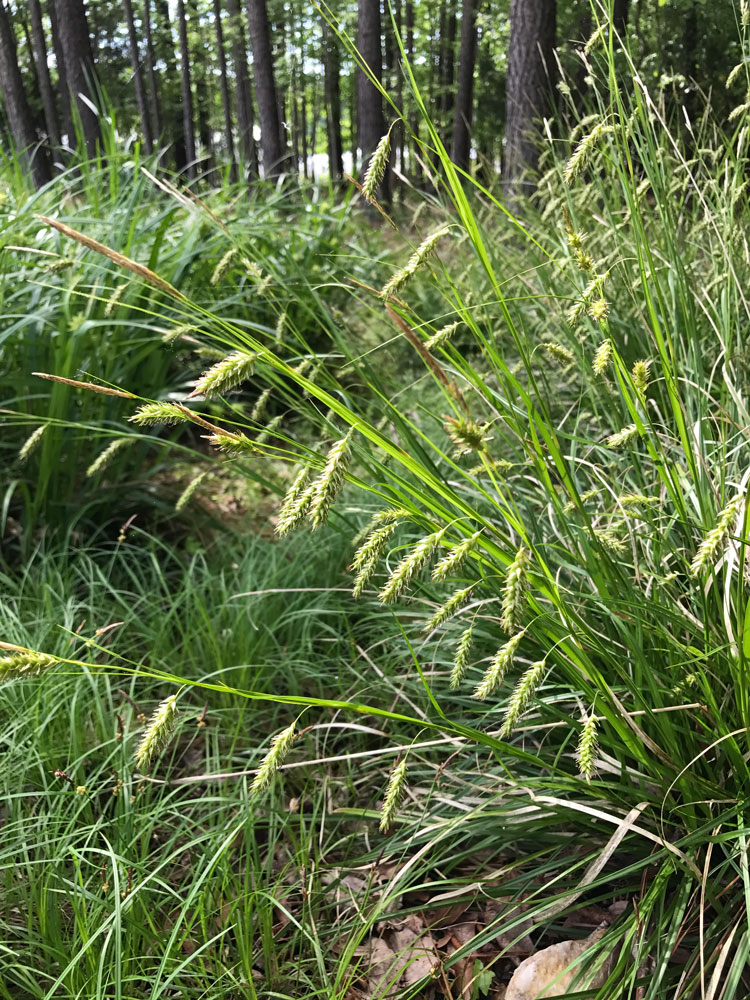
Ann English, PLA, LEEP AP, CBLP D+I, manages the RainScapes program for Montgomery County, Maryland. The program is part of the county’s Department of Environmental Protection. It aims to reduce stormwater runoff and improve the environmental performance and aesthetic appearance of private properties. The programs advises and assists property owners with landscape and design techniques that reduce stormwater runoff. Ann is a serious plant person and is constantly testing out options on installations. She gave us feedback on several plants; here are a few of her go-to selections:

Donna Evans is with Montgomery County, Maryland’s Department of Environmental Protection. She’s a program manager for BMP Inspection and Maintenance, so she’s on the front lines of stormwater control measures. One of her biggest considerations is minimizing the resources it takes to remove vegetation in the spring. Cutting back huge quantities of plants can be costly and time-consuming. Although she sees Panicum virgatum cultivars do well in GI features, she recommends limiting them to a small portion of the project. Below are a few of her go-to plants:
Kate Ancaya, PLA, ASLA, LEED AP, is co-founder of Living Roofs, an award-winning company specializing in the design, installation, restoration, and maintenance of green roofs throughout the Southeast. They’ve been in business since 2006 and have been buying from us for 10 years.
Kate says they like to use a mix of cool-season and warm-season grasses to help cover and shade the soil, add different textures, and provide an opportunity for the different species to migrate and colonize where they are most happy.
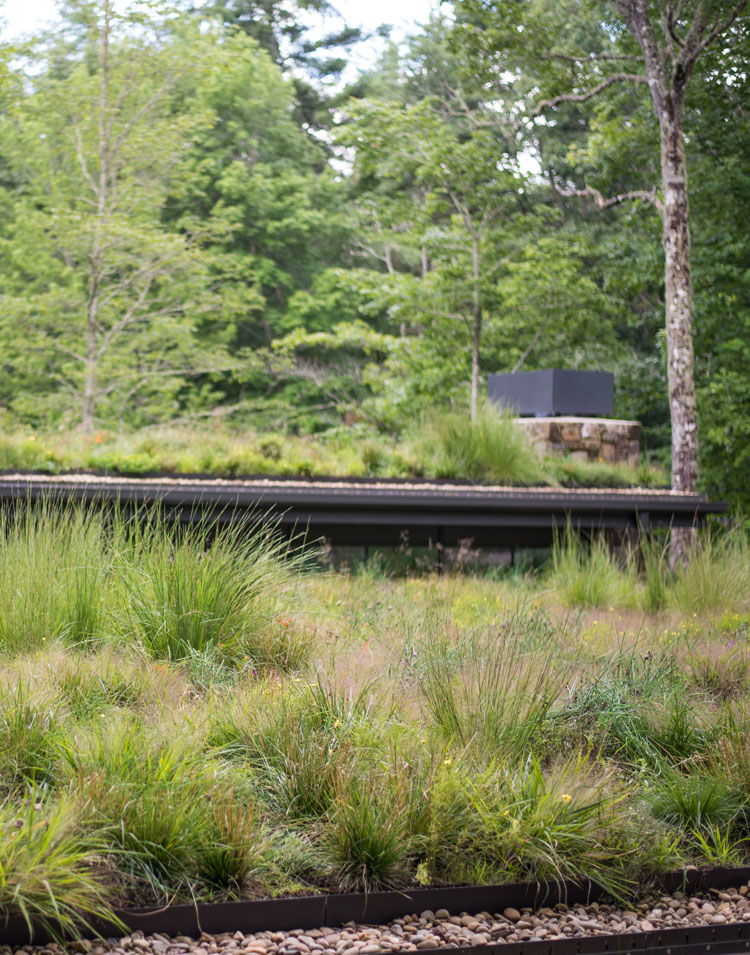
Her warm-season go-to grasses:
They rely heavily on cool-season grasses as a functional layer to provide beautiful early green color and delicate blooms. Some favorites include sedges (Carex spp.), Deschampsia flexuosa (Hair Grass), and Nassella tenuissima (Mexican Feather Grass).
Kate also suggested several grasses we grow but didn’t have listed on the GI chart as good for green roofs. We created a separate post about those. Read More Grasses for Green Roofs to see what we added.
Thanks to these practitioners for taking time to share their expertise and experience!
To learn more, visit our green infrastructure page, which includes information and links to more resources.
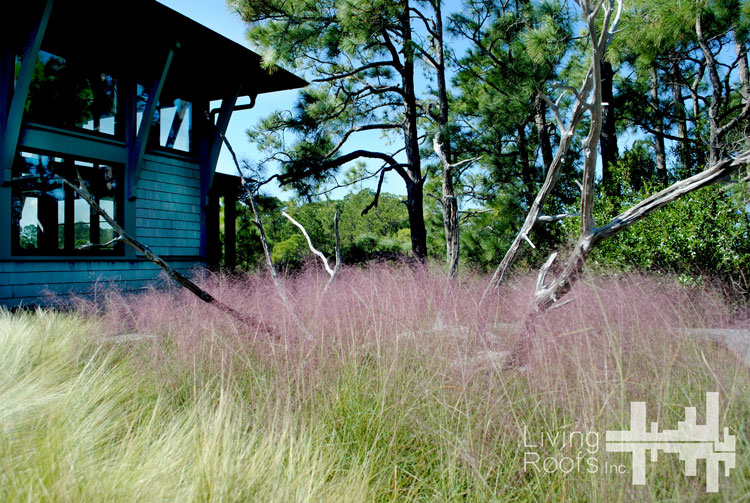
This post is a doubly happy one. Input from one of our favorite customers has expanded our offerings for green roof plants. How’s that for teamwork?
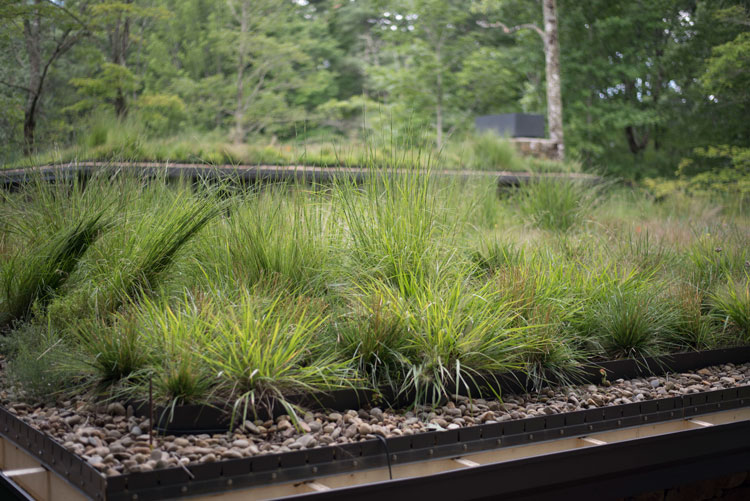
Landscape architect Kathryn Ancaya recently reviewed our plants for green infrastructure chart when we asked about her go-to grasses. Kate is co-founder of Living Roofs, an award-winning company specializing in the design, installation, restoration, and maintenance of green roofs throughout the Southeast. They’ve been in business since 2006 and have been buying from us for 10 years.
Based on their experience, Kate suggested additions to our list of grasses and sedges for green roofs. Back when we introduced our green infrastructure (GI) chart in 2015, we listed just a few grasses for green roofs. We went with those that had solid backing for inclusion, knowing that there could well be others that would work. And that’s where input from customers like Living Roofs makes a difference. Their company has hands-on experience with our grasses, and they maintain and follow up on projects.
We’re delighted to add these plants to our recommendations for green roofs:

We’ve updated our green infrastructure chart and our plant database search. As with any list, it’s not a magic bullet. You’ll still need to match your climate and site conditions to the plants. But this expanded list is a great place to start.
A big thanks to Kate and the team at Livings Roofs for their input and their work in making our communities greener and more resilient!
Do you have suggestions for updating our information? We’d love to hear from you at HNIWeb@hoffmannursery.com.
*We’re adding the cultivar ‘Goldtau’ as well.
Update 11/9/21: Kate also noted Deschampsia flexuosa as one of her favorites. Because it wasn’t part of our regular production schedule, it didn’t show up on our lists. But we have special crops coming available late winter and mid-spring of 2022. That’s great news—it’s now back on our list, and you can get it!
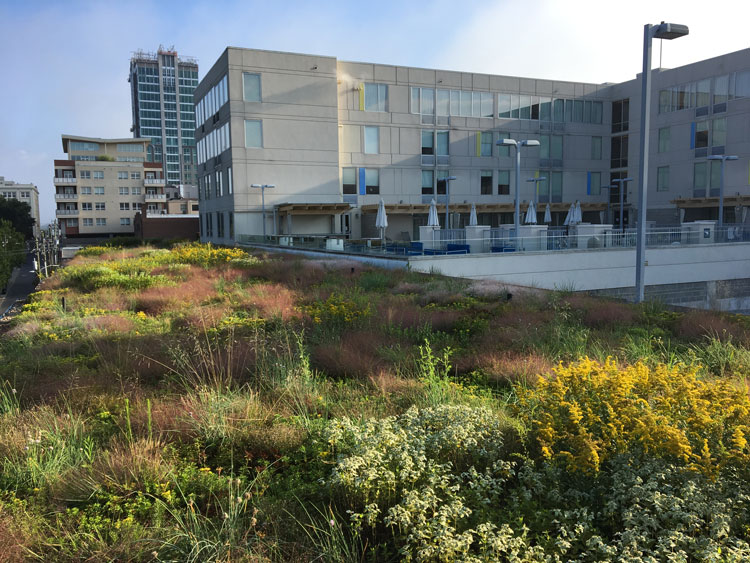
PRESS RELEASE - For immediate release
Contact: Shannon Currey ǀ Marketing Director ǀ 919-479-6620 ǀ shannoncurrey@hoffmannursery.com
Hoffman Nursery Keeps Moving with New Logistics Manager
Rougemont, NC (Oct. 4, 2021) ─ Hoffman Nursery, Inc. continues to strengthen its team with the hiring of a new logistics manager. Manny Martinez joined the nursery in July 2021 with over 20 years of experience in distribution and logistics. He specializes in team building and is responsible for educating other team members on using strategic implementation and improving efficiency, including lean process and company collaboration. His team ensures customers get accurate, timely, and cost-effective shipments of the highest quality plants.

Before joining Hoffman Nursery, Martinez managed logistical operations for Goodwill Industries, Walmart, and Burlington Coat Factory. He was brought onto the team when the nursery’s longtime shipping manager transitioned to full-time work on his family farm. As logistics manager, Martinez manages the entire shipping process and oversees facilities personnel. He handles permitting and communicates with all the shipping vendors to keep a steady and timely flow of plants into and out of the nursery.
Martinez’ combination of positivity and boundless energy encourages others to work hard and do their jobs well. In his free time, he likes to hike and explore museums. He’s an avid vinyl record collector and loves discussing music. He has enjoyed learning the specifics of the nursery and has connected quickly with his new team. Says David Hoffman, Senior Director of Sales and Operations, “Manny’s experience and resourcefulness make us confident we can navigate logistical challenges—even those intensified by the pandemic—while delivering high-quality plants and service.” As for Martinez, he’s “all in,” and the nursery’s customers will be happy to know he’s on the job!
About Hoffman Nursery, Inc: Founded in Rougemont, North Carolina in 1986, Hoffman Nursery specializes in ornamental and native grass liners for the wholesale trade. With a core purpose of promoting better living through plants, they grow over 140 species and cultivars of grasses, sedges, and grasslike plants, and ship to wholesale customers across North America. Since its founding, the nursery has expanded to include a state-of-the-art greenhouse and production facility and over 60 cold frames and hot houses.
The Fall Equinox has arrived. The North American native prairie grasses are coming into season. What’s getting noticed? Little Bluestem. Its kaleidoscope of colors—oranges, pinks, reds, burgundy, copper—are starting to shine bright.
There’s a lot to love about Little Bluestem. It’s tough and adaptable, tolerant of a range of moisture conditions from average to nearly arid, and is able to grow on both acidic and alkaline soils. Quick establishment on disturbed soils makes it perfect for banks and slopes, meadows, prairies, restoration projects, and urban landscapes. It gives food and shelter to wildlife and attracts birds and butterflies. The Perennial Plant Association made an excellent choice naming this beauty and its cultivars 2022 Perennial Plant of the Year®. You can count on Little Bluestem for your growing program and landscape project needs.
For this post, we’ve chosen a few of our current Schizachyrium scoparium favorites to show their fall colors:




You can access full profiles for these selections and the other Little Bluestem we grow here. To see which cultivars are in stock, please check our availability. Be sure to order or reserve your plants now. Little Bluestem is known for going fast!
Looking to learn more about Little Bluestem? You can dig deeper here. To help choose the best cultivars for your needs, try downloading our Little Bluestem Comparison Chart. And for a fun take on this natural beauty, check out our Little Bluestem infographic.
PRESS RELEASE - For immediate release
Contact: Shannon Currey ǀ Marketing Director ǀ 919-479-6620 ǀ shannoncurrey@hoffmannursery.com
Hoffman Nursery Energizes Team with New Operations Manager
Rougemont, NC (Sept. 20, 2021) ─ Hoffman Nursery, Inc. has energized their team with the addition of Craig Reynolds as Operations Manager. He joined the nursery in June 2021 and works closely with David Hoffman, Senior Director of Sales and Operations, to oversee daily operations and manage production, growing, and logistics.
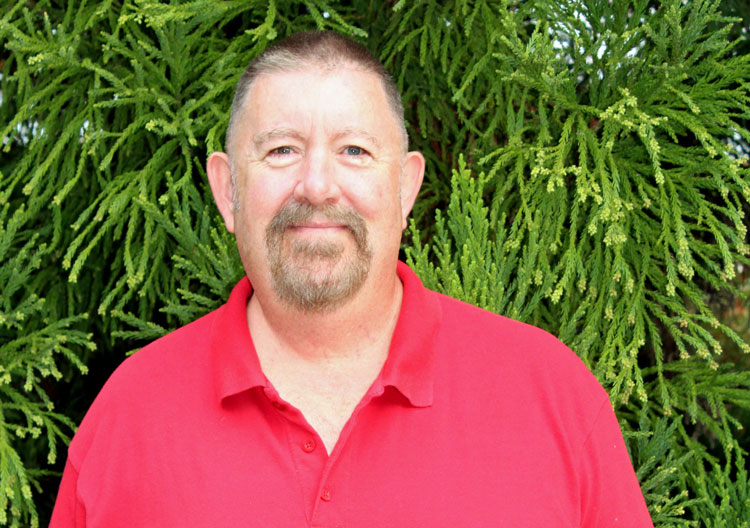
Hoffman Nursery is facing the same challenges many others in the industry are. Supply chain disruptions, labor shortages, and new safety protocols require enormous investments of time and energy. The senior management team realized there was a role that needed to be filled, and they brought in an expert. Reynolds has held marketing, revenue, and operation positions with several Fortune 500 companies, spearheading improvements in internal processes and customer satisfaction within each. At Hoffman Nursery, he has already implemented numerous initiatives to increase productivity and improve the customer experience.
According to David Hoffman, “Craig is focusing on efficiency in our operations and is helping coordinate across our supply chain. He’s successfully managed large, international teams with complex operations, and he’s applying those organizing principles here.” All departments in the nursery operations are getting a thorough review to analyze and upgrade their practices. With Reynolds on board, the nursery recently signed a contract to utilize the H-2A program, which will give it a more stable, reliable workforce in the future. Improvements in processes will keep the company focused on its core values and fulfilling customers’ needs.
Prior to joining Hoffman Nursery, Reynolds traveled the world while employed by Royal Caribbean Cruise Lines as Marketing and Revenue Manager. In his free time, he enjoys gardening, reading, and is an avid diver. His bucket list includes taking an African Safari someday. Meanwhile, he’s enjoying exploring the nursery world and getting to know a new team.
About Hoffman Nursery, Inc: Founded in Rougemont, North Carolina in 1986, Hoffman Nursery specializes in ornamental and native grass liners for the wholesale trade. With a core purpose of promoting better living through plants, they grow over 140 species and cultivars of grasses, sedges, and grasslike plants, and ship to wholesale customers across North America. Since its founding, the nursery has expanded to include a state-of-the-art greenhouse and production facility and over 60 cold frames and hot houses.
In the wholesale trade, getting the plants you need when you need them can be challenging, especially in the current environment. Our Sales Team has a few tips to make sourcing grasses and sedges easier.

1. Design from Availability Rather than the Catalog.
Current availability is your best tool for knowing which plants to include in your planting plan. Our catalog (and website) helps you decide which plants are appropriate based on the site and cultural requirements. Availability is where “the rubber hits the road.” Current availability shows which plants are in stock and the forecast for when future crops will be ready.
If you see current or future crops listed within the timeframe of your project, then they’re good candidates for your plan. Even better: reserve them as soon as your selections are set. If a plant does not show current or future crops during your project timeframe, opt for a different selection that does.
2. Check Availability Often
We do have cancellations, so sometimes a crop that wasn’t available will pop up. Think of it as a treasure hunt—if you’re looking, sometimes you’ll find gems! It never hurts to look, even if you’ve checked in the past. To make it even easier, if you’re a wholesale customer, sign up to have availability delivered to your inbox automatically.
3. Get Advice from our Sales Team
Our team knows grasses. They can make recommendations and help you choose the best plants for your program or project. They can also help you with scheduling and suggest alternatives when selections are limited.
For answers, suggestions, and all things grass, give our expert team a call (800-203-8590) or send an email!

We are beyond excited that the Perennial Plant Association (PPA) named Schizachyrium scoparium and cultivars the 2022 Perennial Plant of the Year®. Known commonly as Little Bluestem, it has high ecological value and low maintenance needs. It’s easy-care, unfussy, and beautiful.
What makes it a Perennial Plant of the Year®? Let’s break it down based on PPA’s criteria:
Suitable to a wide range of growing climates
Low maintenance requirements
Multiple seasons of interest
Relatively pest- and disease-free
Little Bluestem and its cultivars shine on slopes, in prairie plantings, in perennial beds, and as refreshing additions to containers. They provide food and shelter for wildlife, including birds and butterflies. These grasses withstand the rigors of shared public spaces—parking lots, roadsides, parks, and street plantings—and help make them greener and more beautiful. This is a grass for now and for the future.
For a fun take on Little Bluestem, see our infographic below or download it here. For a deeper dive, explore our page on Schizachyrium. You can also browse our collection or get a quick comparison of the cultivars we carry with our Little Bluestem Chart.
We expect Little Bluestem and its cultivars to get a boost from being named 2022 Perennial Plant of the Year®. With increased demand and the supply chain issues we’re all experiencing, crops will be limited. So make sure you are booking ahead. Let’s give this wonderful grass the spotlight it deserves!


It’s Pollinator Week! Grasses and sedges are often overlooked when it comes to pollinators. But they not only provide food and nesting material for butterflies and native bees, they also serve as the foundation for a designed plant community. Their bunching habit and extensive root systems boost their ecological value. They slow stormwater, reduce erosion, and sequester carbon. They also support other wildlife like birds and small mammals.

The Big Four
These four North American native grasses are great choices for pollinator-focused gardens. They’re most often cited as supporting pollinators and are readily available. They also come in a range of cultivars with high ornamental value.
Other Great Grasses with Pollinator Value:
The Power Sedges
Although they look like grasses, sedges are found in Cyperaceae, a different family from true grasses. These four native sedges support pollinators as pollen sources or as larval hosts:
Many of our other native sedges support pollinators, too. Sedges aren’t as familiar (or as studied) as grasses are. Fortunately, it’s hard to go wrong adding native sedges to pollinator gardens. They provide an underlayer for other woodies and perennials—helping suppress weeds and supporting wildlife. We are confident other native sedges like Carex laxiculmis, Carex cherokeensis, Carex amphibola, and Carex grayi will be worth space in your projects or programs.
And don’t overlook another grasslike plant—the common rush. Juncus effusus is a powerhouse when it comes to wildlife. It serves as a food source for caterpillars, birds, and mammals, and it provides cover and nesting sites for birds.
The grasses and grasslike plants listed here are just a start—other species also have value for pollinators. Check out these sources as starting points:

From parking lots to the roofs of buildings and beyond, green infrastructure (GI) is popping up everywhere. GI uses plants, soils, and natural systems to manage stormwater and add ecological function. Whether they’re supporting wildlife, adding recreational space, or lifting our mood, GI projects improve the health of our communities and our surroundings. GI will be important in meeting the challenges that come with increased development and climate change. It also offers new opportunities for the green industry. That’s why we want to help you get into GI, too!
Ready to learn more? Then we’ve got two fantastic recommendations for you.
Our green infrastructure page is great place to start, even if you’re already familiar with the concept. Many of the grasses and sedges we grow add valuable function to projects like bioretention cells, finding alternatives to turfgrass, or planting a green roof. Our GI chart helps narrow the choices, and you can see which grasses and sedges North Carolina recommends for bioretention and stormwater wetlands.
The other recommendation is to attend Grey to Green.

The 2021 Grey to Green virtual conference takes place June 15-16. This year’s focus is Designing For Tomorrow: Green Infrastructure and the Post-COVID-19 Recovery. Through videos, panels, expert speakers, and networking sessions, the conference will highlight a wide range of best practices in designing and implementing green infrastructure and other nature-based solutions. They’ll address public health concerns made worse by the pandemic, while building community resilience.
The content at Grey to Green is curated to inspire and elevate the work of engineers, architects, designers, landscape architects, policymakers, city planners, advocates, researchers, manufacturers, students, business professionals, water management and green infrastructure experts, and all those interested in sustainable development!
As a corporate member of GRHC, Hoffman Nursery is proud to support and promote this upcoming event.
PRESS RELEASE - For immediate release
Contact: Shannon Currey ǀ Marketing Director ǀ 919-479-6620 ǀ shannoncurrey@hoffmannursery.com
Hoffman Nursery Promotes Trevor Stark to Production and Propagation Supervisor
Rougemont, NC (March 15, 2021) ─ Hoffman Nursery, Inc. has promoted Trevor Stark to Production and Propagation Supervisor. Stark will oversee the entire production process, from working with seed propagation, to maintaining the production facilities, to supervising the production and propagation teams. He will assist Production Manager Brice Davis and the planning team in creating weekly production plans and schedules to support yearly sales goals. He will also work closely with the Growing Team to optimize plant transition between their department and production.

Stark brings a valuable set of skills and experience to his new position. He started at the nursery as a seasonal worker while attending North Carolina State University. The following summer, he completed an internship with the nursery, rotating through each department. He got to know the teams, forged relationships, and made notable contributions to the nursery. When he completed a bachelor’s degree in Horticultural Science in 2017, he joined Hoffman Nursery as a Section Grower.
Being familiar with the nursery, Stark took on full duties quickly. He progressed from taking care of a range of cold frames to overseeing the nursery’s state-of-the-art greenhouse. He mastered the intricacies of water boom irrigation, chemigation, and other newer technologies to manage his crops. He also oversaw weekly fertility monitoring across the nursery and evaluated all incoming tissue culture liners. Head Grower Bill Hall supervised Stark during his tenure in growing. According to Hall, “Trevor’s skillset and experience have greatly prepared him for this position. He knows the nursery, he knows grasses, and he brings a grower’s sensibilities to the production realm.”
Stark is a native of Mint Hill, North Carolina, and he brings a positivity to the workplace that is infectious. He always has a smile on his face, is always willing to help, gets along with everyone at the nursery, and exemplifies our core values. He also has a deep-seated love for horticulture that is apparent in his work. He is attuned to the plants in his care, and he’s eager to expand his role into production. David Hoffman, Senior Director of Sales and Operations for Hoffman Nursery, counts this promotion as a win for the nursery and its customers. “Trevor has played a key role in our Growing Department for over 3 years. He’s been on the receiving end of the production process and knows what issues to keep an eye on,” says Hoffman. “He understands what is needed to produce a high-quality crop of grasses.”
Stark began his new position on February 22, 2021.
About Hoffman Nursery, Inc: Founded in Rougemont, North Carolina in 1986, Hoffman Nursery specializes in ornamental and native grass liners for the wholesale trade. With a core purpose of promoting better living through plants, they grow over 140 species and cultivars of grasses, sedges, and grasslike plants, and ship to wholesale customers across North America. Since its founding, the nursery has expanded to include a state-of-the-art greenhouse and production facility and over 60 cold frames and hot houses.
Yes, we know. Our availability is a little sparse right now. Many crops aren’t available until later in 2021 or even next year. We thought a little Q&A was in order.
WHY DO PLANTS SELL OUT?

Business is booming. Many of our customers rolled over last year’s orders or booked their orders back in 2020. Last year, more bookings for 2021 came in than ever before. On top of that, demand in 2021 is high and sales continue at a record pace. Most of our sold-out crops right now are due to demand, and that’s good news.
Crops with a limited window of availability. Several crops are produced only in the spring or at certain times of the year because of their propagation or growing requirements. Some cool-season grasses like Helictotrichon sempervirens ‘Sapphire’ must be shipped early enough to avoid our summer heat, so they’re not available later in the season. Some sedges have a long production cycle, so we’re limited in how many rounds we can fit in the production schedule. For most of these crops, once they’re gone, they won’t be available again until the following year or next seasonal production round.
Crop issues. When you grow live plants, there are many factors beyond your control. Weather, the supply chain, pest pressure, and other factors can affect production schedules and ready dates.
WHAT ARE MY OPTIONS IF A PLANT I WANT IS SOLD OUT?
Ask about a sub. Our sales team can often suggest a substitute that’s in stock or available sooner. For example, we’re sold out of Bunny Blue® Sedge (Carex laxiculmis ‘Hobb’) for 2021, but the lesser-known Carex flaccosperma is in stock and makes an excellent substitute.

Wait for the next crop. There’s often a crop available later in the growing season. For example, we’re sold out of Schizachyrium scoparium ‘Twilight Zone’ now but will have another crop ready the last week in July. Check the “Upcoming Crops” section of our current availability to see the next ready dates for the plants you want.
HOW DO I GET AHEAD OF THIS?
Order early. The earlier you book plants, the more likely you are to get them. We book orders one and even two years ahead. Ordering early ensures we include your needs in our production schedule and gives you priority. When demand is high, we may max out our production and shipping capacity. This season, early bookings sold out entire crops, and we’ve reached our limit for shipping new, large orders in May or June. Those new orders will have to wait until early July to ship.
Roll over this year’s order. We’re happy to take your current order and repeat it for the following year. Once you get through the growing season and see what your needs are, we can adjust it. We know the order may change but having it on the books is your placeholder. It makes it far more likely you’ll get the plants you need.
The good news is we are making more grasses and sedges, and we continue to upgrade our operations. We’re striving to get you the plants you need when you need them. We appreciate your patience and booming business!
Festuca ‘Elijah Blue’ and Calamagrostis ‘Karl Foerster’ get a lot of attention. But when it comes to cool-season grasses, it pays to look beyond the superstars. We suggest you try these equally excellent grasses that give spring sales and early season plantings a boost that’s a little different.

Bright, beautiful, and lush. This white and dark-green variegation on slow-spreading grass pops in shady conditions. Arrhenatherum elatius subsp. bulbosum ‘Variegatum’ is best suited for cooler climates; it will melt in the heat of our Southeastern climate. The current crop must ship by April 1, 2021 to ensure it’s fresh and bright when it arrives.

Bright blue, glaucous foliage and a creeping habit make this European selection an excellent groundcover for dry, sunny sites. In spring, straw-colored seed heads emerge above the foliage. Put it where spreading is desirable or use in containers for a fresh look.
Variegated Selections of Feather Reed Grass (Calamagrostis x acutiflora)
‘Avalanche’ – with green on the outer margins and white down the middle of the blade, ‘Avalanche’ shows its stuff in the spring. The clump of basal foliage tucks neatly into color beds and mixed perennial borders. Its silver plumes shoot up above the foliage in spring and persist well into the season. Overall, a shorter, more compact plant than ‘Karl Foerster’.
‘Overdam’ – variegation on this selection is the opposite of ‘Avalanche’. ‘Overdam’ has cream white stripes along the margin surrounding a green center. It’s slightly shorter and produces similarly showy seed heads.
‘Eldorado’ – conjuring the myth of El Dorado, the lost city of gold, this selection sports gold and green variegation. Its stems maintain a honey hue and enhance the ornamental look. It tends to be a bit taller than the other two variegated selections and slightly shorter than ‘Karl Foerster’.

During MANTS 2021, Hoffman Nursery hosted virtual “Chat with the Breeder” sessions focused on our newest selections. This recording includes a quick video about Chameleon Little Bluestem from Thierry and Sandrine Delabroye, followed by a great Q&A session with attendees, John Hoffman, David Hoffman, and Peter van Rijssen from Concept Plants.

During MANTS 2021, Hoffman Nursery hosted virtual “Chat with the Breeder” sessions focused on our newest selections. This recording includes a chat between Dave MacKenzie and John Hoffman, followed by excerpts from the attendee Q&A. Dave MacKenzie’s work with native grasses and his experience growing them made for some great conversation and helpful insights.
To see our full profile for Andropogon gerardii Karl’s Cousin® (‘Nondhwr’), visit our plant profile.

Our virtual “Chat with the Breeder” sessions during MANTS 2021 focused on our newest selections, and they were a big hit. We recorded these sessions and recently released our second one to share with our friends and followers.
This recording includes a chat between Pat Fitzgerald and John Hoffman, followed by excerpts from the attendee Q&A. In this discussion, Pat gave us an inside look at Carex morrowii EverColor® ‘Everglow’ PP30466 and others in the EverColor® family. Check out the video of their session below!

Our virtual “Chat with the Breeder” sessions during MANTS 2021 focused on our newest selections, and they were a big hit. We recorded sessions and recently released our first one to share with our friends and followers.
This recording includes a chat between Piet Oudolf and John Hoffman, followed by excerpts from the attendee Q&A with John and David Hoffman. In the discussion, Piet talked about our newest Switchgrass, Panicum virgatum ‘Purple Tears’ PP28518. He also gave a preview of several new Moor Grasses and a stand-out Little Bluestem called ‘Ha Ha Tonka’. During the Q&A John and David answered questions regarding bloom time, zone, popularity, and why we are excited about these plants. We hope you will check it out!

As we release more recordings, we’ll give you a heads up here on our blog, and will post links in multiple places: our Virtual Events page, our GrassSolutions Newsletter, our MANTS.com Business Hub profile (available through April 9th for MANTS attendees), and social media.
Throughout October, we’ve been highlighting green infrastructure and green public spaces along with plants that add ecological function to these projects. In this post, we wanted to give a shout-out to six plants that deserve attention. If you’re designing, growing, or sourcing plants for green infrastructure—especially stormwater projects—these plants should be on your list.
All are plants we’ve tended to grow only when requested. However, to meet the demand for green infrastructure, native species, and well-adapted plants, we’ve added them to our regular production roster. They’re available now (or very soon) for fall planting or for potting up and overwintering.
Let’s take a quick look at this green six-pack.

Great for: rain gardens and bioretention, bioswales, wet meadows
Standout features: Fluffy plumes, reseeding capacity, wildlife support
Quick facts: warm season; green foliage; 4’ height, 6’ with blooms; sun; average-wet; flowers early fall; zones 5-9; native to eastern North America
Great for: lawn alternative, reducing erosion
Standout features: fast spreader, grey- to blue-green foliage
Quick facts: warm season, grey-green to blue-green foliage; 4-6” height, 6-8” with blooms; sun; dry-average; flowers late spring; zones 4-8; origin: central plains of Canada & U.S., South to Mexico
Great for: rain gardens and bioretention, low-profile filler in partial shade
Standout features: appealing seed heads, shade tolerance
Quick facts: warm season; green foliage; 2’-3’ height, 2.5’-3.5’ with blooms; shade-part sun; moist-dry; flowers midsummer; zones 4-9; origin: Southeastern and East Coast U.S.
Great for: reducing erosion, showy fall display, dry conditions
Standout features: beautiful plumes, drought tolerance
Quick facts: warm season; blue gray foliage; 4-5’ height, 5-6’ with blooms; sun; dry; flowers early fall; zones 7-10; origin: Texas, Mexico
Great for: rain gardens and bioretention, bioswales, stormwater wetlands, pond edges
Standout features: intricate seedheads, wildlife support
Quick facts: cool season; green foliage; 4’ height, 6’ with blooms; sun-part shade; wet-average; flowers midsummer; zones 4-9; origin: Eastern North America
Great for: rain gardens and bioretention, bioswales, reducing erosion, substitute for Miscanthus
Standout features: showy plumes, sculptural habit, adaptability
Quick facts: warm season; green foliage; 3’-5’ height, 6’ with blooms; sun; dry-wet; flowers early-midsummer; zones 5-9; origin: Southwestern U.S.
This green six-pack of native species deserves a second look. Find a place in your projects for these selections!
For more great grasses and sedges for green infrastructure, big projects, and native plantings, search our plants database. You can also refer to our handy chart that calls out plants for green infrastructure. For more information and to book any of our plants, contact our sales team by email or phone 919-479-6620.
Fall planting is going strong here in the Southeast. Our autumns are long and mild, and plants have time to settle in before winter arrives. We see increased demand every year around this time from landscape contractors. Many opt to plant liners—also called plugs—directly in the landscape rather than using larger, finished sizes. It’s a smart choice when their projects allow, especially when there’s a lot of ground to cover.
With our liners, you get:

There are good reasons to go with smaller sizes:
Liners have limited soil volume, which limits vegetative growth. However, the plant continues to photosynthesize, and the excess energy that is not put into growth is stored for future use. When it comes time for planting into the landscape (or larger containers) liners have stored energy that’s ready to go. When planted, liners burst into action, catching up to larger, finished plants in one or two growing seasons.

Why spend more than you need to? Liners are far less expensive than gallons, so it costs less to cover the same area. If you’re interested in planting more densely, double the number of liners and still beat the gallon price. With grasses, their low water and fertilizer requirements mean spending fewer resources to establish and maintain them.
Hoffman Nursery stands out in the trade for what we offer our customers.
Sourcing plants for landscape projects can be challenging. Get the grasses you need. Give us a call or email our sales team.
To download the PDF that goes with this post, click here.

Our core purpose at Hoffman Nursery is to promote better living through plants. We feel this purpose is more pertinent now than ever. We always believed in the connection between plants and the well-being of people, creatures, and our planet. Today, research shows that exposure to the natural world benefits human beings in more ways than imagined. Parks and playgrounds, public gardens, and other green spaces give us opportunities to explore, dream, and experience the joy of being outdoors. Our 2020-2021 Catalog of Grasses honors these spaces, along with the hope and joy they give to us all.
This year’s cover image comes from the Sassafras All Children’s Playground in Raleigh, North Carolina. You will also find more photos of the playground throughout this year’s catalog. It’s a beautiful, vibrant place in our community that’s full of perennials, bulbs, grasses, and self-seeding annuals. But these plants aren’t just pretty—they are vital to the well-being of our communities.

This year’s catalog is packed full useful charts, bigger photos, and updated content. Browse plant profiles, compare cultivars, and choose the right selections for your program or next project. Here is a quick glimpse of what this year’s catalog offers:
The catalog will be hitting mailboxes in early August. For our online fans, or if you just can’t wait to get it in the mail, you can access an electronic version of our catalog now on our website at hoffmannursery.com/view-catalog
Thank you for your continued support of Hoffman Nursery. Wishing you happiness, safety, and good grasses for the second half of 2020!

We know green spaces play a vital role in our health and well-being. That’s why growing plants that make our landscapes work and provide ecological functions is so important. In this post, we highlight a few GrassSolutions™ that are sensible and stylish choices for covering the ground.
What’s the big deal about ground covers? They reduce costs while offering big benefits. Ground covers help prevent weeds by competing for open ground and other resources. They hold in the soil and reduce erosion. They slow and filter runoff, reducing pollutants that flow downstream into rivers, lakes, and oceans. That translates to cleaner water for everyone. In shady or partially shady spots where turfgrass rarely thrives, they’re easier to establish than traditional lawns. And they don’t need to be mowed.
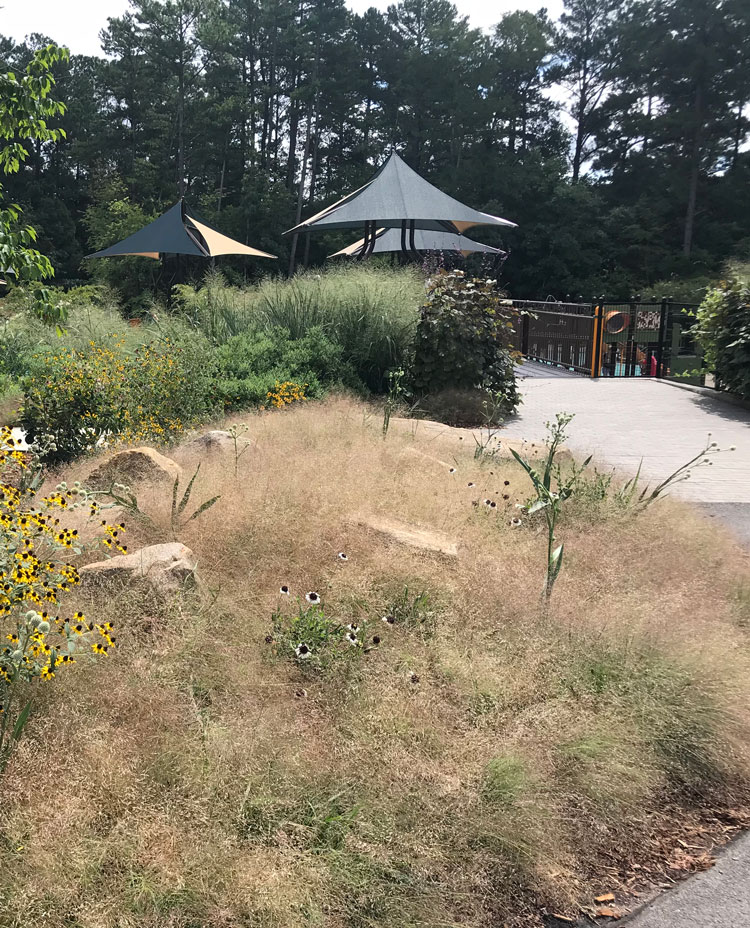
With a ground cover in place, you’re doing all kinds of great work while using minimal resources.
Many of the low-growing grasses and sedges we offer are excellent ground covers. Low-key, green selections like Rosy Sedge provide a backdrop for showier plants and make bright colors pop. Eye-catching selections like Golden Variegated Hakone Grass and Blue Sheep’s Fescue offer delightful habits and captivating colors for visual interest all season.
Here are a few suggestions based on currently available crops. For descriptions and photos, click on individual plant names to see plant profiles. From there you can link to availability to see quantities and sizes, or go directly to our availability page.
Blue Sheep’s Fescue – Cultivars of Festuca glauca, ‘Elijah Blue’ and Beyond Blue (‘Casca11’), are cool and bright with a fun, spiky look. They love full sun, but in hot, humid climates they tend to struggle and will benefit from afternoon shade.
Purple Love Grass – It’s a North American native found in open, sunny fields and meadows. In tough, dry spots, Eragrostis spectabilis brings a low carpet of pinkish-purple blooms to the party.

Hakone Grass cultivars – Hakonechloa macra ‘Aureola’ and ‘All Gold’ sparkle in shady spots with graceful, cascading foliage. Topping out at around 2’, they’re lush and gorgeous. They’re best suited for regions with cool summer nights and will handle full sun in cool, moist climates.
Ice Dance Sedge – this reliable, spreading sedge with bright white and green stripes forms a dense cover. Carex morrowii ‘Ice Dance’ spreads quickly (for a sedge) and is evergreen in mild climates.
Evergold and the C. oshimensis EverColor® Sedges – great performer and long-time favorite Carex oshimensis ‘Evergold’ shares the stage with the EverColor® selections. They were developed from ‘Evergold’ and offer new colors and increased vigor. Beautiful arching habits, bright colors, and evergreen foliage mean you’ll never have boring shade. ‘Everest’ and ‘Everillo’ are the two most popular in the series.
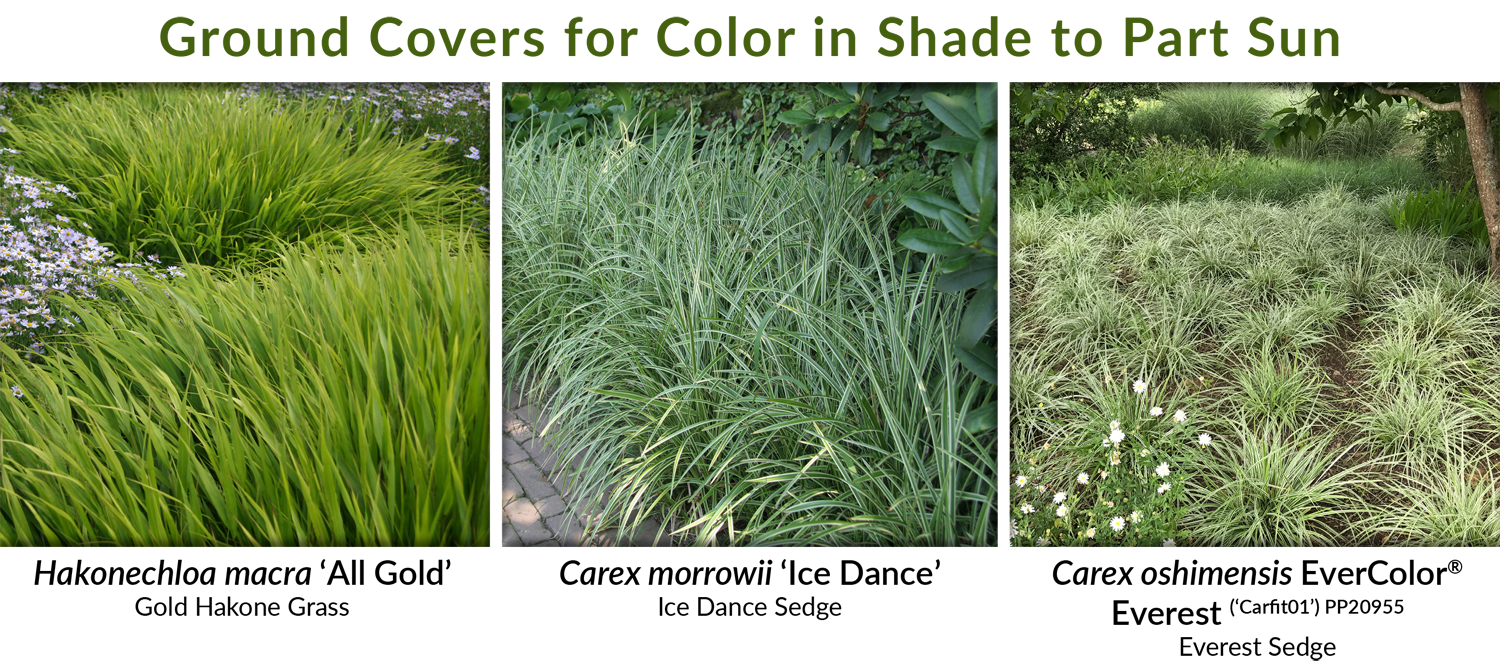
Pennsylvania Sedge – Carex pensylvanica forms a lush, green carpet. Dry shade in woodland gardens is its sweet spot. It can take some sun with moist soil. Although it does well in our dry shade garden in central North Carolina, it performs best in cooler climates.
Rosy Sedge – it’s not showy, but it works really well as an underplanting. Put Carex rosea to work covering the ground under woodland shrubs and trees, where it will make those spring ephemerals pop!


These GrassSolutions™ give you smart choices for managing and improving the green spaces that are vital to all of us. To see more grasses and sedges and to select based on your project needs, go to Our Plants.
The ultra-fine texture of Nassella tenuissima, also known as Mexican Feather Grass, is like no other we grow. Our Marketing Director Shannon Currey had admired this cool season grass, but an image from Piet Oudolf’s garden transfixed her and cemented it as a forever favorite. To remind you why we love Mexican Feather Grass (and why it belongs in your grass program), we revisit an article Shannon wrote for American Nurseryman‘s Field Notes in 2013.

It was already my favorite grass, and then the photo from Piet Oudolf’s garden grabbed me and wouldn’t let go. The photo shows a large, metal trough filled with Mexican Feather Grass. John Hoffman captured the shot in the fall of 1996 while visiting Piet’s garden in the Netherlands. The grass in the photo looks so lush, soft, and inviting that I wanted to walk into the photo and touch it. “I’ve got to have that grass,” I thought.

Working at a nursery that specializes in ornamental and native grasses, I’ve seen a lot of grasses. Nothing else looks and moves like Nassella tenuissima. Its ultra-fine foliage catches the tiniest hint of a breeze and comes alive with motion. The flowing habit has a softness and texture that is both visual and tactile. When we take it to trade shows, it’s the plant everyone touches.
Mexican Feather Grass is native to dry, rocky slopes and open grasslands in the south-central U.S., northern Mexican, and southern South America. With a background like that, it is adapted to drought and thrives in well-drained soils. Conversely, it does not tolerate water-logged soils; cold hardiness drops in poorly drained soils, particularly in colder climates. This grass is a sun lover. It can take very light shade, but full sun produces the best flowering and form.
Interestingly, Nassella tenuissima is a cool season grass. It has a flush of lime-green foliage in early spring, followed by silvery inflorescences in late spring (early summer in cooler climates). With rising temperatures, Mexican Feather Grass enters a period of dormancy, which it handles gracefully. The foliage turns straw-colored, and the form, texture, and flowing habit remain appealing. I find that combing out the spent blooms prevents matting. As temperatures cool down in fall, Nassella tenuissima gets another flush of growth that carries into winter.

The fountain-like, flowing habit on Mexican Feather Grass is accentuated by its unusual inflorescences. They’re borne on the tips of the foliage, where they emerge silvery-gold and age to a wheat-straw blonde. The blooms aren’t stiff and upright; rather, they weep gracefully. Nassella tenuissima may re-seed under hospitable conditions but can be controlled in managed landscapes.
I tend not to cut back Mexican Feather Grass until necessary. I like the mingling of green and blonde foliage. At some point, the blonde foliage will dominate, and a cutback will rejuvenate it. Do so right before a flush of growth—late winter or late summer.
Nassella tenuissima looks particularly at home in rock gardens and xeric landscapes. Its wispy, threadlike foliage contrasts beautifully with stones and hardscape, and the flowing habit spills fetchingly over walls or container edges. Because it’s my favorite, I have it planted throughout my Zone 7 landscape. It looks fantastic in my raised bed full of sun-loving, drought-tolerant perennials, where it softens the hard, brick edges. In climates where Mexican Feather Grass isn’t hardy, I think it’s worth planting for a single growing season. It thrives in the well-drained media of containers—I’m lucky enough to use it year-round in combination planters.
That brings me back to the picture of Piet Oudolf’s trough. I love it because it captures the enormous appeal of Mexican Feather Grass. And now, after looking at the photo for years, I’ve decided it’s time to follow through with a really spectacular planting. Anyone have a spare trough?

Name: Nassella tenuissima
Common name: Mexican Feather Grass
Hardiness: Zones 7-10
Mature height: 1.5 feet; 2 feet with flower
Mature spread: 1.5-2 feet
Classification: Native grass
Landscape use: Rock gardens, scree gardens, xeric landscapes, and containers. Works well in mixed perennial plantings and in color beds or containers where not hardy.
Ornamental characteristics: Fine-textured, lime-green foliage and blonde seed heads. Graceful, upright habit with flowing foliage tips that create movement in the landscape.
Visit our plant profile of Nassella tenuissima for more info and images.
Amidst the deep uncertainty caused by COVID-19, it’s encouraging to see that customers still need plants. Stories about the resurgence of gardening and a renewed interest in landscapes are great news. And we know that the green spaces we’re contributing to help make people healthier.
At the nursery, we’ve been finding ways to continue operating during the pandemic restrictions. To adhere to social distancing, we had been splitting our teams into separate shifts. That allowed us to continue working, but it reduced hours for most of our workers and lowered our production output.
While it was a good solution, we knew we could do better. We’ve adopted an approach that switches our production team back to regular hours and ramps up production. We created small teams that work together and stay separate from other small teams. They maintain social distance, and each team has its own workspace, equipment, and facilities. The system allows the teams to follow safety protocols while still working a full schedule. It’s a win-win—more plants for our customers, more hours for our production team, and greater flexibility in the face of the uncertainty.
Fortunately, with split shifts and some remote work, our sales and customer service team has been staying safe and managing the workflow. They’re helping customers, arranging no-contact pickups, and putting together orders. We’re working on a way to get them back in the office for regular hours while still following safety protocols. We are all in, and everyone is looking for ways to increase our resiliency.
We appreciate the patience, good will, and flexibility our customers are showing. It’s a tough time for everyone, and we are all navigating with few guideposts. We continue to be optimistic while we look for new ways to manage and endure.
Stay safe and stay well. We’ll keep you posted.

Green spaces are critical for our health and well-being, so it’s important to choose plants that make our landscapes work. We love growing plants that thrive in tough spots and improve the ecological function on a site. In this post, we share GrassSolutions™ for a common landscape challenge.
How do you deal with a low, wet area that never dries out? Plant a sedge, of course. We grow several North American native Carex that thrive in areas that are constantly wet. They are lush growers with no-fuss, low-resource needs. They’re also handy for the edges of ponds, water gardens, or natural seeps. For tricky spots where other plants can languish and succumb to constant moisture, these Carex offer smart solutions.
Below are a few selections from our list:
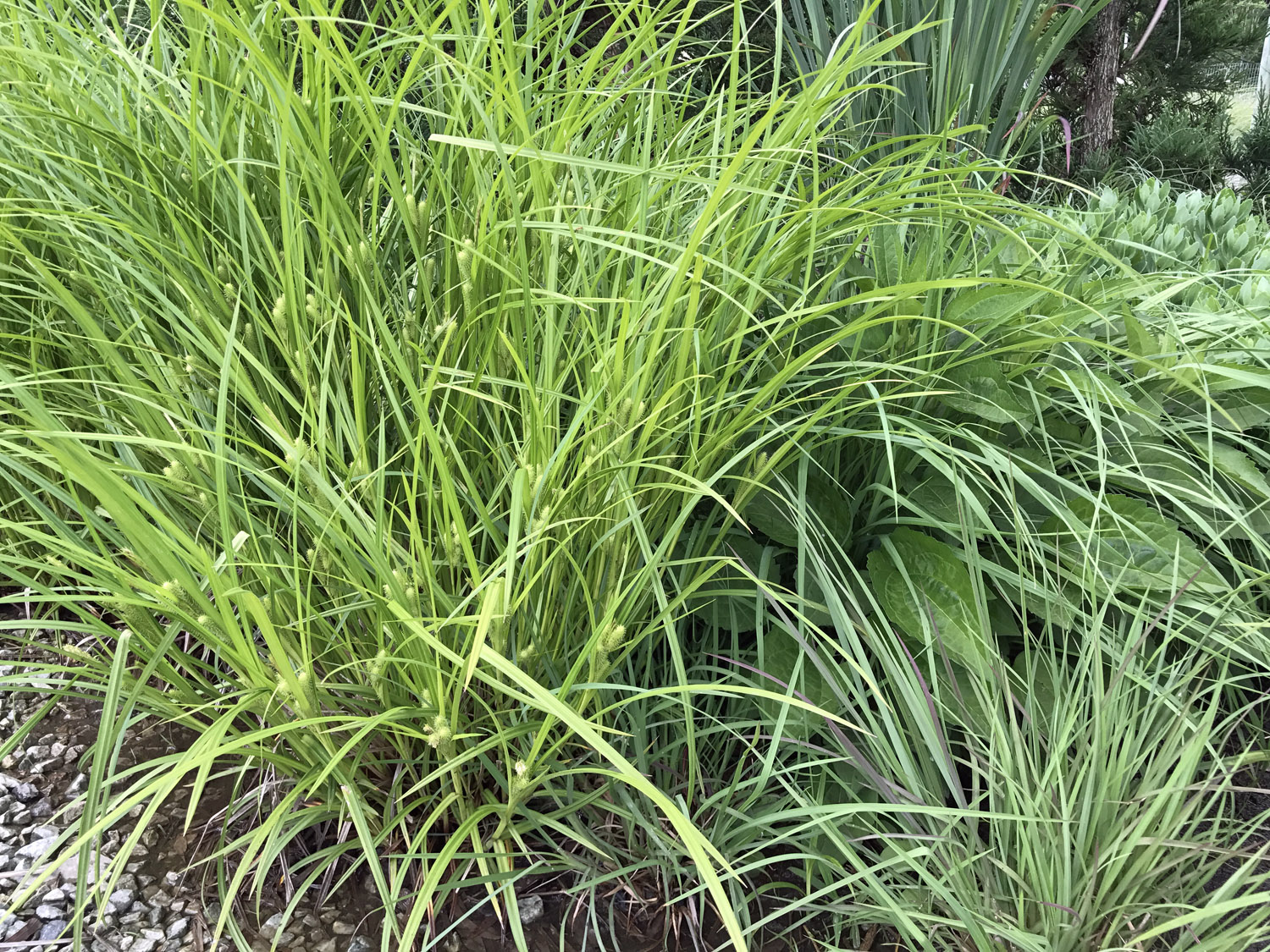
Frank’s Sedge loves the moist or wet conditions found in its natural habitats—at the edges of water bodies, bottomlands forests, floodplains, and wet prairies. It also makes itself at home in roadside ditches. The strappy, green foliage forms a large arching mound, and spiky seed heads give the other common name of Bristly Cattail Sedge. Those seed heads are intricate and interesting, but the workhorse qualities of this sedge are what stand out.
Quick facts: 1-2’ height, sun-part shade, moist-wet, flowers late spring, Zones 5-8

The showy, palm-like foliage of this sedge is unmistakable. Delicate and wispy, it’s a textural delight in the landscape. It will spread slowly by rhizomes and seed to form an attractive mass. It’s found in lowland woods, floodplain forests, and shaded wet sites, mainly in the central U.S. and upper Midwest. It prefers shade to part shade but can grow in sun with consistent moisture. The specific epithet refers to the Muskingum River in Southeast Ohio.
Quick facts: 2-3’ height, shade-part shade (sun w/moist soil), average-wet, flowers late spring, Zones 4-8
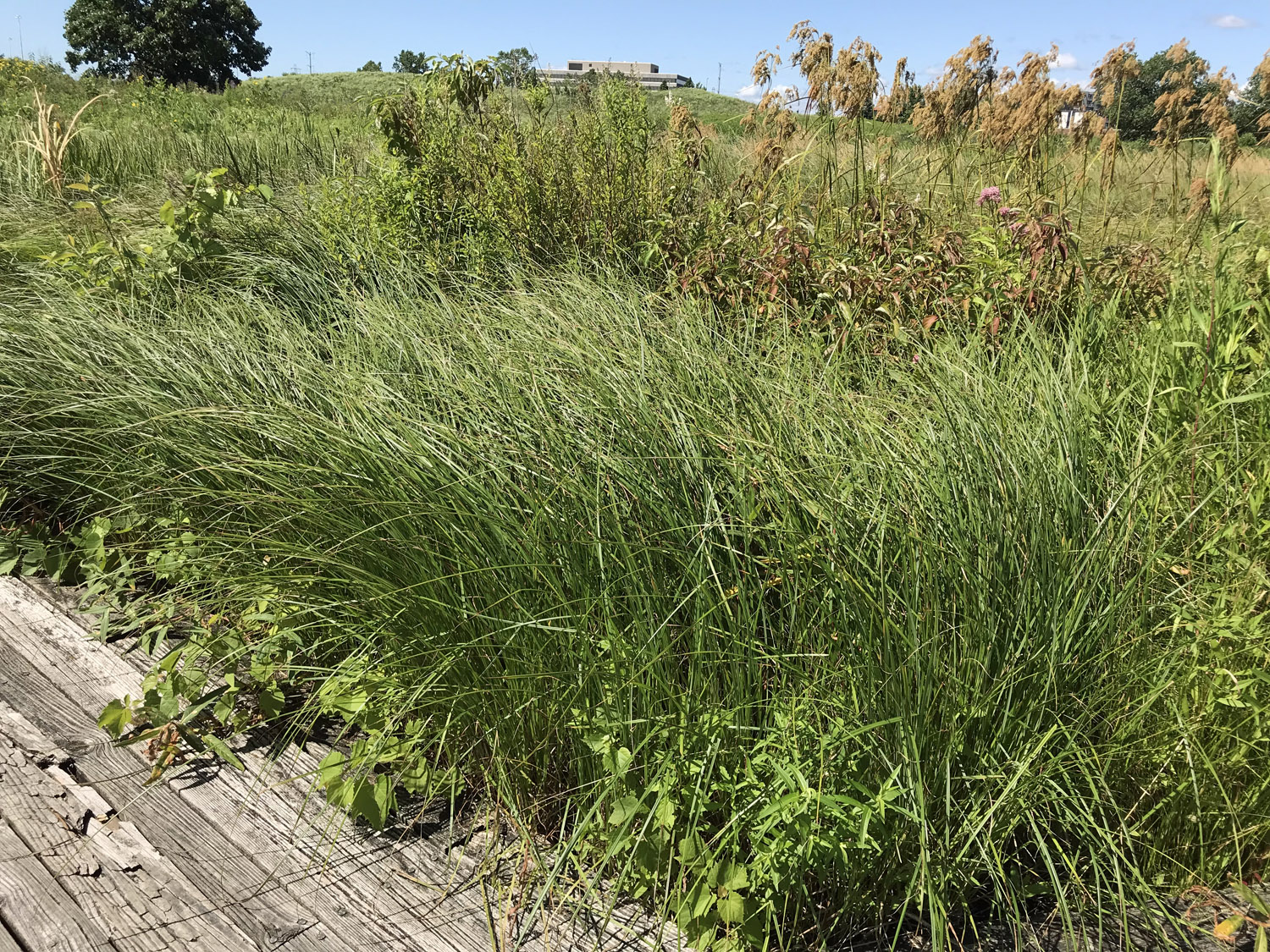
Tussock Sedge may be the most common wetland sedge in Eastern North America. It grows in marshes, bogs, wet meadows, and along shores. The common name refers to its tendency to form large tussocks, especially on sites with seasonal flooding. In drier sites, it tends to have a more rhizomatous form. Tussock Sedge is the backbone for many wetland sites, providing food and shelter for waterfowl and songbirds.
Quick facts: 3’ height, sun-part shade, wet-average, flowers late spring, Zones 4-8.
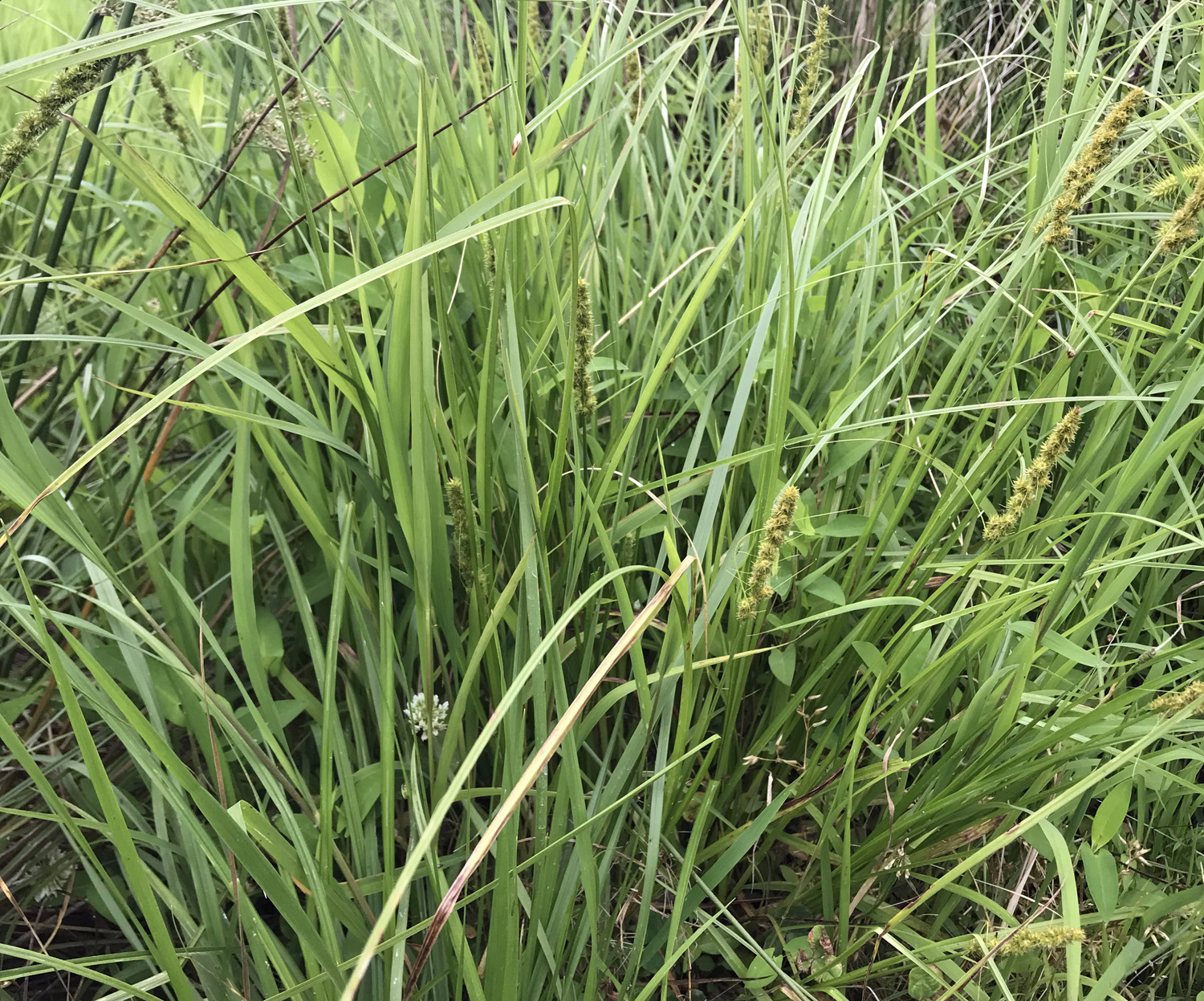
This competitive, widespread sedge is found throughout North America but is most common in the eastern half. Fox Sedge occurs in seasonally wet or flooded soils in open habitats, wet meadows, marshes, and roadside ditches. It grows in bunches and spreads via rhizomes. With ideal conditions, it can spread rapidly and colonize. That makes it super at holding in soil, slowing runoff, and reducing weed competition. Just make sure it’s placed on a site where spreading is desirable.
Quick facts: 1-3’ height, sun-part shade, average-wet, flowers late spring, Zones 3-8

These GrassSolutions™ give you smart choices for managing and improving the green spaces that are vital to all of us. In addition to the plants above, we grow many others that thrive in wet areas. Some even do well in standing water. Plants in the genus Juncus, commonly known as Rushes, give appealing visual texture and love having wet feet. For more ideas, check out our full list of GrassSolutions for Wet Areas.
To see comparisons among all the Carex we grow, refer to our Carex Comparison Chart.
Greetings from Hoffman Nursery.
Our core purpose is to promote better living through plants. It lights our way and gives us hope for the future. Amid the unsettling and rapidly changing effects of COVID-19, we are encouraged by the strength and positivity of our team, our customers, and our industry.
As we have every spring for more than 30 years, we continue to produce, grow, and ship great grasses. We’re following CDC recommendations and making sure our team understands how important these precautions are. We have modified nursery procedures and choreographed work schedules to protect the health of our team and others with whom we come in contact. These adjustments allow our team to work as safely as possible and give us flexibility to respond to changes in the situation.
We are open for normal business hours (Monday-Friday, 8am to 4:30pm, EDT). Starting March 23, our sales team will be working in non-overlapping shifts to provide coverage during those hours. They’ll coordinate with each other daily to give you the knowledgeable, helpful service you expect. Spring crops are coming on strong, and we will continue meeting your needs and helping sustain our industry.
Plants and green spaces remain an essential element in our daily lives, promoting well-being and giving us joy and comfort in the face of uncertainty. We are grateful to be in an industry that supports and provides those essentials. We are also grateful for you, our customers and colleagues. Let us know what you need, ask if you have questions, and above all, do what you can to keep yourself safe.
We’ll navigate this together.
Jill and John Hoffman
Owners, Hoffman Nursery, Inc.

Last weekend, students from seven high schools, four community colleges, and one university joined a group of horticulture industry professionals for a new event. The inaugural North Carolina High School Landscape Competition (NCHSLC) was modeled on the annual National Collegiate Landscape Competition (NCLC) held each March. In addition to being a student landscaping competition, this North Carolina-based event included a series of workshops, industry discussions, and student networking events.
The event kicked off on a Friday night with a BBQ dinner, followed by a panel discussion featuring industry professionals. Representatives from seven different companies—from landscape contractors to horticultural equipment manufacturers—wowed the audience. Each panelist told the students how this industry welcomed them and why it’s a wonderful place to start a career. They also explained how they got started in their business and about the wide range of jobs available in horticulture.

Hoffman Nursery, together with Plantworks Nursery and N.C. State’s Dept. of Horticultural Science, coordinated the Plant Identification competition. It’s one of the many events that took place throughout the day. There were three rounds of students—the first were college students preparing and practicing for the NCLC held at Michigan State later this month. The second and third groups were high school students from local horticulture programs. For them, the emphasis throughout the day was on education. Their identification event turned into a workshop, led by Kata Wallace from Hoffman Nursery and Dana Massey from Plantworks Nursery. Dana and Kata shared tips to help students understand the plants and what features to use in identifying them.
The NCHSLC was a rewarding experience for everyone, and we had a great time meeting and chatting with the students. All of the panels, workshops, and competitions helped prepare the college students for Michigan. The high school students were engaged by the activities and were eager to learn more about the horticulture industry. Meeting a range of industry professionals and spending time with students from the college horticultural programs was a big boost.
The NCHSLC connects us with the next generation of horticulture professionals and gives us a new way to support them. We are proud to have taken part in this inaugural event. A big thank-you to everyone who participated!
We hope you’ll take a minute to check out more photos from the event below.







This is the final post from a talk our head grower Bill Hall gave on Panicum virgatum at Cultivate’19. Most of our nursery and greenhouse customers grow Panicum virgatum, so we are sharing details from his talk. The first post focused on understanding the range and warm-season nature of Switchgrass. The second post connected those fundamentals to container production, addressing common concerns like yellowing and rust.
This post covers finishing time and scheduling Panicum production. You know from earlier posts that warm-season grasses like Panicum grow best when soil and air temperatures are high. Switchgrass is slow to emerge in spring, and that has implications for planning your production.

Panicum virgatum is a warm-season grass that grows strongly through the heat and long, sunny days of summer. It is photoperiodic, with flowering connected to the change in day length that comes with the summer solstice. It flowers in mid- to late summer (July and August for us) and will show fall color as temperatures drop and day length shortens. Switchgrass is dormant through the colder winter months and begins growing again in late spring when soil and air temperatures are rising.
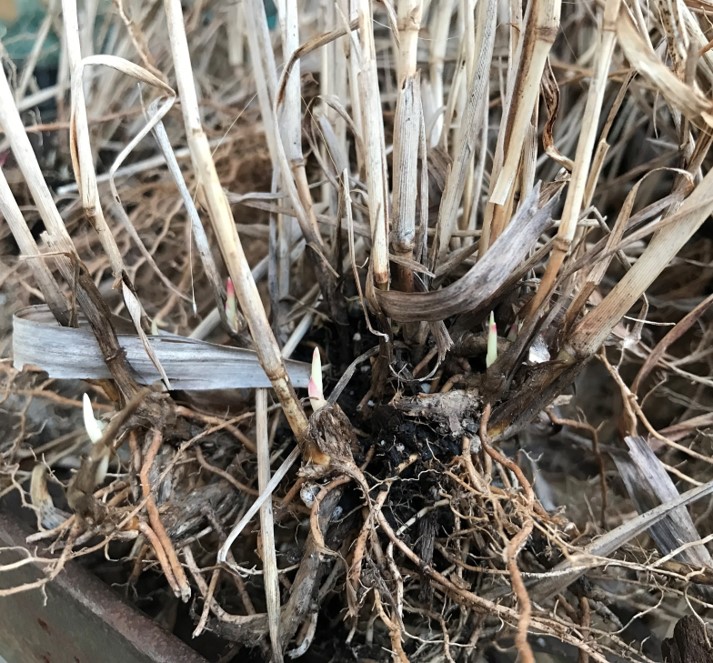
In our cold frames, Switchgrasses typically break dormancy around mid-March. They are one of the last groups to emerge, and bud break often varies by cultivar. Moreover, we see variations within crops, particularly with plants on the edges or in colder parts of the enclosure.
Production conditions vary across regions, so we’ve synthesized some rules of thumb based on our experience, feedback from customers, and articles by perennial consultant Paul Pilon. Assuming 65° to 70°F throughout crop production, a 32-cell liner should finish in a gallon in 7 to 9 weeks. A 72-cell liner to gallon should take 10 to 12 weeks.
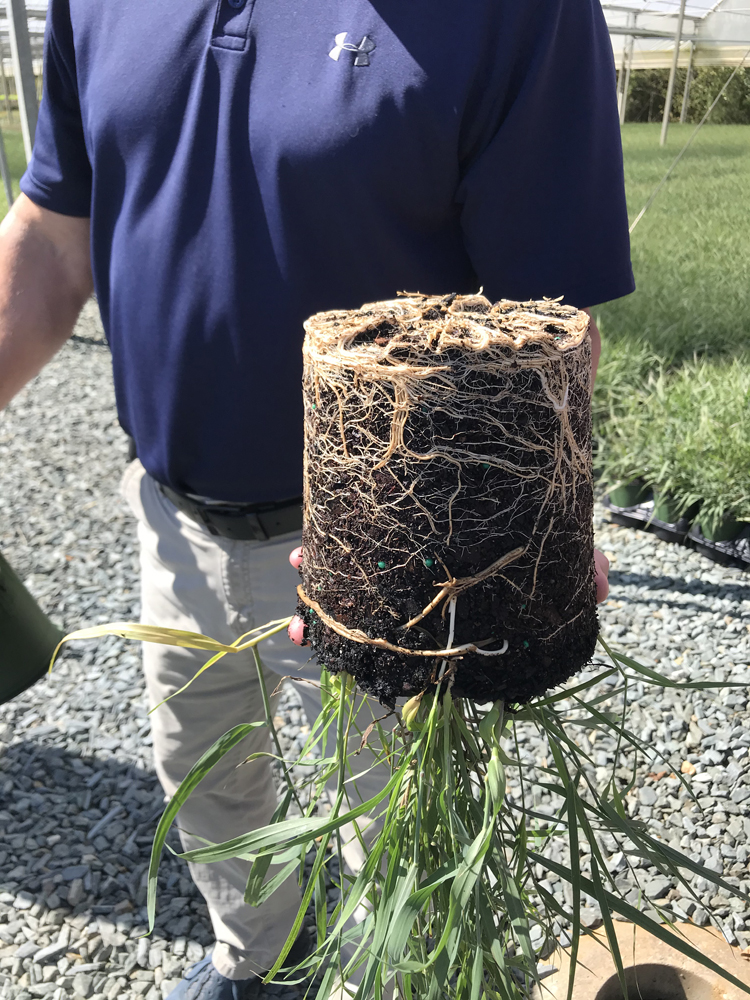
If you’re aiming for 1-gallon sales in late summer or fall, you can pot up in spring or early summer of the same year. Panicum virgatum’s late emergence becomes a plus because you can schedule them for after you’re done with other perennials. They’ll grow quickly once soil and temperatures rise.
When target sales are for spring or for 2 gallons or larger, the best strategy is to pot during summer or early fall of the preceding year and overwinter them. Make sure you pot them up in time to establish roots before they enter dormancy. That head start on root growth will give you a stronger, faster-finishing plant than if you’d potted it in the current season. This timing works for 1-gallon containers and for larger sizes.
Ideally, you’ve got liners ready to go when you need them and on your schedule. To do that with Switchgrass, it’s important to understand timing.
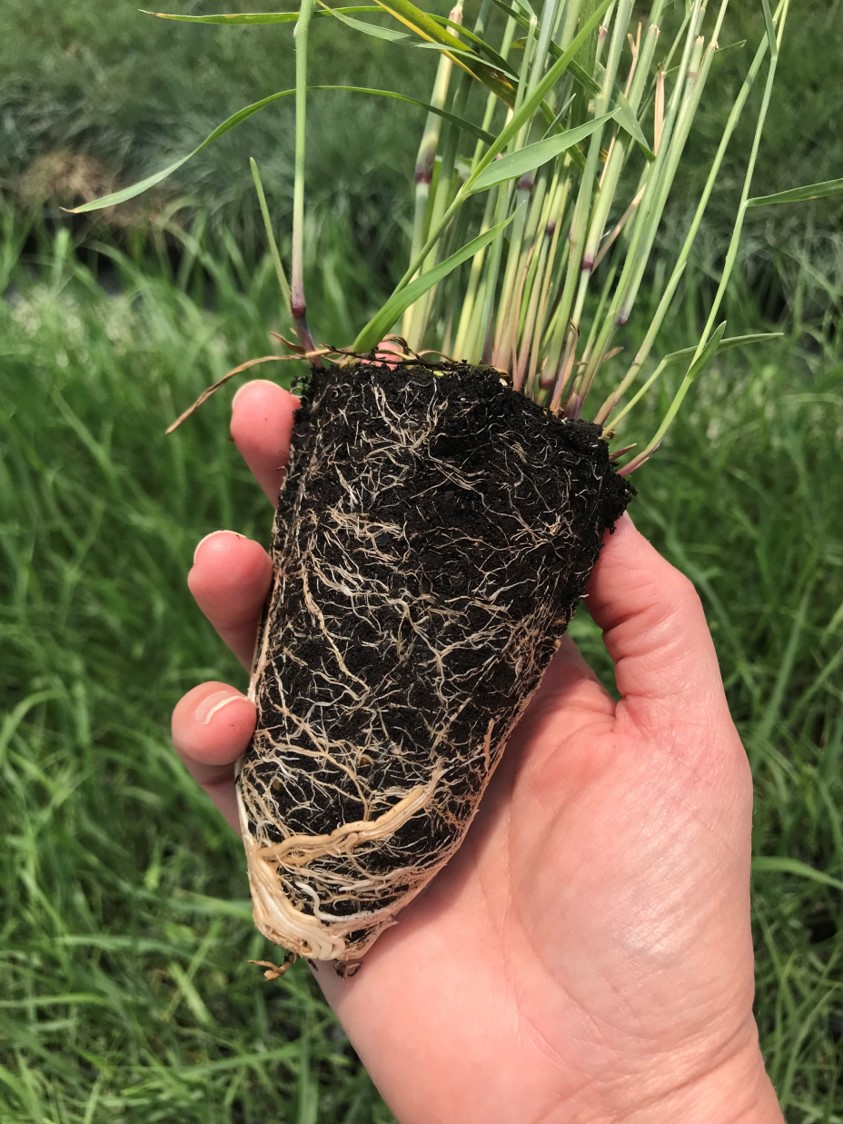
We work with Panicum’s natural growth cycle and only do production rounds certain times of year. For example, we make early spring crops of Switchgrass in late summer of the preceding year. If you’re bringing in liners for spring production, and you’ve reserved that spring crop, you’re all set. But if that spring crop sells out, you’ll have to wait until early summer when the next crop is ready. That can throw off your schedule and add to your costs. The smart move is to reserve them ahead of time.
Here are some guidelines to make sure you’ve got liners when you need them:
Target potting window│reserve liners by
January through May│reserve by end of previous July
June through October│reserve by March of same year
November through December│reserve by July of same year
Another point to keep in mind—if you need a larger quantity or a different cultivar than usual, talk with us even earlier. Like you, we’re planning several years out. Including your needs in our production schedule gives you a leg up and helps keep your production on track.
Getting your production timing down and working with their natural growth cycle can help you take of advantage of all that Switchgrasses offer. They can seem tricky, but we hope you’ve found information in this series that will help you avoid many of the common concerns. Remember that they’re very efficient with water, nutrients, and sunlight when temperatures are high. These warm-season grasses have great growth potential and knowing how to manage that is key. Hoffman Nursery is here to help you grow good grass, so give us a call or email if you have questions.
If you missed our earlier posts on understanding Switchgrass and cultural conditions, be sure to check them out. If you’re ready to get growing, browse our list of Panicum.
***
Click here to see a list of references consulted for these posts and Bill’s presentation.
Ornamental grasses are a great choice to invigorate your fall landscape and add seasonal appeal into the winter months. Their colors, textures, and movement add to the landscape in ways few other plants can. And they’re not just a pretty face—they improve the soil, anchor green infrastructure projects, and provide forage and shelter for wildlife.
Here are four of our fall favorites that provide winter interest while they are hard at work.
Panicum virgatum ‘Shenandoah’ (Red Switch Grass)

Pennisetum alopecuroides ‘Cassian’ (Dwarf Fountain Grass)

Schizachyrium scoparium ‘Prairie Blues’ (Prairie Blues Little Bluestem)

Sorghastrum nutans (Yellow Prairie Grass)

These are just a few choices for giving your garden great seasonality. For more selections, browse our list of grasses with notable fall color.

Our head grower, Bill Hall, gave a well-received talk this summer on Panicum at Cultivate’19. Because so many of our customers grow Panicum virgatum in container production, we are sharing details from his talk in a series of posts. The first post focused on understanding the range and warm-season nature of Switchgrass. You can review it here.
The current post connects the fundamentals to container production. The most common production concerns we hear with Panicum are yellowing, rust, and slow emergence in spring. Yellowing and rust are often related to cultural conditions and management practices, which we’ll address here. Production timing will get the spotlight in a later post.

Keeping Panicum problem free starts at the beginning. When transplanting liners or plugs, match the original soil line of the propagule with the media in the container. Grasses are sensitive to having the crown buried, which limits air circulation and can invite disease. Planting too high can leave the root ball vulnerable to drying out.
You’ll also want to make sure there is good root contact with the media and there are no air pockets. Once potted, the root zone should be kept moist, but not wet, until the plants are established.
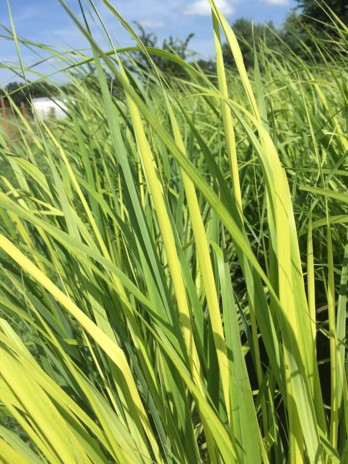
Switchgrass grows best in full sun conditions and has average water needs for an ornamental grass. It needs less than Pennisetum but more than Schizachyrium. If you’re growing outside, use a light porous media to facilitate good drainage. Panicum virgatum can take up a lot of water, but that can have a significant downside in production. Frequent, heavy rain events or overwatering can lead to yellowing—one of the major issues we hear about from customers. Keep an eye on your irrigation regimen in the greenhouse and back off if you start to see yellowing.
Use a well-drained soil mix to help with water management. Our current media is 60% pine bark, 30% peat, and 10% perlite. To this basic mix, we add 5 lbs. of dolomitic lime and 1 lb. of Micromax per cubic yard. We also include a 5- to 6-month slow-release fertilizer (SLR). The rate depends on whether we’re potting up for fall/winter production (4 lbs./cu. yd.) or summer production (6 lbs./cu. yd.).
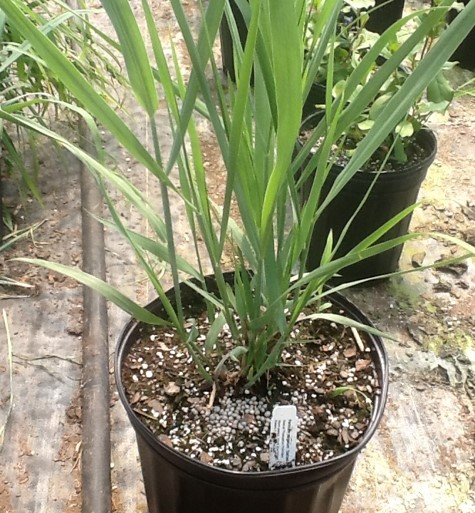
Switchgrasses aren’t heavy feeders, so incorporating SLR in the potting media usually covers a single round of production. However, if we wind up overwintering plants, they get a 1 lb.-rate of SLR just before they break dormancy. Overwatering isn’t the only cause of yellowing in Switchgrass. Nutritional imbalances can send Panicum in the chlorotic direction. Check your EC and pH levels to make sure they’re not way off. If we see yellowing on a crop, a single application of liquid feed 10-10-20 with iron usually turns it around.
Compared to other perennials, insect pests are minimal on Panicum. We see spider mites in summer, along with occasional Japanese beetles, thrips, and spittle bugs. The heaviest disease pressure comes from rust (Puccinia and Uromyces). Rust problems tend to be very site-specific, depending on the region and weather conditions. It’s seasonal for us in central North Carolina, usually appearing in September and November.
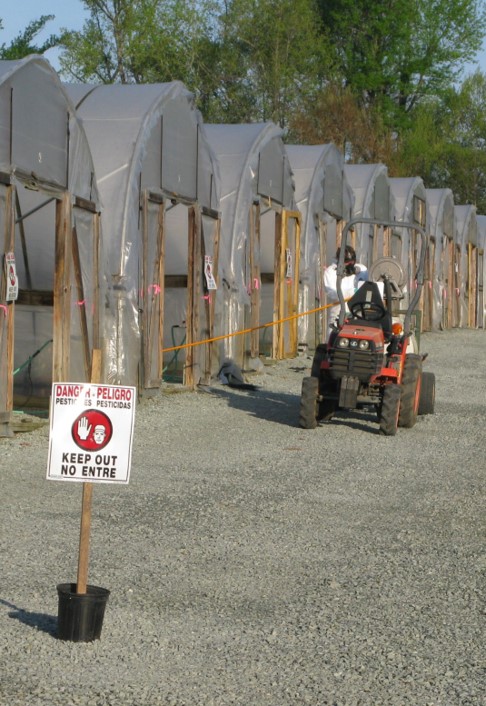
Our strategy is to spray prophylactically every two weeks starting in mid-August. We use a broad-spectrum fungicide and continue through October or until the plants start going dormant. We rotate chemicals to prevent resistance.
We also see Leaf Spot (Bipolaris oryzae) on Switchgrass. It affects the foliage appearance but does not compromise plant health unless left untreated. In addition, we’ve found the following diseases on occasion, but they are not common: Alternaria, Collectotrichum (anthracnose), brown and root rots, Phyllosticta, and Septoria.
An integrated pest management (IPM) program will keep your Panicum in good shape. Monitor irrigation and limit the time the foliage is wet. Scout regularly and be ready to treat. IPM includes a tolerance for some damage, although we try to keep that to a minimum. Occasionally plants will have residual damage even though there are no active pests present. Work with your vendors and customers to manage expectations and ensure pests aren’t coming in or going out with your Panicum.

We hope these tips lead to successful growing with fewer yellowing and rust problems on your Panicum. Now that you’ve gotten an overview and best management strategies, the next post will address production timing. We’ll give you tips for scheduling so you can take advantage of the Panicum growth cycle. Check back soon!
Ready to see more Switchgrass? Find the ones we offer here.
***
Click here to see a list of references consulted for these posts and Bill’s presentation.
In a previous post, we highlighted a talk on Panicum by our head grower, Bill Hall. He delivered a great session at Cultivate’19 on producing and growing problem-free Panicum. Because so many of our customers grow Panicum virgatum in container production, we wanted to share more details from Bill’s talk.

The most common production concerns we hear about with Panicum are yellowing, rust, and slow emergence in spring. Yellowing and rust are often related to cultural conditions and management practices, which we’ll address. In addition, as warm-season grasses, Switchgrasses are some of the last to emerge in spring. We’ll cover production scheduling and finish timing to help you take advantage of the Panicum growth cycle.
Look for useful info and straight talk on switchgrass in this and upcoming posts.
Bill Hall’s talk focused on Panicum virgatum, the most widely grown species in the genus. Commonly called Switchgrass, it’s a long-lived perennial native to North America. It is deeply rooted, somewhat rhizomatous, and sensitive to photoperiod.
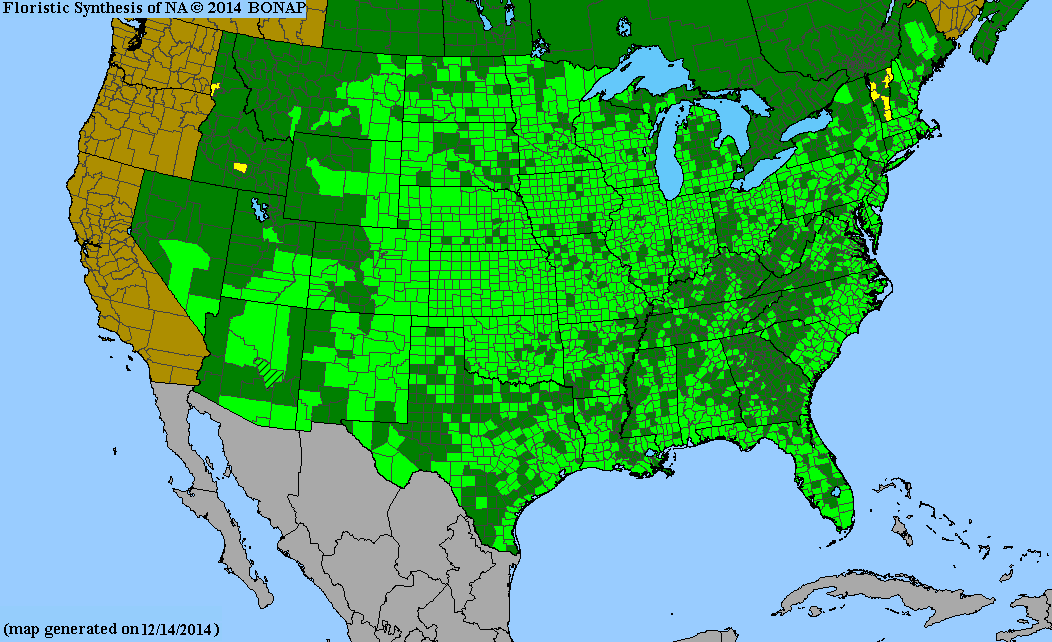
Panicum virgatum has a wide native range, from southern Canada down the U.S. to Mexico, Cuba, Bermuda, and Costa Rica. It was a major component of the tallgrass prairie that used to be prevalent in the central U.S. It’s also found on dry slopes, sand, open oak or pine woodlands, the shores of lakes and riverbanks, and in brackish marshes.
It can grow and thrive in many climates, soil types, and land conditions. The growing season in northern habitats can be as short as three months; in southern reaches, up to eight months. In addition to supplying forage for livestock, Switchgrass provides food, cover, and nesting material for wildlife.
With such a large geographic and cultural range, its form and characteristics vary widely. Botanists have identified two broad ecotypes—upland and lowland—which reflect some of those differences. Upland types tend to be from more northern latitudes and exhibit greater cold tolerance. They tend grow in drier soil conditions and tolerant drought better, while being smaller and shorter than lowland types.
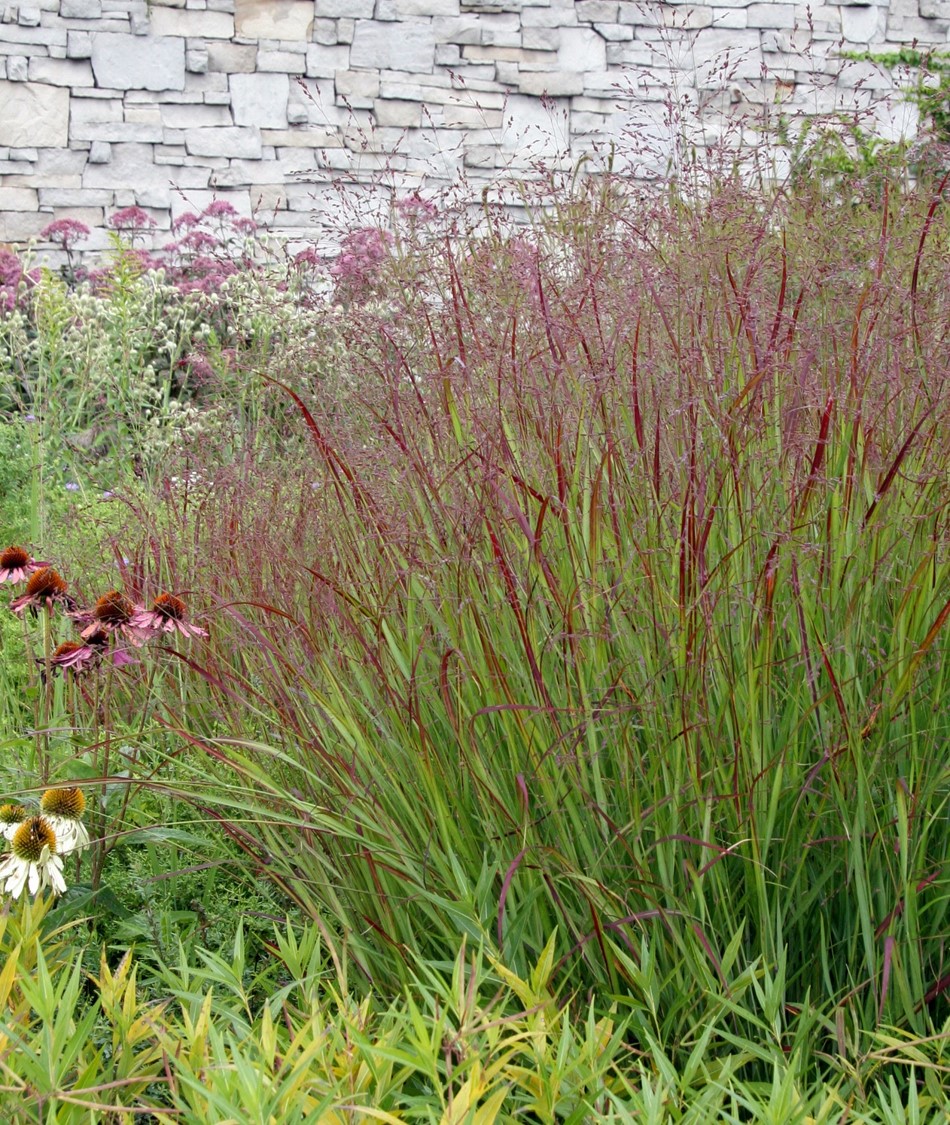
The lowland types tend to be from more southern latitudes and found in moister conditions. They grow well with plentiful water and grow larger than lowland types. They often have blue-green waxy leaves, a later flowering time, and seem more resistant to rust diseases. Many of the observed physical differences in the two types have to do with differences in water use and photosynthetic rate.
While the two ecotypes show different characteristics, there are also large variations within the two types that can overshadow the broader ecotype differences. That makes sorting out cultivated selections challenging. Forage-type cultivars are developed based on regional ecotypes, but horticultural selections can have a mix of ecotype characters. It’s not clear where common cultivars in the trade fit within those ecotypes. This is an area that needs more exploration and study.
Panicum virgatum is a warm season grass, and that’s fundamental to understanding and growing it. Most land-based plants species (85%) fix carbon using a C3 photosynthetic process. We commonly call them cool season growers. Under environmental pressures, structural and chemical adaptations in grasses and other plants over millennia gave rise to a C4 photosynthetic process. We refer to these as warm season growers.

Warm season grasses have greater growth potential and greater efficiency in use of water, sunlight, and nitrogen. They grow best when soil temperatures are between 70°–90°F and ambient temperatures in the 80°–95°F range. Compared to cool-season grasses, warm-season grasses can produce the same amount of biomass using one-third to one-half of the water. On one-half the nitrogen, they can photosynthesize just as well. They can also reduce water loss under dry conditions by closing their stomata during the day. That makes them less susceptible to drought stress.

Their C4 photosynthetic pathway and uber-efficiency play a big role in understanding the growth of Panicum virgatum. It breaks dormancy later than cool season grasses, and the greatest growth occurs in midsummer. That’s when it can take full advantage of heat and sunlight. That pattern is even more obvious in colder regions, where Switchgrass breaks dormancy late in spring and summer heat is slow to arrive. Moreover, copious amounts of nitrogen and water can lead to lush growth and flopping. These are plants that grow quite well under lean conditions.
This first post gives an overview of Panicum virgatum, which sets the stage for growing it successfully. Next, we’ll connect these fundamentals with container production and the common concerns we hear in growing them. Stay tuned!
Ready to see more Switchgrass? Find the ones we offer here.
***
Click here to see a list of references consulted for these posts and Bill’s presentation.

Panicum virgatum and its cultivars are long-time favorites here at Hoffman Nursery. Some have rich, red and burgundy tones, while others offer blue or purple foliage colors. In addition to being beautiful, Switchgrasses are tough and adaptable. They handle dry conditions, tolerate poor soil, and are stalwarts for green infrastructure projects like bioretention and erosion control. They also provide food and cover for wildlife.
Panicum virgatum got the spotlight this summer at Cultivate’19. Our Head Grower, Bill Hall, shared a session with Laura Robles of Walters Gardens to talk about Baptisia and Panicum from a grower’s perspective. Afterward, Greenhouse Management produced an excellent summary of his and Robles’ session entitled, “What growers need to know about Baptisia and Panicum”. We have included the Panicum section below and invite you to check out the full article on the Greenhouse Management website.
Keep an eye out for more info on Switchgrass. We plan on covering Bill’s talk in more depth in upcoming posts!
Interested in seeing more Switchgrass? See our full list here.

Every year we look forward to it, and we hope you do, too. Our updated catalog for 2019-2020 is ready for its debut and should be hitting mailboxes in the next few weeks!
The cover image features nursery favorite, Muhlenbergia capillaris ‘White Cloud’. With showy, ornamental qualities and steadfast performance, it fits a range of applications. This year’s catalog theme focuses on what grasses can do for our customers. You’ll find success stories highlighting the benefits of growing good grass!

What else is new?
Updated lists and comparison charts for:
If you haven’t received the catalog by mid-July, send us an email or contact our sales team at 800-203-8590. You can also pick one up at the Hoffman Nursery booth at upcoming trade shows.
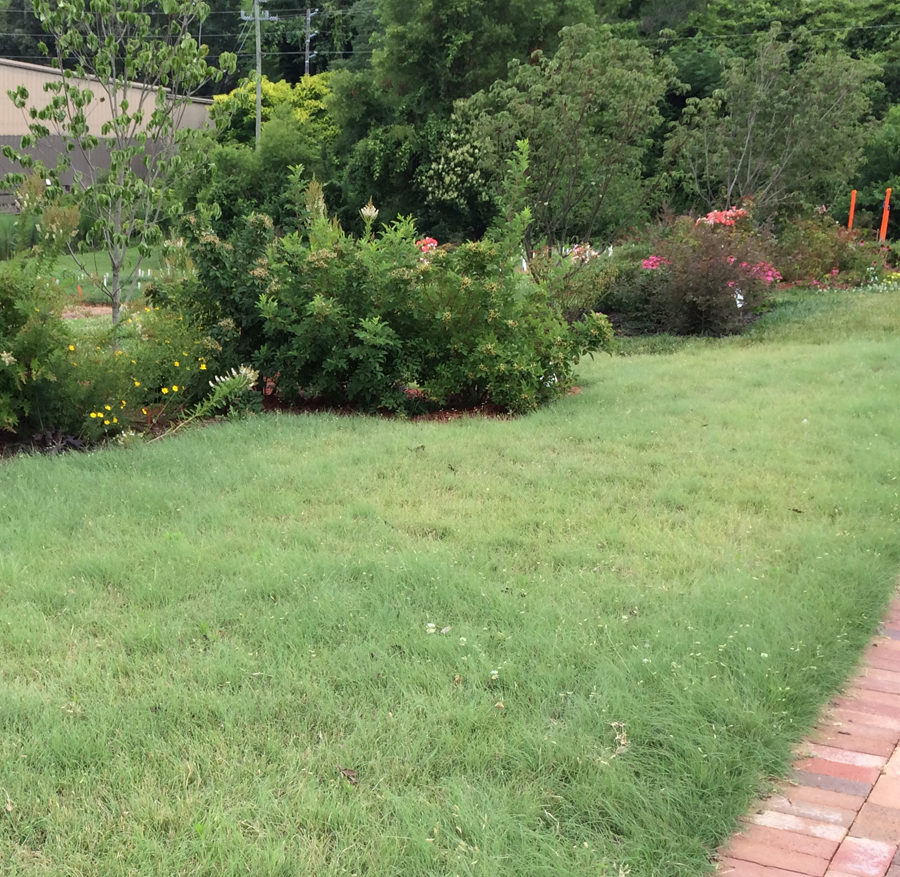
Would you like a lawn that doesn’t require fertilizer, pesticides, or frequent mowing? Our newest grass selection offers a low-resource alternative to traditional turf grass. Bouteloua dactyloides, commonly called Buffalo Grass, spreads quickly by rhizomes to form a dense carpet. Fine-textured, gray-green to blue-green foliage grows 10-12 inches long but curls and drapes over for a shorter appearance.
Bouteloua dactyloides is a warm-season grass that’s native to Manitoba and Saskatchewan, south through the Central Plains states of the U.S. and down into Mexico. It’s a dominant grass in shortgrass prairie and often forms the understory in taller prairies.
While not widely used in the Southeast, it has performed well for us in central NC. We’ve had a small patch of it in one of our gardens since 2010. In spring of 2018, we installed another planting on the front side of a fenced field. The images below show it at the end of that summer and into winter of 2019. While it forms a dense sod that is competitive, it still requires some weed management by hand pulling.
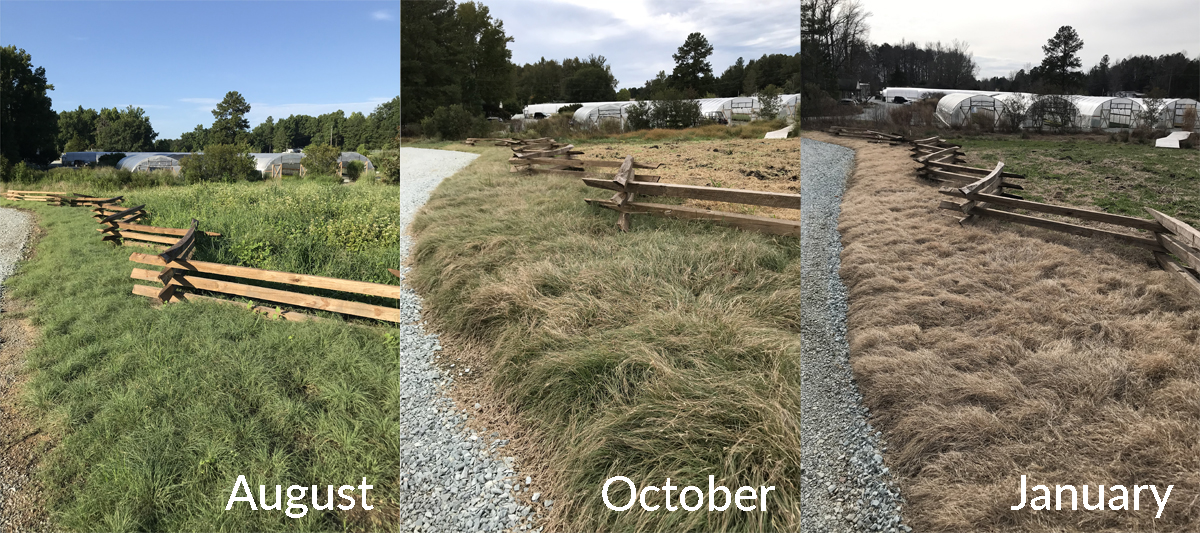
Cultural Needs
Buffalo Grass can be mowed several times per year or left in place for a natural look. If mowing, a minimum height of 2”-3” will help the grass compete with weeds. It may need periodic edging to keep it out of soft pathways or adjacent planting beds. Like warm-season turf grasses, it will turn dormant and brown mid-fall through mid-spring.
Buffalo Grass needs full sun but has low fertility and water requirements. It tolerates heat, drought, and alkaline soils. It is intolerant of heavy moisture and sandy soils. It only needs 1.5” of rain per month to stay green. During periods of prolonged drought, it may go dormant and turn brown. That strategy can help it survive under super-tough conditions. With lower needs for fertilizer, irrigation, and mowing, Buffalo Grass uses fewer resources than traditional, highly managed lawns.
According to the USDA’s plant fact sheet, Buffalo Grass plugs should be planted on 12 to 24-inch centers, depending on how quickly you want to get coverage. The plugs can spread within 8 to 12 weeks after planting.
Buffalo Background
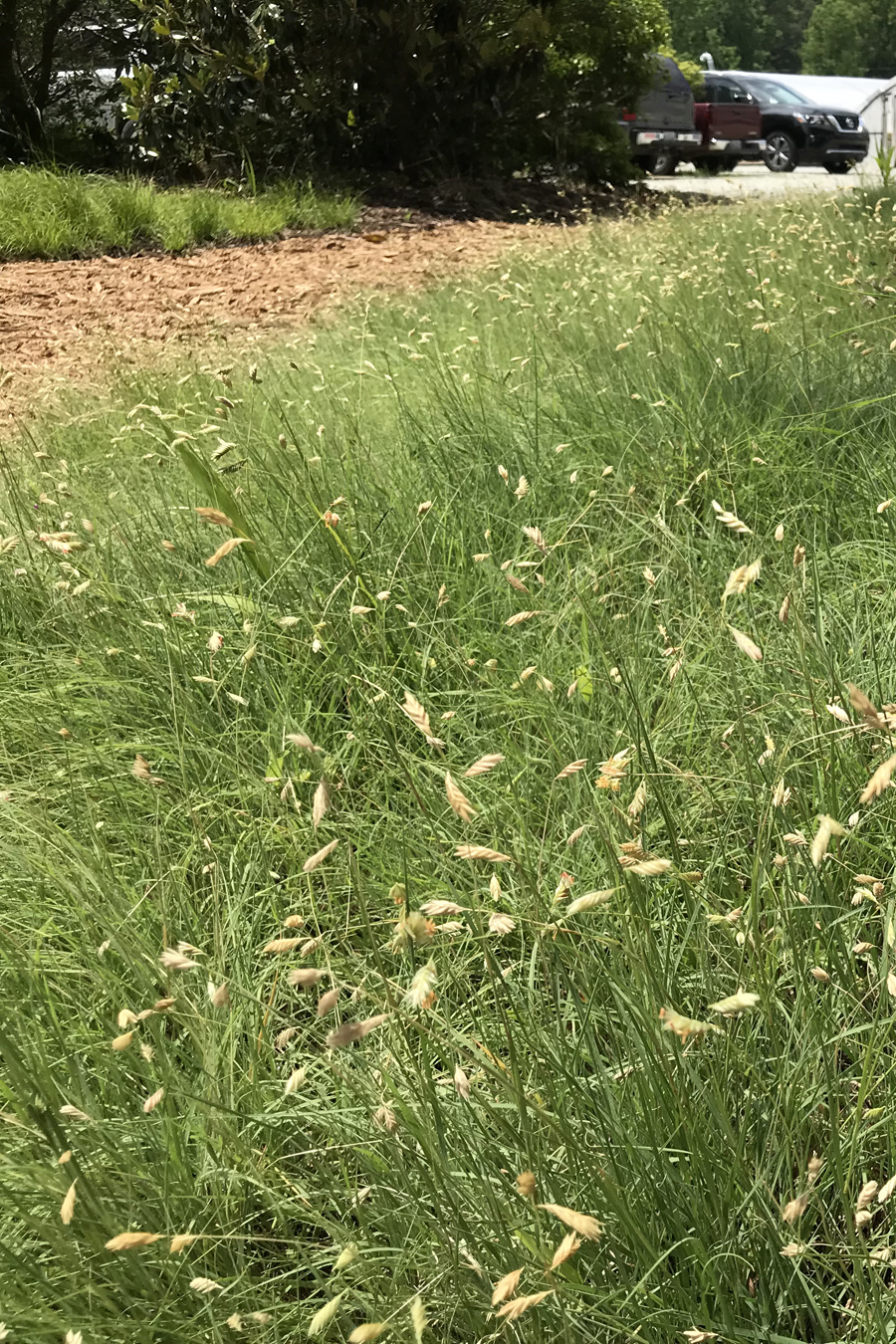
The common name reflects this grass’s role as forage for buffalo (American bison) that once roamed the Great Plains. As a component of the shortgrass prairie, early settlers in the region used it to construct their sod houses. Then and now, it’s a larval host for green skipper butterflies. The specific epithet, dactyloides, means fingerlike, which refers to the inflorescences.
Buffalo Grass is dioecious, with male and female flowers on separate plants. The male flowers are on small, comb-like spikes that hover above the foliage. Female flowers cluster on short stems down in the leaves. We think the male flowers are part of its appeal, but they can be mowed for a look that’s more formal and closer to turf grass.
Ready to Try?
We’re growing Buffalo Grass in a 32-liner plug tray. It outgrows a liner quickly, so we produce this one on request. The average lead time is 10 weeks, but that may vary with the time of year and our production schedule. See our plant profile and contact our sales team for more information.
More Resources
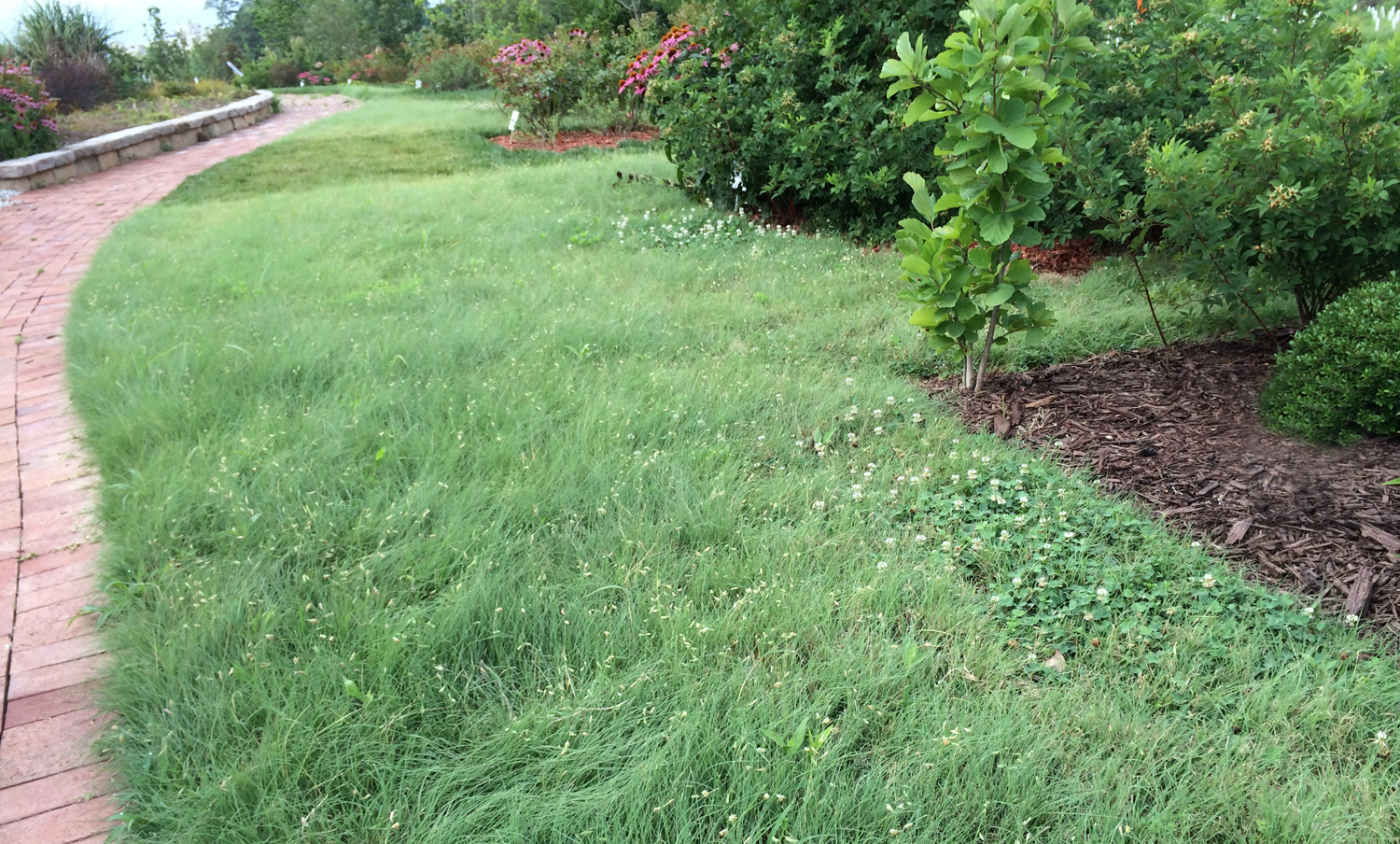
Hakone Grasses conjure flowing water and add a graceful beauty to any garden. We grow three different varieties, offering color variations that brighten and enhance landscapes. They’re especially useful in shade to part-shade conditions. Learn more about each of these varieties and find out why you’ll want to reserve them early.

The species offers a tranquil green often needed in landscape design. In addition, It tolerates more sun and drier soil, and it is hardier and faster growing than most of its cultivars. It grows in a mounding, cascading shape, and spreads very slowly by rhizomes. Leaves intermingle when it is planted close together as a ground cover; in decorative containers, foliage spills over the edges.
See the plant profile

Winner of the Perennial Plant Association’s Perennial Plant of the Year® in 2009, this classic is beautiful and elegant. Golden leaves with intermittent green stripes flow downward like a bright waterfall. It can handle sun in cool, moist climates, but needs shade in hot, dry environments. It grows in an 18-inch clump that spreads slowly by rhizomes to make a superb ground cover.
See the plant profile

Gold Hakone Grass cures lackluster landscapes with its gilded-yellow foliage. This burst of color creates excitement and contrasts beautifully with shade plants. Its elegant, mounding habit makes it a classic. Combine Hakonechloa macra ‘All Gold’ with deep greens and blues in the landscape. Take advantage of its shape and golden hue to dress up decorative containers.
See the plant profile
Hakone Grasses struggle in the heat and humidity of the Southeast. They’re native to moist mountain areas in Japan, so they do best in areas with cooler summer temperatures. Because our summers are tough on them, we wrap up spring production early. The last rounds are typically ready in May and early June. We ship them as soon as they’re ready, and we usually sell out.
Your best chance at the spring availability window is to reserve your plants ahead of time. If Hakone Grasses aren’t already on your spring orders, we suggest you reserve them immediately. Email (sales@hoffmannursery.com) or call our sales team at 919-479-6620.




They call him, “The Prairie Preacher,” and he’ll definitely make you believe. Dr. Dwayne Estes, Executive Director of the Southeastern Grasslands Initiative (SGI), spoke to a full house this April at the North Carolina Botanical Garden. He was introduced by Dr. Alan Weakley, a fellow board member of SGI and Herbarium Curator at UNC-Chapel Hill. Dr. Estes gave an engaging talk that shed new light on the history and importance of Southeastern grasslands. They’re biodiversity hot spots and and centers for endemism (species found nowhere else) in North America.
Yet, most of us aren’t aware that grasslands covered a large portion of the Southeast. The myth of the squirrel that could go from the Atlantic Ocean to the Mississippi River without touching the ground persists. Historical accounts belie that, reporting huge swaths of land covered with our native grasses and forbs. These open areas, easily converted to large-scale agriculture, disappeared quickly with colonization. They were gone before the invention of the camera, which might have better documented their existence.

It was fascinating to hear the legacy of our grasslands and exciting to contemplate bringing them back. That’s a HUGE task, and we can all play a part. Find out more about SGI, which is partnering with institutions and companies like Google to conserve this ecological legacy.
To see what you can do and learn more about SGI’s new approach to conservation, go to the SGI website
The group’s Facebook page is also a treasure trove of information. With frequent posts from the field and a big dose of fun, it’s a great way to learn about the different types of grasslands, see beautiful native landscapes, and hear what’s happening with the organization.
There’s a current project we’re really excited to follow. Dr. Estes is converting a small space in his suburban back yard to prairie. He’s burning and planting it this spring. He and his kids will watch it and document what happens over the next year. We can’t wait! Watch the first video here.
The Rocky Mountains provided a picturesque backdrop for the 43rd Annual National Collegiate Landscape Competition (NCLC) at Colorado State University last week. NCLC is an annual three-day event that brings together landscape and horticulture students, industry leaders, and many of the top businesses in horticulture. John, Jill, and David Hoffman attended this year and had a fantastic time meeting and catching up with students and professionals alike.

Again this year, Hoffman Nursery sponsored the Annual & Perennial Plant Identification competition. The event tests students’ knowledge and speed, tasking them with identifying annual and perennial plants in a limited amount of time. During the competition, 50 live plants are placed around a room, allowing the students to examine. Participants had 55 seconds to identify and write each plant’s scientific and common name correctly. “We had a great group of over 100 enthusiastic students who were ready for the challenge,” John Hoffman said. “It’s always a fun and exciting time.” Molly Roy from American River College in Sacramento, CA placed first in this year’s competition.
Hoffman Nursery’s involvement in NCLC extends beyond the Annual & Perennial Plant Identification competition. It begins months earlier. We give a boost to local programs at Alamance Community College, University of Mt. Olive, and Sandhills Community College by hosting workdays at the nursery. Students help with landscape tasks and earn funding for travel to the NCLC. We are very proud of the students who participate in the competition. And we are happy to have a hand in fueling the future of horticulture.
Check out photos from this year’s event below. To see even more of the action from NCLC, search the hashtag #NALPNCLC on Facebook, Instagram, and Twitter.











Get your landscape projects off to the right start.
With our wide selection of grasses and sedges, landscape contractors often turn to us for plants that are hard to find in larger sizes. Getting the plant you need is crucial, but there are added benefits to using liners in the landscape. Well-rooted liners are ready to take off when planted in the ground.

It makes good horticultural sense. The soil volume in a small container is limited, yet plants continue to photosynthesize. That excess energy is stored for future use in the root system. When liner plants are freed from their container, this stockpiled vigor bursts into action. Liners typically catch up to larger, finished plants in one or two growing seasons.
To see more benefits, see our infographic below.

If you’re going with liners, it also makes sense to get them from Hoffman Nursery. The value you get from us stands out in the trade. You get a wider selection than you can find elsewhere, especially for North American native species. Furthermore, you have the support and expertise of our experienced team. We never leave you in the dark—you’ll know what’s happening and when.
Plan ahead and reserve your plants now for the best availability. You can check out what’s in stock now and see future crops here. We can even custom grow for your project, so you’ll have the perfect plant at the perfect time in the perfect size.
Give us a call at 800-203-8590 or email today. We are happy to help!
For more info on grasses in the landscape, go to our Learn section.
Ah, blue. It’s often described as peaceful, tranquil, and calm. It evokes the big blue sky and the deep blue sea. Blue-toned foliage in the landscape adds interest to the space and wakes up a garden. Here are a few options to add cool tones to your next project.
Festuca glauca ‘Elijah Blue’ is a popular selection that’s renowned for its blue foliage. It has a fun, spiky habit that grows in a tight clump, less than a foot tall. A cool season grower, Blue Sheep’s Fescue maintains its color throughout the winter months but slows down in the summer when temperatures climb. It looks its best in Northern climates, but can look good in the South with afternoon shade and well-drained soil.

Helictotrichon sempervirens ‘Sapphire’ is a standout, cool season grass with bright blue foliage. It produces graceful, neat, two-foot clumps that create a rounded, sculpted look in the landscape. Long, graceful stems emerge in late spring topped with tan, oat-like seed heads. While we have seen occasional blooms here in central North Carolina, they are most abundant in cooler climates. Blue Oat Grass prefers full sun and well-drained locations.

Striking blue-green foliage and well-behaved spreading make Carex flacca ‘Blue Zinger’ a ground cover favorite. It features narrow grass-like foliage that grows in 8-10 inch clumps, but will spread slowly to form a bluish mat. Blue Zinger adapts to varied soil conditions and is drought tolerant once established. It holds its blue coloring through the winter in milder climates. It can take full sun and partial shade and works best in well-drained soil.

All three of these selections are beautiful in masses as well as in mixed plantings. We also think they make great additions to containers.
Carex flacca ‘Blue Zinger’ and Festuca glauca ‘Elijah Blue’ are both currently available. Helictotrichon sempervirens ‘Sapphire’ will be available in a few weeks. This is great timing for our cooler-climate customers. Pot up liners into larger sizes, and they’ll be big, blue, and beautiful for spring and summer sales. Reserve your liners now to ensure you’re covered!



In an earlier post, we wrote about starting 2019 with a new event—a three-day Winter Summit. The last day of the summit, we partnered with Rise Against Hunger (RAH) to package meals. They’re an international hunger relief organization that distributes food and aid to vulnerable populations around the world. RAH partners with other organizations to provide food and change the lives of those who are underserved. They strive to promote education, improve health and nutrition, and stimulate economic growth

RAH enlists volunteers to assemble and pack meals for the food distribution program. Their staff came to the nursery to coordinate the process. Each dehydrated meal is nutritionally complete, containing rice, soy, vegetables, and essential vitamins and minerals. The nursery funded the meals and provided space, tables, and volunteers. Runners delivered supplies to the filling stations, packers assembled the ingredients, measurers ensured all meals weighed the same, and closers sealed the meals in bags. Finally, packers filled boxes with the packaged meals and loaded them on the truck.

In less than two hours, our team packaged over 10,152 meals for those in need in Haiti and Mozambique. It was amazing to see our entire organization come together for this event. People stepped up to lead when needed, had fun working side-by-side, and encouraged each other to reach our meal-assembly goal. The RAH crew reported that we finished earlier and had less waste than any other team they had worked with, so we are very proud of our folks. One of our core values is to Celebrate Success, and we certainly did that!
This was our second Rise Against Hunger event, and we plan on repeating it. We had a wonderful time volunteering for this great organization and ended the day feeling very fulfilled. To get more information and learn how you can volunteer, visit: www.riseagainsthunger.org.







The Hoffman Nursery team started off 2019 with a new event—a three-day Winter Summit. We have a diverse workforce spanning several departments, and our time together is limited. We held the summit to update everyone, consolidate administrative meetings, and strengthen our team. We started the summit with a pancake breakfast and general announcements. Human Resources (HR) recognized employees with January birthdays, followed by a presentation on our core values. We wrapped up the morning with policy and safety training sessions.

After lunch, Jill Hoffman updated us on the state of the nursery and plans for the coming year. Following a brief Q&A session, everyone pinned their names onto a large world map to show where they were born. It was fascinating to see all the places people marked and learn we have employees from four continents.
We finished Day One with team-building exercises. In the first challenge, teams competed to construct towers using spaghetti, marshmallows, tape, and string. It was harder than it looked, and our employees’ cooperation and problem-solving skills really showed. Teams also competed as balloon trolleys, forming a line and trying to walk while holding a balloon between each member. Afterward, teams formed circles and kept balloons aloft by batting them to each other. We laughed so hard we could only sustain it for a few minutes! The day also included a marble-passing game and a paper airplane contest. We have some pretty amazing engineers at our nursery!


Days Two and Three of the summit began with departmental training and more HR and safety presentations. Donuts and snacks increased the popularity of these sessions. The afternoon of Day Two, we held the Hoffman Games. Teams played ping-pong, ladder ball, corn hole, and ring toss. The day wrapped up with a championship playoff in corn hole and ring toss.

There was a strong sense of camaraderie throughout the summit, and we had a great time. At the end of the summit, everyone joined together for our community service project: packing meals for Rise Against Hunger.
We’ll fill you in on the details in an upcoming post, so stay tuned!

Our 2018-2019 Catalog of Grasses focuses on collaborations within and outside the green industry. We conclude our collaboration profile series with Annette Lucas, Stormwater Program Supervisor for the North Carolina Department of Environmental Quality.

Lucas leads the state’s engineering design standards for stormwater control measures as well as the updates to the NC Stormwater Design Manual. She has a bachelor’s degree from Duke University in Public Policy Studies and a master’s degree from NC State University in Civil Engineering. She frequently presents stormwater trainings and workshops throughout North Carolina.
The stormwater design manual provides recommendations for bioretention cells, stormwater wetlands, and other projects that help manage and treat stormwater. To assist in the latest update, Lucas convened a multidisciplinary team of experts from North Carolina nurseries, landscape contracting firms, and the NC State Stormwater Engineering Group. Hoffman Nursery and others on the team helped expand the list of plants and update planting recommendations.
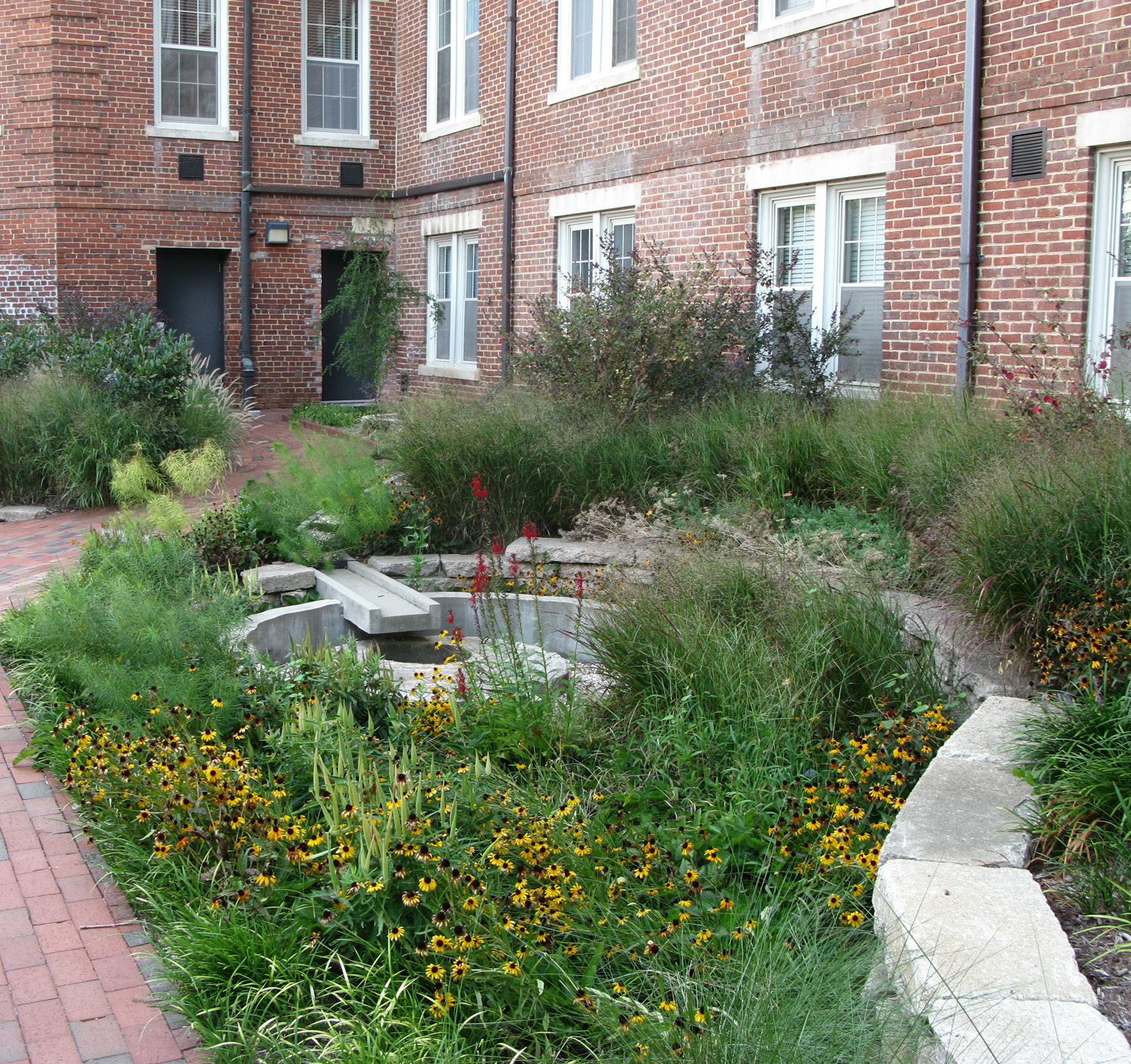
The new guidelines give engineers and landscape architects more choices and will increase demand for green infrastructure plants from regional nurseries. Last month, we highlighted these updates to the manual in our blog post, More Plants for Stormwater Projects. To see the fully updated lists, visit the NC Stormwater Design Manual webpage.
Hoffman Nursery turned our shipping building into the 3rd Annual Hoffman Market for an afternoon. From furniture to clothing, books to electronics, employees donated hundreds of items to the market. Instead of cash, everyone at Hoffman Nursery received “Hoffman Bucks” to spend. For every Hoffman Buck spent, the nursery pledged a real dollar to the Food Bank of Central and Eastern North Carolina. At the end of the day, we had $600 to donate to the Food Bank. The leftover books were given to a local library, and rest of the unsold items were donated to TROSA, a residential, substance abuse recovery program in Durham, North Carolina.
Check out a few photos of our fun-filled afternoon below. A huge thank you to those who donated items and who helped organize the market. It was a great day for the nursery and our community.












North Carolina’s stormwater design manual gives technical guidance to professionals on stormwater control measures (SCM). SCM are structures that treat and manage the water that runs off parking lots, roof tops, and other impermeable surfaces during and after a rain event.

Green stormwater infrastructure measures like bioretention cells and stormwater wetlands use plants, soils, and natural systems to slow and collect runoff, filter out pollutants, and increase water infiltration.
In North Carolina, the individuals who design these green SCM tend to stick to plants listed in the state’s stormwater design manual. In many cases, the designers are engineers or landscape architects who have little or no familiarity with the plants. As one stormwater engineers told us, “I just pick plants off the list in the manual.” Otherwise, they believe they run the risk of their design not getting approval from the state.
Until recently, the plant choices in the manual were limited. For bioretention cells, there were eight tree species, 22 shrub species, and 26 herbaceous perennial species. There were similarly short lists for stormwater wetlands, another SCM that relies heavily on plants. The limited palette made it difficult to create diverse and attractive plantings. It also made it unlikely designers would use other plants that were appropriate for the projects if the plants weren’t listed in the manual.
In 2016, the NC Stormwater Program began revising the design manual at the behest of the state legislature. Debbie Hamrick, a green industry veteran and advocate for green infrastructure, saw an opportunity. She approached Annette Lucas, the NC Stormwater Program Supervisor, and helped her understand the limitations of the plant lists. Lucas welcomed the input and was very open to bringing in outside experts to review the plant information.

In a series of meetings in 2017, a group of nursery and green industry professionals worked with Annette Lucas and members of NC State’s Stormwater Engineering Group. They reviewed sections of the manual that pertained to plant material and made suggestions for changes. The guidelines for bioretention cells and stormwater wetlands received the most attention, as they are the most plant-heavy SCM in the manual.
Hoffman Nursery participated in the design manual review group and helped expand the recommended planting lists. We were already growing many grasses and sedges that would be appropriate—they just had not been included in the manual up to then. The revisions also included clarifications. For example, earlier plant lists included, “Carex spp.” With hundreds of Carex species native to North Carolina, that guidance wasn’t particularly helpful. In the case of bioretention cells, we specified 15 Carex species that will perform well.

The group’s input more than doubled the number of tree, shrub, and herbaceous plant species on the lists. The revisions added information on which plants provide support for birds and pollinators and updated guidelines on installation and plant specifications. The revisions have given engineers, landscape architects, and SCM designers better information and more choices. State officials expect it to improve the functionality and appearance of SCM in the state. We also hope it will increase demand for green infrastructure plants regionally.

To see which grasses, sedges, and rushes are in the NC Stormwater Design Manual and which ones we grow, download our PDFs:
To see the full lists, go to the NC Stormwater Design Manual webpage.

Our 2018-2019 Catalog of Grasses focuses on collaborations within and outside the green industry. In this post, we continue our collaboration profile series with Dr. Joseph (Joe) Neal.

Dr. Joe Neal spends a lot of time thinking about weeds. He is a Professor of Weed Science and Extension Leader for weed management in landscapes and nursery crops in the Department of Horticultural Science at NC State University. He earned a Ph.D. in Weed Science from NC State University in 1984. After spending 12 years at Cornell University watching weeds freeze in upstate New York, Dr. Neal joined the faculty at NC State in 1996. His research and extension programs emphasize the development of cost-effective weed management solutions for nursery and landscape professionals.
Working with research scientists and cooperative extension faculty helps us stay up-to-date with what’s going on in horticultural research. Dr. Neal’s research includes finding safer and better weed-control methods in nursery stock. There are only a few products listed for use with container-grown grasses. Working with Dr. Neal and his team, we hope to expand the options available for us and our customers.
Dr. Joe Neal on why this collaboration is important:
“Hoffman Nursery’s support and input has been vital to our research program. Partnering with industry helps us develop technologies that are targeted and effective. We’re translating knowledge into practical applications that benefit industry and improve the economy.”
We are big fans of Halloween here at Hoffman Nursery because it means we get to have our annual costume and pumpkin carving contests. Our employees definitely joined in the spirit of all things fun and creative this year and showed off their awesome costumes and pumpkins during our Halloween Party. The judges didn’t have an easy decision as all the submissions were amazing. They pondered long and hard while everyone enjoyed a catered lunch from Backyard Bistro. Check out the photos below to see this year’s entries and winners!

From furry friends to fruit, here are our awesome costume contest entries

and our wonderful pumpkin carvers

Lunch was enjoyed by all while the judges made their decisions.


John prepares to announce the winners…
This year’s costume winners are:

3rd Place - Alex (Crazy Cat Lady) from Marketing
2nd Place - Shannon (Bunch of Grapes) from Marketing
1st Place - Tucker (Forklift) from Accounts Payable
And as for the pumpkins…

Funniest pumpkin - Joe from Senior Management

Scariest Pumpkin - Ethan from the Growing Department

Most Creative - Leticia from Production
Thanks for tuning in and have a Happy Halloween!

Our 2018-2019 Catalog of Grasses focuses on collaborations within and outside the green industry. In this post, we continue our collaboration profile series with influential Dutch garden designer, Piet Oudolf.
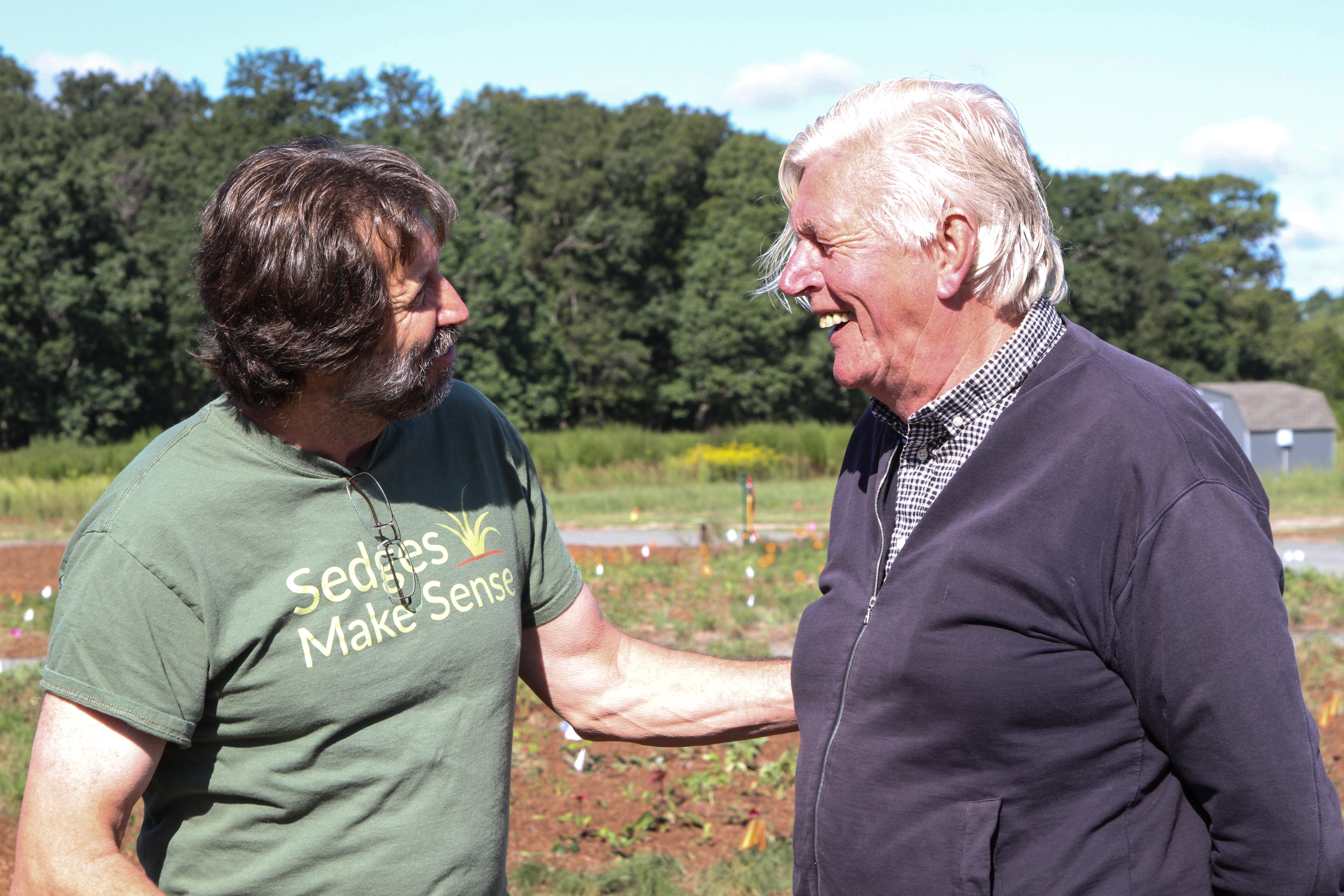
Oudolf is a leading figure in the “New Perennial” movement, and his projects have helped fuel the popularity of grasses. With a vast and intimate knowledge of plants, Oudolf selects each plant he uses with care and precision. Our customers will benefit from his expertise as we work with him to bring new grasses to the U.S. market. It starts with the introduction of Panicum virgatum ‘Purple Tears’, a Switchgrass selected from his garden.

Panicum virgatum ‘Purple Tears’ is destined to be a classic. Oudolf discovered this delightful selection of our native species in a nursery plot in Hummelo, Netherlands. It bears flowering spikes with soft gray color at the top, followed by splendid, purple seed heads. With a manageable height of 4’, its narrow, upright habit make it perfect for a range of landscape applications. It has the same toughness and adaptability you’ll find in other Switchgrass cultivars. We are thrilled to be able to offer our customers one of Piet’s picks with Panicum virgatum ‘Purple Tears’.
According to Oudolf, the collaboration with Hoffman Nursery made sense:
“I wanted to bring some of my favorite grasses to the U.S. market. Hoffman Nursery’s production expertise and familiarity with the plants made this collaboration a natural fit. When designers and nurseries work together, our clients and their customers get better plants.”

Our 2018-2019 Catalog of Grasses focuses on collaborations within and outside the green industry. Working with others offers our team opportunities to learn and share information. It’s where we often get new insights and innovations. In this post, we continue our collaboration profile series with Dr. Richard T. Olsen.

As the Director of the United States National Arboretum, Dr. Olsen is a recognized leader in the public garden arena. He holds advanced degrees in horticultural science from the University of Georgia and North Carolina State University and has contributed his scientific expertise and practical knowledge to the horticulture industry for many years. That fits the mission of the U.S. National Arboretum, which is to enhance the economic, environmental, and aesthetic value of ornamental and landscape plants.
Dr. Olsen and his team seek out and develop new plant selections. Our newest sedge, Carex scaposa, came to us via one of Dr. Olsen’s visits to China. He brought it back from the Kunming Botanical Garden in Yunnan Province. This Carex is native to streamsides and slopes in southern China and Vietnam. Dr. Olsen says he had never seen a clump of Carex with such a wide leaf, and the pink, showy flowers make it even better.

We’re grateful to Dr. Olsen and the U.S. National Arboretum for their contributions to the industry. To help continue their exploration and conservation efforts, $0.10 from every Carex scaposa we sell will be donated to the U.S. National Arboretum. Working with them to bring new plants to the market maximizes industry resources and gives our customers better choices.
Dr. Olsen values the collaboration as well:
“The arboretum’s process of scientific discovery directly benefits industry when we coordinate efforts. Working with Hoffman Nursery gives us a conduit for getting new and better plants into the industry. Partnerships like these keep us connected and help shape future efforts.”
Get Current Availability: Excel Download |PDF Download